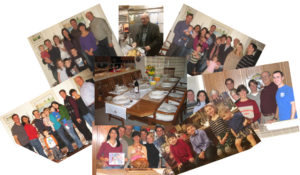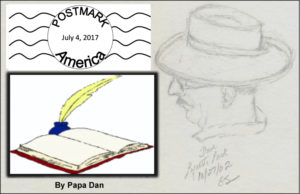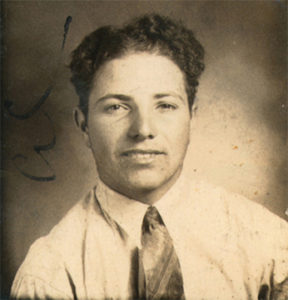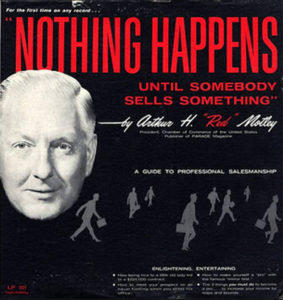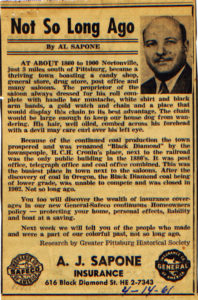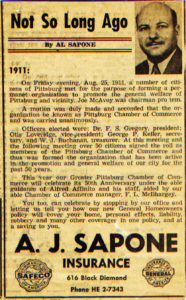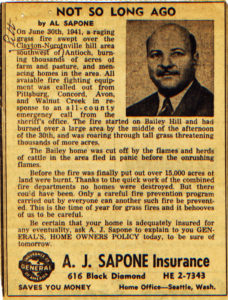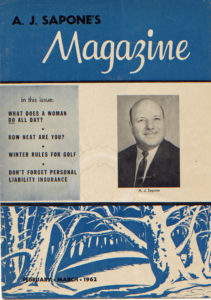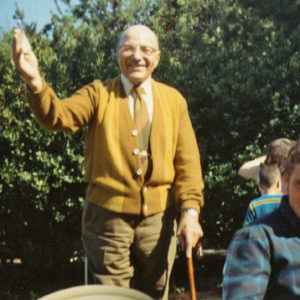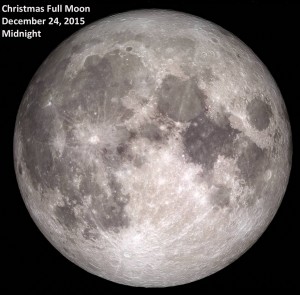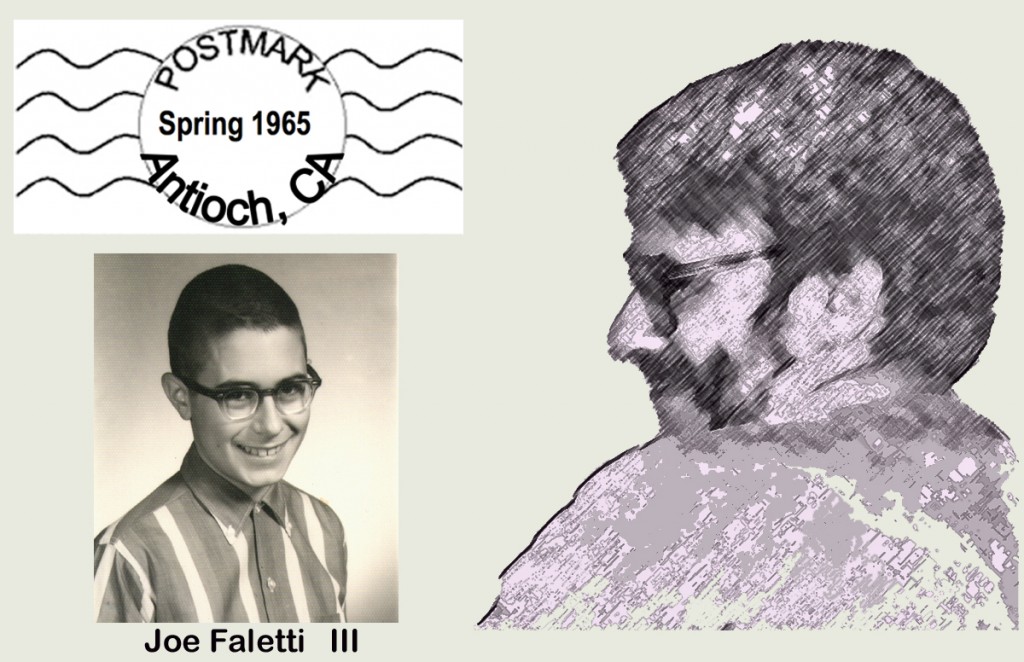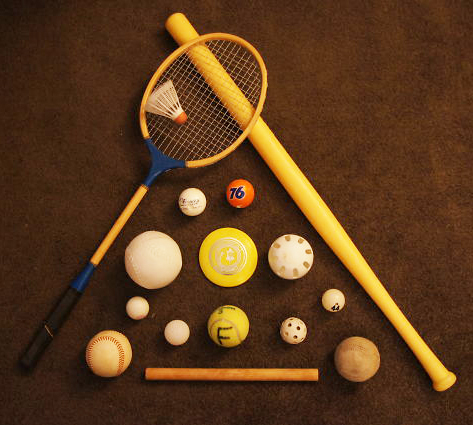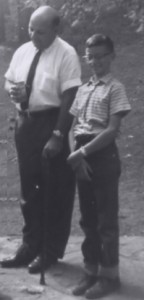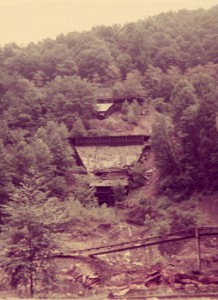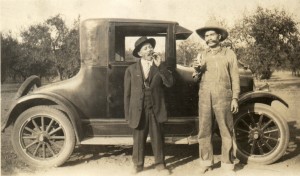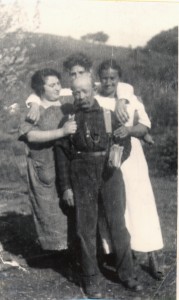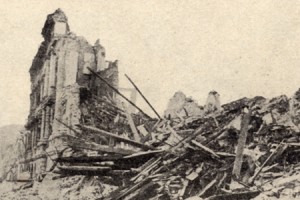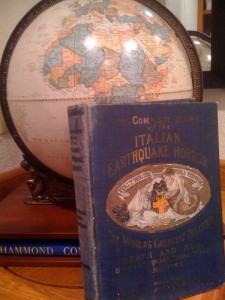Archive for Who We Are
To Witness the Miracle
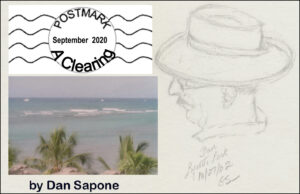
“We are here to witness the miracle.”
— Ray Bradbury
“So, what’s it all about?”
— An American college student in Florence
Since this year, 2020, has not been kind
to travelers (or anyone really); some of us
who have enjoyed the pleasures of travel,
pleasures that have been denied to us
during this COVID year, might want to remind ourselves
of some ideas that emerge from an important question.
= = = = = = = = = = = = = = = = = = = = = = = = = = = = = = = = = = = = = = = = =
Why Travel?
Kappa’a, Kaua’I, Hawaii — A taxi to the BART station, a train to the airport, a series of hurry-up-and-wait movements, and we find ourselves on an airplane, seatbelt buckled, ready to go. Hours later, a smooth landing, more rolling through another airport, a taxi, and a hotel — and here we are! A comfortable place to sit, a glass of wine overlooking the ocean, this was clearly a good idea. No question about it.
We have arrived. Now what? What exactly am I looking at? What should I think about?
— • —
A Clearing
In the 1950s, philosopher Martin Heidegger suggested that, if you can clear away all of the ‘stuff’ that you carry with you that clutters up your life, what emerges from that clearing will help clarify the world around you. He called it (among other things) “truth.” That sounded useful; so, I tried to do that — to make such a clearing — since, here on a beach on an island in the Pacific Ocean, I seemed to be in a place conducive to the making of clearings.
We were sitting at a small patio on the edge of the northern-most Hawaiian island: Kauai. Looking out at that vast ocean, it is easy to let go of things that usually clutter up your mind. The “clearing” that remains offers a lot of room for large ideas to appear, and even a few small ones.
So, what shows up in that clearing?
Surprisingly, the ideas that emerge are not complicated, but simple observations that might be obscured by the details we think about on “normal” days in more familiar places. OK, like what? Well, as I look out to sea, the scene is dominated by one thing: the horizon, just a line, really. I notice that there are no straight lines in this scene, just this one decidedly curved one. No doubt about it, the left and right “ends” of this line that forms the horizon are clearly lower than its midpoint. There can be no question that the complete object, of which this piece of horizon is a part, is not flat.
This observation argues clearly and simply for a round earth. OK, so the earth is round.
That was easy.
Since this “fact” is a relatively new one in human history, I marvel at the power of whatever must have cluttered up the minds of people only five hundred years ago that could have obscured the simple observation that emerges from the clearing I see here. Did nobody notice in all of generations that have walked the earth that the only truly straight lines in existence were man-made? Amazing! And to think that sitting here at the edge of this island made this historic piece of knowledge obvious — a round earth — knowledge that had escaped so many smart people for so long.
Setting aside my amazement for a moment, all the other wonders and beauties we can observe on this island lead eventually to other questions not as easily answered. They are not so much questions about the natural beauty we see around us, but … something else.
OK, so anyone who has tried to ask the “Why?” question knows that it’s never quite that simple. “Why what?” What are you really asking? Why is it round? Why does the water move the way it does? Why does the land occasionally rise above it? The “Why?” questions continue until you stop to consider that there is a question at the root of all of them:
“Why am I here making these observations and asking these questions?”
Of the many humans who have ventured an answer, one writer has held my attention for some time. On the day Neil Armstrong first walked on the moon, science fiction writer Ray Bradbury answered that question for Walter Cronkite: “We are here to witness the miracle,” he said.
–> We are here to witness the miracle. <–
Lots of writers have offered the opposite view that we human beings ARE the miracle — that all of creation has had the primary purpose of bringing human life to this planet. Bradbury’s very different view begs three further questions:
One: If WE are not “the miracle,” then what exactly IS the miracle?
Two: Why does the miracle need a witness?
and, of special interest to artists and writers,
Three: What are the responsibilities of beings created to witness to such a miracle?
While seeking answers to the large questions that emerge from ‘clearings,’ one might ask a smaller one: –> Where does one go to get a closer look at such a miracle?
So, we travel in search of it.
Writers have been telling us that for a long time, and they’ve identified different kinds of miracles. Thornton Wilder has a character who explains that for us in his play Our Town — and she was a character who spent a lifetime without ever leaving Grovers Corners. She observed: “It seems to me that once in your life before you die you ought to go see a country where they don’t talk in English and don’t even want to.” And why is that worth anything? Mark Twain answered this way: “Travel is fatal to prejudice, bigotry, and narrow-mindedness.” And he went on to say, “…nothing so liberalizes a man and expands the kindly instincts that nature put in him as travel and contact with many kinds of people. Broad, wholesome, charitable views of men and things cannot be acquired by vegetating in one little corner of the earth all one’s lifetime.” When faced with a contrary argument, Twain got specific in his book of travel stories, Innocents Abroad: “The gentle reader will never, never know what a consummate ass he can become until he goes abroad. I speak now, of course, in the supposition that the gentle reader has not been abroad, and therefore is not already a consummate ass. If the case be otherwise, I beg his pardon and extend to him the cordial hand of fellowship and call him brother.”
Back to “The Clearing”
If travel is a way of making ‘clearings,’ maybe Heidegger’s “truth” is too large a treasure to expect to find in any single clearing. Maybe the grand moments we expect — like standing before Brunelleschi’s dome in Florence or staring up at the ceiling of the Sistine Chapel in Rome — maybe they are not the most significant of the ‘humanizing’ moments that Twain spoke of. Perhaps more important are the small moments of connection that, when strung together, can add up to ‘truth,’ or some approximation of it. Maybe they can consist of fleeting moments that flash brightly and are then gone. Looking back on our years of travel, some examples emerge.
Humanizing Moments
I recall a weekday night during our first visit to Florence in 2001, we walked around the corner and dropped into a small neighborhood restaurant for dinner – Nello’s. It wasn’t busy, so we struck up a lively conversation with the waiter, who identified himself as “one of the owners.” He answered our touristy questions about Florence and we answered his about San Francisco. We talked about what it was like to live in these two similar places spread so far across the world. He spent a lot of time with us and, near the end of the evening he brought three glassed and we sipped Amarone together for a while before we left. It was delightful. We felt we had made a ‘connection’ with a ‘local’ and it felt good.
When it came time to find a place for dinner on the weekend, we remembered the nice time we had on Tuesday and decided to go back to Nello’s. What the heck, maybe that same guy will be there. That could be fun. So we did.
This time, a Friday night, a tour bus had unloaded and the place was jammed. The same guy was there again, but he was so busy we barely got a glimpse of him. We were lucky to get a table for two in the corner. We greeted him warmly and hoped for a moment of recognition but there was none. Were we ready to order? he asked. I mentioned that Gretta and I had spent the afternoon at Il Academia, which we had talked about with him on Tuesday, but he simply asked, “Some wine?” He took our wine order and left without a nod of recognition. We wondered, had we offended him? What happened to the ‘connection’ we thought we had made? Over the course of the meal, looks passed between us and the waiter indicating that something seemed missing but nothing was said. We decided, he’s just too busy. So, we lingered over dinner and waited until the ‘tourists’ had mostly cleared out. When he noticed that we were still here, he finally came over to us and asked if there would be something more. I tried again to engage him in conversation and commented, “this place is quite different when the tour bus unloads, eh? It was really quiet on Tuesday.” He said, “If you were here on Tuesday, you met my identical twin brother.” He and I looked at each other for a long moment and realized what had been missing. He smiled. “Oh, so we HAVE met. Or so it seemed.”
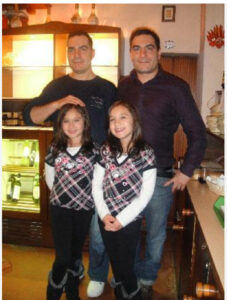
Yes, another connection.
Twin brothers at Nello’s in Florence
Such connections can happen in surprising places. One foggy Spring day, on our last day in London in 2003, we got all dressed up to have “High Tea” at the world-famous Savoy. I wore my best Fedora — a “Sinatra-esque” hat like the one my Father wore when he wanted to look dignified. In the restroom of all places, a distinguished-looking gentleman, dressed in a three-piece suit was standing at attention in his role as the restroom attendant. When he handed me a towel, I asked him with mock gravity, which he seemed to understand, “Tell me, sir, is mine the only Fedora in all of London?”
Yes, sir,” he replied returning my serious expression.
“So, does that mean that all of my efforts to bring Fedoras back into fashion have failed?”
“Yes, sir.”
The momentary grin we exchanged as I tipped my hat to go and dropped a few bills in his jar was worth every bit of the price of afternoon tea at the Savoy.
Finally, on a sunny day in Paris, we were sitting at a shady spot overlooking the Luxembourg Gardens. Gretta was drawing the scene of Parisians enjoying one of their unique spots of civic beauty and I was sitting with my notebook, trying to look like a writer. An older couple walked up and leaned on the stone wall in front of us and we struck up a conversation. They showed an interest in what we were doing — “Gretta paints with watercolors,” I said, stating the obvious.
“And you are a writer?” she asked, pointing at my notebook.
“Oui,” I grinned.
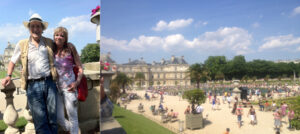
As if in reply, she said, “Let me tell you a story.”
So, sensing an opportunity, I pointed my iPhone and pushed the record button, surreptitiously, I thought. Turns out that they had met as teenagers here in Paris a very long time ago, fell in love, but went the separate ways that life took them — he to the army and she to marriage and children. After many years she returned to Paris — now a widow — and, at the suggestion of her grown son, looked him up on Facebook. And now, here they are, they live in Paris together, where they belong, and were clearly celebrating that fact. As she told her story, the gentleman and I exchanged glances at each other and at my iPhone and he nodded approval. When she was done, I said, “With your permission … “ and I gestured to the iPhone to admit my intrusion. She interrupted me, “Yes, I noticed. It’s a good story, isn’t it? Perhaps you’ll write it down.” We bid each other good day and they were off.
A good story.
The small moments of connection never seem to stop, if you look for them: a woman from the East Bay we met on a boat on Lake Annecy … a bottle of homemade wine gifted to us at the end of a stay at Pomerlo Vecchio in Umbria … an American college student in the Academia in Florence, looking up at Michelangelo’s David, who asked me, “This David is supposed to be a big deal. What’s it all about?”
So, I told him a story that had been told to me — about an inspiring mythical character and a story told in stone by a sculptor more than 500 years ago — “and here we are still looking at it with admiration.” I think he “got it.”
There are many small miracles to witness when clearings are made.
![]()
Falling Down
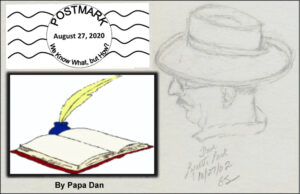
Let’s take a look at an old joke,
an old, crude and insensitive little joke,
and see if it applies to a current feature
of our American Democracy.
Falling_down_FINAL_BREL_Aug272020
= = = = = = = = = = = = = = = = = = = = = = = = = = = = = = = = = = = = = =
An Announcement
The scene is a large office building — the headquarters of a large national corporation. We see one, wide, uninterrupted floor of this office building containing several dozen cubicles and desks where people are working at their jobs. A voice comes over a loudspeaker and fills the room:
“Ladies and gentlemen, may I have your attention please? It has come to the attention of management that some employees who are dying on the job are failing to fall down. As a result, given the nature of our workforce, it has become difficult for management to distinguish between employees who have died and those who are still working. Therefore, beginning immediately, employees who die on the job are instructed to fall down. This action will contribute significantly to our ability to assess our productivity and make necessary management decisions. Thank you. That is all.”
Applying the “Joke”
So, what does this rude and insensitive little story, have to do with the state of our American Democracy?
Since the early history of our “great American experiment in democracy,” the United States of America has organized itself into political parties. The Founders did not intend it to be so — parties are not mentioned in Hamilton’s “Federalist Papers” nor in the Constitution — but it happened anyway. They haven’t always been the same parties — some parties have come and gone as they became irrelevant (remember the Whigs and the Tories?); some have changed their names (recall the “Federalists” and the “Democratic Republicans?”); and throughout our history some citizens have declared themselves to be independent of those parties. But over my lifetime, American politics and government have been structured predominately by two competing political parties that have populated most of the positions of power and influence in our national decision-making. One is called The Democratic Party and the other is called The Republican Party. Both parties have long stood for a common set of values, broadly recognizable as American values, as initiated by the Founders, values that have kept the nation together over the past century or so since the Civil War. In that respect, the two parties have a lot of historic similarities. The differences between those parties have largely centered on the policies and strategies they have preferred in pursuit of those values. Most often, national decisions have been made with more-or-less respectful debate, persuasion based on regional interests, compromise (only possible because of the common values I mentioned), and voting.
Today in America, however, the party that calls itself The Republican Party has died. It has died, but it has failed to fall down. As a result, there are still large numbers of citizens who believe that The Republican Party still exists. But it does not. It has died.
Growing up, I accepted my father’s assertion that “We are Roosevelt/Kennedy Democrats”— and I still do. However, well into my thirties, he and I knew and respected a number of Republicans. For them, if they are still alive and remember, their party has died. There was no funeral and some Americans mistakenly believe that it still lives.
OK, so that is a dramatic assertion, which some may not accept. I understand that. So, how do we test that assertion? How does a person notice that The Republican Party has died? All my life, certainly since I was in high school, the Republican Party has stood for at least these 7 consistent values:
1. preserving American institutions,
2. supporting fiscal conservatism, defined as a federal budget balanced between income and expenditures (i.e., opposition to “deficit spending”),
3. supporting small business (evident in consistent support for local Chambers of Commerce),
4. maintaining strong international alliances in support of global economic strength and American foreign policy objectives like reciprocal trade and fierce opposition to foreign dictators (especially those in Communist Countries) all in support of international peace and stability,
5. basing policy decisions on science and academic excellence by supporting and consulting experts,
6. supporting reliable safety-net programs to ensure a minimum, decent standard of living for Americans
7. actively promoting the value of common sense.
Those have been the fundamental values of the Republican Party since I was in high school, as confirmed repeatedly by spokespersons for that party. Those have long been called “Conservative” values. An observer will notice that those who claim to speak for the Republican Party today no longer stand for those values. Consider these observations on those topics — members of the Republican Party have advocated for the following things in very recent years:
1. They have worked very hard to diminish the effectiveness and credibility of long-standing government institutions such as the Justice Department and immigration authorities, criticized “so-called judges” of the federal courts who have ruled against Republican policy decisions, and depleted the ranks of long-standing institutions that have provided policy stability such as the State Department, Environmental Protection Agency, Postal Service, and Department of Energy.
2. They have proudly and repeatedly handed out large tax cuts for the wealthy blatantly causing budget deficits.
3. They have openly supported interests of the largest corporations, knowingly endangering the viability of small businesses, with tax policy and a willingness to renege on legitimate debts and agreements.
4. The current Republican Administration has repeatedly demonstrated deference and support for foreign dictators (e.g., Russia) who have shown a disregard for established national boundaries and attempted to undermine American elections. Republicans have resisted efforts to defend against those threats, undermining investigations and weakening alliances the nation has relied on for decades.
5. They have rejected science, denying well-established scientific knowledge like the effects of our energy choices on destructive changes in the global climate — actually subsidizing corporate polluters! Under the current Republican administration, America is the only nation to withdraw from the Paris Global Climate Agreement.
6. They have slashed long-standing safety-net programs, cast dozens of votes attempting to take away health insurance from ordinary Americans, resisting and demeaning long-standing progress in the rights of women, and unravelling campaign finance regulations to give billionaires outsized influence over all government decision-making, while systemically attacking voting rights to make it harder for the young people, minorities, and the poor to vote.
7. They have thrown common sense to the winds by embracing wild conspiracy theories, like the health threat from windmills, widespread voter fraud, the fabrication of climate change by the Chinese, the credibility of certain birth certificates, (and more), despite public evidence to the contrary.
As former President Obama summarized in a speech in 2018, this Republican behavior is “not conservative. It sure isn’t normal. It’s radical. It’s a vision that says the protection of ‘our’ power and those who support ‘our’ party is all that matters, even when it hurts the country. It’s a vision that says the few who can afford a high-priced lobbyist and unlimited campaign contributions set the agenda. And over the past two years, this vision is now nearing its logical conclusion.”
The conservatism that guided the Republican Party of my youth is gone. Yes, the Republican Party has died. Believe it or not, the seeds of that death were planted during the first term of the Reagan administration (check out his huge budget deficits: $195 billion in 1983, $180 billion in 1984 – look it up). Reagan’s “Conservative” administration also undid restrictions on Saving and Loan institutions, leading directly to the S & L crisis and slashed federal mental health funding precipitating today’s homeless problem.
So, what has replaced this now-deceased political party? Those who currently call themselves Republicans have embraced the politics of “resentment, division, and paranoia” instead of what we used to understand to be “conservatism.” Fiscal conservatism, of course, has become an often-invoked myth. The values to be preserved are power and influence.
What To Do
The dead-but-still-standing Republican Party, needs to be replaced by a large group of people who have a genuine interest in governing. I suppose, the problem could be described simply as a vocabulary issue. It seems that Republicans no longer understand the word “govern” to be a verb — that is, something that you DO. For some time, they have only recognized the word “government” — a noun that they utter bitterly as if it were a cuss word, pronounced either before or after spitting, as in “government regulation, ptieuuw!” They failed to learn (it was in the fifth grade), that the phrase “government regulation,” was one of the central purposes of government, as established by the Founders, to protect citizens against threats that they cannot fight individually. Over thousands of years, that phrase, “government regulation,” has been the single dominant characteristic that has distinguished uncivilized disorderly collections of people from what historians and anthropologists call “civilization.” To answer the “what to do” question, there are three steps (there are always three):
Step One: the election of 2020 — A large Democratic Majority must be elected in both houses of Congress and in State Legislatures and City Councils across the country to replace the mythical and deceased, Republican Party of old. This must be accompanied by restoration of confidence in the integrity of elections — an effort to be pursued in parallel with Step One.
Step Two: A Democratic President must be elected in 2020 while simultaneously preserving and expanding the Democratic majority mentioned in Step One. Then, the challenge will still be immense. There will be a lot of damage to repair from years of cowardly fake conservatism (known as “Trumpism”) and the weak national response to Trumpism that made it possible.
Step Three: The utter completeness of the Republican defeat must be accompanied by a movement to re-establish traditional conservatism as the bedrock of a new party with a new name — how about “The Grand New Party.” That party needs to sit down across a table with Democrats and re-engage in the business of governing. They need to reassert a set of values that would be recognizably American and taught in public schools (well-funded public schools, by then) as principles we can all pursue together with our own regional flavors. Oh, by the way, elected representatives of the Democratic Party need to be rejuvenated (OK, replaced) with folks with a commitment to the future in addition to their commitment to the values of the past. If you want to read that to mean “replaced by younger folks,” go ahead.
So, our question: Can all this be done in this generation?
My answer: Nope. Clearly, my generation (the “Post-War Baby Boom”) has had its chance to make a difference and gets mixed reviews. We made some progress in the 1960s, but my generation also brought us all some pretty awful outcomes, in spite of a handful of promising leaders. So, my answer is No. Given who we are, collectively, and HOW we have been approaching this problem, it’s not going to happen. But I suppose we can start with Step One and Step Two today, so my grandchildren’s children can have a place to start.
But Wait —
We described a serious problem and proposed a challenging “What To DO” to solve it. BUT, in assessing whether we can accomplish that goal anytime soon, is it possible that we have left out the most important question:
How?
Maybe it will take a dramatic, but simple, answer. Can we supply the simple human ingredient that has been missing from our politics and governance? Maybe that answer can come from a song from the 1960s (OK, an approach my generation has offered many times). Here it comes –
the climactic final song from an important musical from the late 1960s, which I had the privilege of seeing on the stage twice: “Jacques Brel Is Alive and Well and Living In Paris.” Translated from the French by Eric Blau and Mort Shuman, the lyrics (below), offer a solution. Sounds simple. Take a look at the lyrics and consider whether it is useful here in the 21st century. If we only …
If We Only Have Love
If we only have love
Then tomorrow will dawn
And the days of our years
Will rise on that morn.
If we only have love
To embrace without fears
We will kiss with our eyes
We will sleep without tears.
If we only have love
With our arms open wide
Then the young and the old
Will stand at our side.
If we only have love
Love that’s falling like rain
Then the parched desert earth
Will grow green again.
If we only have love
For the hymn that we shout
For the song that we sing
Then we’ll have a way out.
If we only have love
We can reach those in pain
We can heal all our wounds
We can use our own names.
If we only have love
We can melt all the guns
And then give the new world
To our daughters and sons.
If we only have love
Then Jerusalem stands
And then death has no shadow
There are no foreign lands.
If we only have love
We will never bow down
We’ll be tall as the pines
Neither heroes nor clowns.
If we only have love
Then we’ll only be men
And we’ll drink from the Grail
To be born once again.
Then with nothing at all
But the little we are
We’ll have conquered all time
All space, the sun, and the stars.
— 1968 — Original soundtrack audio: https://www.youtube.com/watch?v=M9ILw3D5yrU
![]()
Shelter

“So be the change, so be the shelter.”
— Danny Burke and Marieme Diop
“Screw This Virus”
— David Brooks
“It is not enough to help the feeble up,
But to support them after.”
— William Shakespeare
(Today: April 23, is honored as his birthday)
To download a PDF of this post, click here: Shelter_ConVivio_Apr23_2020
= = = = = = = = = = = = = = = = = = = = = = = = = = = = = = = = = = = = = = = = =
The word “Shelter” is at the forefront of America’s thinking these days. California was among the first states to implement a “Shelter In Place” strategy for everyone who is not performing “essential” duties. As the virus has become more pervasive and deadlier, state governors have filled the leadership void left by … well … you-know-who. So, today, with advice from the World Health Organization (WHO), “Shelter In Place” is what passes for the “American Way of Life” — at least for now, and for most of us. Of course, “Commander Chaos” (“He Who Must Not Be Named”) has defunded and demeaned the WHO for those who are listening to him and encouraged people to resist the shelter-in-place regulations that most governors have imposed. While the President wants to “open up the economy,” most individual states and counties are strengthening “shelter” policies and have begun requiring the wearing of masks outside the home. It is clear that opening up the economy prematurely will directly cause a predictable number of deaths. This morning, 75% of the American people support “Shelter In Place” regulations and only 11% do not. As we lift our eyes to the horizon, we can see that much of the rest of the world has been “Sheltering” for some time now with strong regulations.
Of course, buried in that approach to “Sheltering” is the need to define what is “essential.” Which workers should be considered sufficiently “essential” to continue working outside the home? The consensus on that definition has settled broadly on health-care professionals, first responders, and workers providing services and products (like food, medicine, fuel, etc.) that keep civilization operating. Those professions are considered sufficiently ‘essential’ to go to work. They don’t GET Shelter — they make Shelter possible for others.
So, for the vast majority of us, this new way of life means simply: “Stay Home.” for an unknown number of days … weeks … months … Sounds simple, eh? And yet it ISN’T simple at all.
Staying home
Staying Home, of course, means not going to work, not going to school, and staying away from (or at least distant from) people who don’t live in your home. It means at least three things:
1. Not going to work: Here in the 21st century, America employs the largest number of people in history — our ‘work force’ is about 165 million. While that sounds powerfully prosperous, it also means that this record number of people have been relying on those paychecks to buy food, pay bills, and keep a roof over their heads. So, NOT going to work is NOT simple.
By contrast, here in April of 2020, more people are UNemployed than at any time in our history. Nearly 20 million Americans have filed for unemployment benefits in the past three weeks alone. Some economists warn that, next month, the unemployment rate could reach as high as 15% — a number that could add up to about 25 million people. That’s a lot of rent payments, utility bills, mortgage payments, and groceries. We tend to compare hard times to the depression of the 1930s when unemployment reached 24.9% of the workforce. In 1935, that added up to “ONLY” about 15 million people. Today’s unemployment, though a smaller percentage, has a much greater effect.
2. Staying home from school: This year, more than 56 million students attend school (elementary, middle, and high school) in America. According to the Bureau of Labor Statistics, nearly 62% of American households have two working parents (not including working single parents). While some number of parents will have the opportunity to ‘work from home,’ the whole picture of parents and students not going where they usually go, every day, is a gigantic disruption for millions of families. So, “Shelter in place” is a two-edged strategy: many parents will not be earning a living during the “Shelter” strategy and their children will not be attending school. If they are all home, well, at least there is not a day-care expense, right? AND they will be avoiding contacts that can expose them to the virus. But nobody would agree that is a solved problem.
3. Providing food for yourself and your family: Again, this cuts two ways: many families will come close to running out of cash to buy food if they are not working AND they must solve the problem of going out into the world to the grocery store if they do have the money.
–> –> How Do We FEEL About it All?
The stress of this widespread disruption is new for most of us who were not alive during the Great Depression of the 1930s. While America has had economic downturns and recessions every couple of decades, this is a new level of disruption. History tells us that how we feel about it often influences how well we survive. People react to the stress of disruption in many different ways. Over time, our writers and thinkers have provided words that have been thought-provoking and — sometimes — help us to find comfort, and sometimes even solutions. If we are collectively, as a civilization, forced to save ourselves by taking shelter, let’s look at a random collection of words that have been offered for the specific purpose of managing how we feel about adversity. Historically, we might ask: what effect have our writers had on widespread hard times — AND have our writers been helpful? Let’s see.
•• Pierre Teilhard de Chardin offered his thoughts about how to respond to adversity:
— “In the final analysis, the questions of why bad things happen to good people transmutes itself into some very different questions, no longer asking why something happened, but asking how we will respond, what we intend to do now that it happened.”
•• David Brooks often takes a philosophical approach to consider what it takes to be human during difficult times. Here, his New York Times column titled “Screw This Virus” acknowledges the need for more than shelter, but the greater need for solidarity. He wrote:
“Solidarity is not a feeling; it’s an active virtue. It is out of solidarity, and not normal utilitarian logic, that George Marshall in “Saving Private Ryan” endangered a dozen lives to save just one. It’s solidarity that causes a Marine to risk his life dragging the body of his dead comrade from battle to be returned home. It’s out of solidarity that health care workers stay on their feet amid terror and fatigue. Some things you do not for yourself or another but for the common whole. …
It will require a tenacious solidarity from all of us to endure the months ahead. We’ll be stir-crazy, bored, desperate for normal human contact. But we’ll have to stay home for the common good. It’s an odd kind of heroism this crisis calls for. Those also serve who endure and wait. …
I wonder if there will be an enduring shift in consciousness after all this. All those tribal us-them stories don’t seem quite as germane right now. The most relevant unit of society at the moment is the entire human family.
•• Robert Christau wrote, in “Going Into the City”: “Nuts to the educational value of suffering.”
•• Alexandra Kostoulas, a writing teacher in San Francisco (Cary Sapone sent me her words) tells us of the responsibility of writers (like David Brooks) and other artists, to respond to difficult times:
“There is no time for despair, no place for self-pity, no need for silence, no room for fear. We speak, we write, we do language. That is how civilizations heal.” …
•• Cormac McCarthy wrote of the paralysis of deciding what to do in difficult times:
“Nobody wants to be here and nobody wants to leave.”
•• Ernest Hemingway described how he tried to recover from unhappiness and fear (albeit, in his case, with mixed personal results). From his novel A Moveable Feast:
— “As I ate the oysters with their strong taste of the sea and their faint metallic taste that the cold white wine washed away, leaving only the sea taste and the succulent texture, and as I drank their cold liquid from each shell and washed it down with the crisp taste of the wine, I lost the empty feeling and began to be happy and to make plans.”
–> –> And, On the Subject of Leadership in Difficult Times:
•• Abraham Lincoln spoke on this subject in a way that is relevant in today’s America— judging the character of people who are tasked to make decisions that affect other people:
“Nearly all men can stand adversity, but if you want to test a man’s character, give him power.”
•• Frida Ghitis, a world-affairs columnist, writes in response to leaders who waste their power by trying to solve the wrong problem: “The virus can be stopped by keeping it from spreading. That’s how we suffocate it. That’s how we reignite the economy. Trump’s wish to see the economy return to growth is shared by the American people. But the cause of the economic crisis is the virus. This is a cause-and-effect situation. To save the economy we need to stop the virus. Trump already tried to stop it by denying it was a problem. The new plan he is considering could prove just as ineffective and just as deadly. The decision on how to move forward should be left in the hands of the experts.”
•• Bryan Tracey — Another leadership question for our time: “Is a leader really successful?” Answer:
“Successful people are always looking for opportunities to help others. Unsuccessful people are always asking, What’s in it for me?”
•• Howard Beale reacted to the inadequacy of leadership in a famous scene from the movie “Network”:
“We’re mad as hell and we’re not going to take it anymore.” Will America react in this way?
•• Terry Goodkind writes about choosing between easy and difficult solutions to the challenges we face:
“If the road is easy, you’re likely going the wrong way.”
–> –> Across Centuries: An obvious Solution: Help Others. Be the “Shelter” for Someone Else
Here’s what a few of our writers have said about this highest priority of our time:
•• Charles Dickens (19th century) — “No one is useless in this world who lightens the burden of another.”
•• John Bunyan (17th century) — “You have not lived today until you have done something for someone who can never repay you.”
•• Shannon Alder (April 2020) — While Sheltering in place, can we still maintain our connection to others?
“One of the most important things you can do on this earth is to let people know they are not alone.”
•• Mother Teresa (20th century) — “Never worry about the numbers. Help one person at a time, and always start with the person nearest you.”
–> –> OK, So What about the Writers? Can the poets survive? Can They Help?
•• As reported recently in The Atlantic, William Shakespeare (today’s supposed to be his brthday) wrote some of his best works during the plague. In that article, Daniel Pelzner makes some insightful connections between our “plague” (coronavirus) and that one. He wrote, “As with everything that the coronavirus leaves in its wake, the suspension of operations by most major theaters around the country feels surreal.” The closing of theaters — happening today around the world — is not, a new phenomenon. He continued: “Whether theater provides an entertaining diversion from “the evening news” or might be the cause of further suffering, however, is a debate that goes back at least to Shakespeare’s day. Elizabethan theaters were frequently shuttered in London during outbreaks of the bubonic plague, which claimed nearly a third of the city’s population. The official rule was that once the death rate exceeded thirty per week, performances would be canceled. (As an infant, Shakespeare himself barely survived an outbreak that killed his older siblings.) Like New York’s governor Andrew Cuomo, who has banned gatherings of more than 500 people, London officials in the 16th century worried that people flocking to town to “see certayne stage plays” would be “close pestered together in small roomes,” creating the means “whereby great infeccion with the plague may rise and growe, to the great hynderaunce of the common wealth of this citty.” Shakespeare’s troupe, The King’s Men, had to rely on royal gifts and provincial tours to replace their lost box office. No such luck — so far — for our 21st-century theaters.
How was The Bard’s writing affected by the plague? It’s historians tell us that Shakespeare turned to writing poetry when — and because — the plague closed the theaters in 1593. That year he published his narrative poem, Venus and Adonis, in which the goddess begs a kiss from a beautiful boy, “to drive infection from the dangerous year.” Ironically (to our ears), the goddess claimed, “the plague is banish’d by thy breath.” Love poetry, it seems, could be spurred by the plague, and—in the fantasy of the time—even cure it. Maybe so — history suggests that another closure of theaters, in 1606, allowed Shakespeare, an actor and shareholder in The King’s Men, to do a lot of dramatic writing. While sitting out London’s early-17th -century version of “Shelter In Place,” Shakespeare wrote King Lear, Macbeth, and Antony and Cleopatra that year. Can we, today, make such lemonade out of this terrible lemon?
•• One modern poet, David Malouf (© 1992), wrote a few prophetic lines in a longer poem anticipating a modern plague:
“The sickness in this month is grown so general
no man can judge. It comes to this: we kill
our neighbours with the very prayers we sigh
to Heaven. O my Lord, spare me, spare me.”
–> –> Finally — Heroes of this time of Shelter: The Uniters
•• Andrew Cuomo, Governor of New York:
“And we’re going to get through it … because we are united, and when you are united, there is nothing you can’t do. And because … we are tough. You have to be tough. This place makes you tough. But it makes you tough in a good way. We’re going to make it because I love New York, and I love New York because … New York loves all of you. Black and white and brown and Asian and short and tall and gay and straight. New York loves everyone. That’s why I love New York. It always has, it always will. And at the end of the day, my friends, even if it is a long day, and this is a long day, love wins. Always. And it will win again through this virus. Thank you.”
•• California’s Governor Gavin Newsom is exerting significant leadership. He wants us to be steadfast, compassionate, and optimistic:
“Check in on loved ones; check in on your neighbors. Stay home. This is not a permanent state. This is a moment in time, and we will meet this moment together.”
–> –> Epilogue: Some “poets” shine a timeless light, from their own time, on times like these
•• Gwendolyn Brooks, “In the Mecca” 1968:
“One reason cats are happier than people
is that they have no newspapers.”
•• Joshua Ferris, “Then We Came to the End” 2007:
“Some days felt longer than other days. Some days felt like two whole days.”
•• Samuel Pepys, “Diary,” 1667:
“Lord! How sad a sight it is to see the streets empty of people.”
•• Barbara Pym, “Excellent Women” 1952:
“The burden of keeping three people in toilet paper seemed to me rather a heavy one.”
•• Michael Hofmann, interview in The Paris Review December 2014:
“One day someone will use the last surviving Latin word in English to say something like, This sucks.”
•• Stephen King, “The Stand” 1978:
“I’ve heard the saying “That sucks” for years without really being sure of what it meant.
Now I think I know.”
•• William Shakespeare, “Cymbeline” 1611:
“Nothing ill come near thee!”
•• Rita Dove, “Fiammetta Breaks Her Peace” April 12, 2020:
“All is infection, mother …
We shall sit quietly in this room,
and I think we’ll be spared.”
•• Flann O’Brien, “The Best of Myles” 1999:
“Do your friends shun you? Do people cross the street when they see you approaching?”
•• Ellen Bryan Voigt, “Kyrie” 1995:
“How we survived: we locked the doors and let nobody in.”
•• Clive James, “Latest Readings” 2015:
“If you don’t know the exact moment when the lights will go out, you might as well read until they do.”
•• Attributed to Charles Baudelaire 1860s:
“No restaurants? The means of consoling oneself: reading cookbooks.”
•• Kingsley Amis, “On Drink” 1972:
“Make up your mind to drink wine in quantity.”
•• Samuel Johnson, in James Boswell’s “The Life of Samuel Johnson” 1791:
“If you are solitary be not idle.”
And, finally, two of my favorites:
•• Attributed to Charles Lamb 1800-ish:
“The greatest pleasure I know, is to do a good action by stealth, and to have it found out by accident.”
•• Attributed to Edmund Burke (but really: John Stuart Mill 1867, and John F. Kennedy 1961):
“The only thing necessary for the triumph of evil is for good men to do nothing.”
![]()
The Vulcan Salute — Its Time Has Come
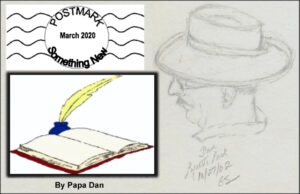
“Live long and prosper.”
“Logic is the beginning of wisdom,
not the end.”
— Mr. Spock
To download a PDF of this post, click here: ConVivio.Vulcan_Salute
===========================================================
The Vulcan Salute
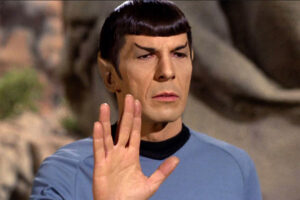
During the days when “Star Trek” was a popular TV show, Mr. Spock (Lieutenant Commander and Science Office of the Starship Enterprise) taught us the Vulcan Salute. In language, it translates to “Live long and prosper.” It was a friendly, respectful greeting that those of us from the 21st century might use in a way similar to our human handshake. So, given today’s reluctance to shake hands for sanitary reasons, it might be used to become a germ-resistant cultural replacement for that time-honored gesture.
Considering the source, Mr. Spock (played by actor Leonard Nimoy) had a dramatic backstory — he had a mixed Human-Vulcan heritage, he taught a number of respectful behaviors to his human colleagues. The character’s father was named Sarek, from the planet Vulcan, and his mother was Amanda Grayson, a human. Due to his mixed-race heritage, the young Spock character had a difficult childhood, bullied on his home planet by full-blooded Vulcan children who made fun of the human emotions he inherited from his human mother. He grew up alongside his half-brother, Sybok, who was eventually cast out for rejecting logic. Although Spock was accepted in the Vulcan Science Academy, he did not enter the academy because they would never fully accept someone who was only half Vulcan. Instead, he succeeded in entering Starfleet, while spending the next 18 years estrange from his Vulcan relatives.
The evolution of the character was interesting in that the network wasn’t pleased with the mixed-race feature of the character and often airbrushed out the pointed ears of the character in promotional photos. After the first season, a rift grew between the show’s creator, Gene Roddenberry, and Nimoy because the writing of the character deteriorated into brief expressions of “fascinating” and “logical”; and more complex interactions of the character with other characters, focusing on his unique racial heritage, were rejected by the network. However, the Vulcan Salute in today’s environment has a number of useful qualities to offer to us 21st-century humans.
Many aspects of Spock’s character endured in popular culture and the boundary between the character and the actor was eventually blurred and then erased. The character was adopted as an informal mascot by NASA and was incorporated into a number of literary successes by authors like Isaac Asimov. An asteroid was named Mr. Spock in 1971 and the character, further promoted by Mr. Nimoy, became an inspiration to a number of scientists and engineers along with a number of more recent honors:
- In 2004, Spock was ranked number 21 in Bravo’s list of The 100 Greatest TV Characters. According to Wlliam Shatner, the other star of the series, “much of the acting praise and media interest in the show went to Nimoy.”
• In 2008, Unified Gamers Online Inc. (UGO) named Spock one of the 50 greatest TV characters for both the original series and subsequent movie appearances.
• In 2012, Imagine Games Network (IGN) ranked the character Spock as the second top character of the Star Trek universe, with Kirk in the top spot.
• In 2016, Adam Nimoy released his very popular documentary film For the Love of Spock, about his father and his iconic character.
• Spock (Nimoy) has been honored by a multitude of film and television institutions for his dominant role among the characters of the Star Trek franchise over fifty years, from the original pilot in 1964 to his final film performance in 2013.
• After the death of Leonard Nimoy in 2015, there has been an increase in the practice of altering the portrait of Canada’s seventh prime minister, Wilfrid Laurier, on Canada’s five-dollar note to look like Spock.
For today, if we all begin promoting the Vulcan Salute as the clinically safe and respectful greeting to replace the handshake, it may actually have a positive impact on reducing the spread of the coronavirus here in the twenty-first century.
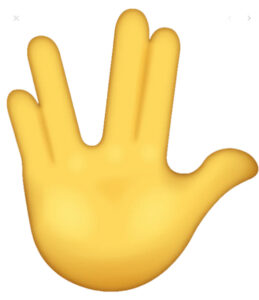
Why don’t we give it a try? (Can you do it?)
Finally, at this difficult time in our human history, I am reminded of some words — once used in a movie but originally attributed to John Lennon. He said:
‘“Everything will turn out alright in the end.
If it is not alright, it is not yet the end.”
![]()
The Winter Solstice: Revisiting a Time for Reflection and Review
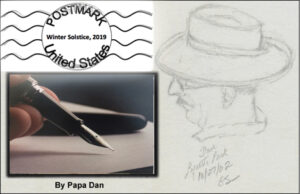
“The dance between darkness and light will always remain— the stars and the moon will always need the darkness to be seen, the darkness will just not be worth having without the moon and the stars.”
― C. JoyBell
To download a PDF of this post, click here: Winter_Solstice_Dec_2019
===========================================================
Some say that the seasons drive the way we feel about the events swirling around us. Here in America in the twenty-first century, most of us might say that, this time of year, most of our feelings are dominated by celebrations of Christmas and The New Year. We are filled with thoughts of exchanging gifts, decorating a tree, and making New Year’s resolutions. We think of these cultural forces as having always been with us — but there are stories that can take us back to their origins. If we speculate on where all of this comes from, we might consider that it all comes from one common astronomical fact — The Winter Solstice: the shortest day of the year.
This year, 2019, here in our part of the world, the official astronomical moment of the Winter Solstice takes place at 8:19 pm PST on Saturday, December 21. Since ancient times, this time of year has signaled a time for review and thoughtful reflection. Historians tell us that we can trace this back a long way. The Romans, for example, like other ancient peoples, had festivals acknowledging that the birth and death of Winter signified important trends in their world, often credited to — or blamed on — “the gods.” That habit has endured through a variety of cultures.
We are also told — although quietly — that early Christians selected the last week of December to celebrate the birth of Jesus of Nazareth to coincide with the pre-Christian celebration of the Winter Solstice. If true, it was a sensible thing to do since it was already a time celebrated with the giving of gifts and official pronouncements about the state of society. So, what’s the story?
It turns out that, for the first three centuries of the existence of Christianity, there is no record that the birth of Jesus was celebrated officially at all. In those early centuries, the two most significant “holidays” were Epiphany on January 6 — reputed to be the arrival of The Magi (“The Three Wise Men”) after the birth of Jesus — and Easter, which celebrated the resurrection of Jesus. The first official mention of December 25 as a holiday honoring Jesus’ birthday appears in an early Roman calendar from 336 A.D. BUT, you may ask: was Jesus actually born on December 25?
The answer is ‘probably not.’ The Bible doesn’t mention a date for his birthday; but the Nativity story contains some clues. Among the examples of such ‘hints,’ the presence of shepherds and their sheep in the story suggests a Springtime birth; but a lot of time went by before anyone settled on a date for the occasion. Historians tell us that the Western Roman Emperor Constantine made Christianity ‘legal’ in his empire with the Edict of Milan in 313. In 336, he is said to have formally established the birth of Jesus at December 25 (while the Eastern Empire celebrated the birth on January 6). So, the date is not planted on solid ground. Even in more recent American history, the celebration of Christmas as we know it has not been without controversy. The Puritans of colonial New England, for example, banned the observance of Christmas traditions —giving gifts, lighting candles, and decorating trees — primarily because of its pagan roots. Later, Christmas fell out of favor following the American Revolution as a rejection of a peculiarly British custom. It didn’t become an American Federal holiday until 1870.
So, whether or not we accept the story that Emperor Constantine “stole” the Winter Solstice and turned it into Christmas, this part of the calendar has for a long time been recognized as a time of reflection and review by societies and individuals associated with many beliefs and traditions.
Winter Solstice Rituals from Around the World
Setting aside for a moment the powerful Christmas traditions that dominate the modern western world in the last week of December, thousands of people around the globe will herald the Winter Solstice, the shortest day of the year, with centuries-old rituals. It is, of course, the first day of Winter, — the turning point of the year in many cultures — the moment that our hemisphere is pointed at its farthest distance from the sun. Some of the vocabulary that comes down to us from the ancients provides examples. Pagans called it the “Yule,” acknowledging the birth of the new solar year, celebrated to this day in North America by the Circle Sanctuary, one of several prominent pagan groups in Northern America. Here are a few other notable examples of Winter Solstice observances that are practiced here in our own twenty-first century:
–> 1. Catching the Sunrise at Stonehenge
England’s famous Stonehenge lures thousands of visitors during both the summer and winter solstices. Dozens of pagan and druid groups head to Stonehenge to pay tribute to the Sun on this occasion. Revelers gather at the prehistoric site of ancient stones in Wiltshire to sing, dance, play instruments, kiss the stones, and do yoga as they wait for the sun to rise. The iconic Stonehenge is known for its precise alignment with the sun’s movement and has been known as a sacred place of worship and celebration of solstices for thousands of years.
–> 2. Absorbing the First Rays of the “New” Sun
At the Newgrange Monument in Ireland, dozens of people, lucky enough to be selected through an annual lottery, get the chance to stand inside the ancient Newgrange monument in Ireland and absorb the first rays of the day during the Winter Solstice. Newgrange is a burial mound in Ireland’s Boyne Valley that is over 5,000 years old. The Stone Age monument contains a 62-foot passage that leads into a chamber that is aligned with the sun as it rises during the Winter Solstice. Between Dec. 19 and Dec. 23, around dawn, sunlight pierces through the top of the chamber and slowly illuminates the room for about 17 minutes. More than 32,500 people applied for a spot inside the chamber this year. Only 60 of them were picked from the lottery to partake in this Winter Solstice ritual.
–> 3. Soaking in “Fruit Baths” in Japan
In Japan, people traditionally soak in hot baths filled with yuzo citrus fruits to welcome the Winter Solstice and protect their bodies from the common cold. During a typical solstice celebration, children from a local preschool share a dip in a traditional yuzu tub as dozens of the yellow yuzu fruits float around them on the surface.
–> 4. Getting Scared by the Krampus in Austria
Hordes of revelers descend on Hollabrunn, Austria, each year during the Winter Solstice to watch a swarm of people dressed like Krampus — the half-demon, half-goat counterpart to Santa Claus. They terrorize and tease the crowd in giant horned masks, sharpened teeth, fur body suits, and whips. The traditional ‘Krampus Run’ in Austria is believed to ward off bad spirits near the Winter Solstice, but it is also a source of entertainment — “It is weird, but it’s fun,” according to local scholars. “It’s sort of like Halloween, you get to dress up in these really disgusting costumes. You get to do stuff you don’t normally get to do.”
So, what do these ceremonial observances have in common?
1. Taking advantage of the opportunity to “start over” as the Sun does every year.
2. Reflecting on the things that have happened over the past year as the Sun dies — and “closes the curtain” on a portion of our lives.
3. Taking part in the rebirth of the Sun and, with it, starting our own lives over again by learning lessons from what has gone before and finding ways to make the coming year better than the last one.
So, Can All of this celebratory stuff actually make a difference?
While I have tried (and occasionally failed) over the past year to avoid writing about our corrosive politics and the bad news that follows from it, maybe this Winter Solstice can provide an opportunity to recall good things that have happened that we might be able to build on.
Let’s take a look at ten examples of Good Things
1. In 2019, the most diverse class of lawmakers in history was sworn into the 116th Congress: the most women ever (105 in the House, 25 in the Senate); a record number of Hispanic and Latino members (45 in the House, 5 in the Senate); 56 African American members (53 in the House, 3 in the Senate); 30 members who are Asian American; a record number of Native American, Pacific Islander Americans; the most diverse religious representation ever (Christian Protestant, Catholic, Jewish, Mormon, Buddhist, Muslim, Hindu, Greek Orthodox, Pentecostals, Unitarians, and Adventist); and 96% have a college education.
2. Sixteen-year-old Greta Thunberg was honored as Time Magazine’s Person of the Year for starting a world-wide movement of young people to motivate world leaders — notably by speaking at the General Assembly of the United Nations — to urgently address the threat of climate change. Millions are paying attention at the highest levels. (Only one person we know of was publicly displeased with this news.)
3. The European Union banned single-use plastic bags, plates, forks, and straws in Europe. This act could avoid nearly $25 billion worth of environmental harm by 2030. The U.S. is … uh … well … (not) following their lead, slowly, reluctantly, from well behind … but … well … it’s early (isn’t it?) California and New York were the first U.S. states to follow this example.
4. A Federal Judge stopped the Trump Admin from ending no-cost birth control that was subsidized in the Affordable Care Act. (The decision will be appealed.)
5. UCLA gymnast Katelyn Ohashi scored a perfect “10” on her floor routine, making it look fun and effortless, with a jaw-dropping final landing!
6. Chicago became the largest city in US history to elect a black female, openly gay mayor.
7. The Scripps National Spelling Bee crowned eight co-champions when the kids ran through five consecutive final rounds of perfect spelling, causing the contest to run out of words. (I guess someone is learning something out there.)
8. Michelle Obama’s memoir Becoming in becoming the most popular memoir in history, selling more than 10 million copies in one year (and still counting) and staying on the NYT top ten non-fiction books for a record number of weeks (53 as of this writing).
9. A 48-year-old Cookie Monster from Sesame Street made his baseball debut — singing “Take Me Out To The Ballgame” at Wrigley Field during the 7th inning of a Chicago Cubs game. Thousands of old folks and young kids took photos.
10. Solar and wind power have started to gain popularity. Today, one third of power around the world is being generated by renewable sources and coal is now more expensive than wind or solar. Finland just committed to phasing out coal within ten years. So it begins …
What Does All This Stuff Have to Do with the Winter Solstice?
Maybe good things begin with good ideas. The Winter Solstice reminds us that the world is ready to remake itself once again. Those who try to influence the outcome, especially in concert with others, may be surprised at how much influence is possible. Maybe an opportunity like the Winter Solstice can cause folks like us (you know, Michele, Greta, Cookie Monster, and the rest of us) to pause, and reflect, and then maybe decide to make a difference and act in the coming year as the Sun rises out of the darkness of Winter. It is easy to moan about how cold and dark it is on the shortest days of the year; but it doesn’t take much more effort to consider how to help make it brighter when the Sun rises. And we don’t have to do BIG things. The list of ten good things we just noticed above did not start big. They started small, with individuals deciding to do something small and then joining others to do it together. We can decide to do some small things in our own families, our neighborhood, our town, you know, right here and right now. And, we can seek out others, let them know what changes we’d like to be part of, and join them to make them happen.
So, after the “reflection and review” that the Winter Solstice evokes, can the coming sunlight bring with it a call for action? But what kind of action and by whom? When we were kids, we are taught that our voices are very effective tools. And in a country like ours, we select representatives to increase the reach and volume of our voices. So, it would make sense to let those representatives know what kind of action we intend.
Some sample pathways:
https://www.feinstein.senate.gov/public/
https://www.harris.senate.gov/contact/
https://swalwell.house.gov/
https://govapps.gov.ca.gov/gov39mail/
Finally, I’d like to cite two writers I have mentioned before who have offered useful advice for this time. One is poet Annie Finch, the author of a poem called “Winter Solstice Chant.” In an interview, she reminds us of the two-step process of moving from darkness to light: “If you don’t experience the darkness fully, then you are not going to appreciate the light.” The other — a well-known and eloquent gentleman — advised us once to “become the change we seek.” It might be worth a try as the Sun, at its darkest point, prepares to rise.
Postscript — December 22, 2019: https://www.cnn.com/travel/article/stonehenge-winter-solstice-trnd/index.html
![]()
Is America Ready for the Twenties?
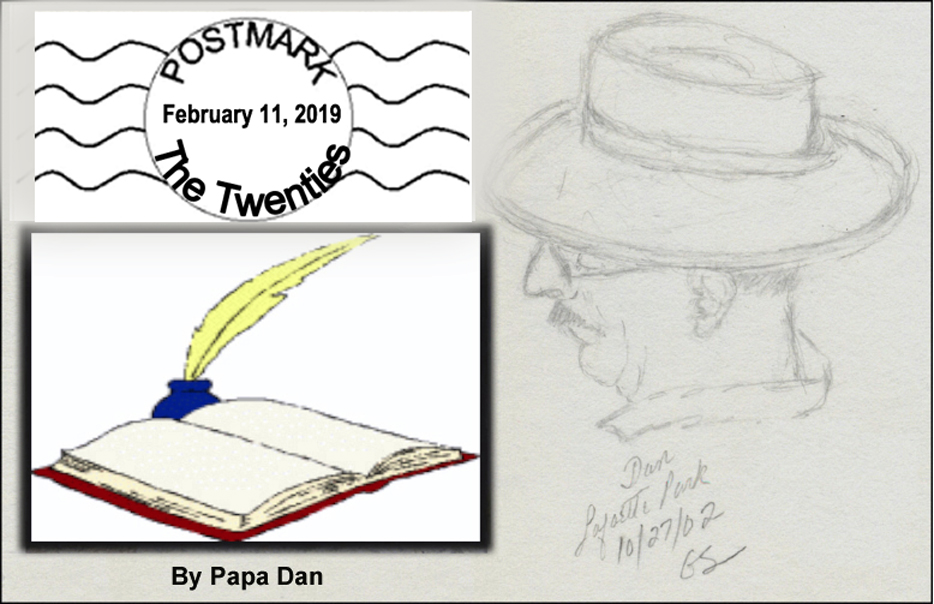
“The definition of insanity is doing the same
things over and over again,
but expecting different results.”
— Albert Einstein (100 years ago)
============================================================
Now that we have turned the calendar into January, America stands on the threshold of a new decade: “The Twenties” — that is, the 2020s. Over my lifetime, we Americans have a habit of naming decades, mostly in retrospect, for the attributes that were remembered by the generations that follow. Let’s quickly review the decades of the previous century:
• 1900 to 1910 – often called by American writers “The Good Years” — This was a time of peace, optimism, strength, and increased productive immigration
— my unskilled, impoverished, and illiterate grandparents came to America during this decade.
• 1910 to 1920 — Often called “The Teens”: featured War throughout Europe, widespread suffering, less immigration to America.
• The Nineteen Twenties — called “The Jazz Age” or “The Roaring Twenties”): featuring the odd partnership of Prohibition, alcohol, Jazz, and, well, “roaring.” We’ll comeback to this one.
• The Nineteen Thirties — called “The Great Depression” started with the Stock Market crash, and led directly to unemployment, hunger, and the rise of Nazis in Europe.
• The Nineteen Forties — the first half is called World War II, featuring isolationism and then war, the second half of the forties has been called “The Seeds of Prosperity”:
— that featured optimism and growing stability.
• The Nineteen Fifties featured “The Cold War,” and “Prosperity for Most of Us”: it was the stability that I grew up with — stability for most of us.
• The Nineteen Sixties — came to be called “The Age of Aquarius”: a combination of dashed optimism, racial/generational tensions, and the Vietnam War. These were my teenage years.
• The Nineteen Seventies — called “The Me Decade” featured Watergate, individualism, a monumental oil crisis, Middle East violence, and withdrawal from Vietnam.
• The Nineteen Eighties — was called the era of “Fact-Free Politics”: featuring Middle East wars and a historic redefining of “conservatism.”
• The Nineteen Nineties — WSJ and NYT famously named it “The Best Decade Ever”:
it featured the rise of Internet, a strong economy, multiculturalism, and then … well, the emergence of the “politics of personal destruction” and lots of small wars.
• 2000 to 2009 ‑ “Rise of Terrorism and Great Recession ”: 9/11, a mis-directed military response to 9/11, attacks on civil liberties, a recession, fiscal stimulus, and financial regulation.
So, last month we just completed the decade of 2010 to 2019 — What-am-a-gonna-call-it?:
This decade has featured near bankruptcies of whole countries — AND lots of disasters (e.g., disastrous earthquakes; disastrous tsunamis, floods, fires, and hurricanes; and disastrous elections). It also turned out to be the hottest decade on record — by far — leaving the largest number of burned square miles in history all around the world. Recently, writers in the New York Times have called this decade just ended “The End of Normal,” “The Decade of Disillusionment,” “and “Trying to Remember What It Was Like to Be Happy.”
It’s early, but I think of this decade just ending as simply the decade between all of that stuff we have just listed; and the inevitably monumental Twenty Twenties that lie ahead of us. So, I will call it “The Tweens”; but we’ll have to wait and see if that sticks. Nevertheless, the question hanging over is today is:
— “Are we ready for the coming Twenty Twenties?” Perhaps we should think about it.
So, let’s take a closer look at the last time we had a “Twenties” and see if there is anything about the 1920s that can hint at we might expect from the “Twenty-Twenties” to come.
The 1920s was named the “Roaring 20s” or “Jazz Age.” This decade began, inauspiciously, on Jan 16, 1920 with the onset of Prohibition. It is hard to fathom that the alcohol-soaked events of “The Jazz Age” could possibly have begun with a national decision to outlaw alcohol; but as Will Rogers famously said, “Prohibition is better than no alcohol at all.” An aside: my grandfather was a sharecropper in the Santa Clara Valley. He grew grapes and citrus during prohibition and, I was told, people came from miles round to buy his expensive oranges and he gave his homemade wine away for free.
The 1920s was considered “Roaring” because the younger generation rebelled against traditional taboos while their elders engaged in (what turned out to be) reckless stock-market speculation. The 1920s was also a decade of bitter cultural conflicts: religious fundamentalism, an anti-science movement swept the nation, and nativists battled against immigrants.
Does any of that sound familiar?
The 1920s also turned out to be a dramatic upsurge in technology (the emergence of flight, increased automobile use, dramatic spread of electricity). Sexual mores, gender roles, hair styles, and fashion all changed profoundly in the 1920s. The result was bitter clashes over such issues as foreign immigration, evolution, the Ku Klux Klan, alcohol abuse, women’s roles, and race.
Does any of that sound familiar?
Is there anything in those descriptions of the 1920s that one might suspect is waiting for us in the coming Twenties?
Let’s remember that the “Roaring Twenties” Didn’t End Well. The stock market crash of October 1929 brought a dramatic end to the prosperity of the 1920s — unemployment soared, Industrial production was cut in half, international trade fell off a cliff, and investment fell 98%.
The causes of the Great Depression included: the stock market’s dependence on borrowed money; weak purchasing power among the working class, and high tariffs that reduced international trade and contracted the money supply.
Does any of THAT sound familiar?
So, if the forces that led to the 1920s and the 1930s seem to be brewing in similar ways today, what outcomes might we expect to see in the Twenty-Twenties to come?
A Few Observations
— Worldwide population: is expected to explode to more than 8.5 billion people in the mid-2020s.
— Technology is expected to provide dramatic expansions of things like: Autonomous & electric vehicles, artificial intelligence, drones, 3d printing, renewable energy.
— The 2020s carry some predictions in society and politics:
- Remember that dictators in the 1920s targeted newspapers and journalists. Do you see any indications that “dictators” are attacking the news media today as we begin the coming Twenties? Media issues like Internet privacy, net neutrality, and the power of social media, seem to threaten to the survival of “Old Media?”
- Are we seeing the start of “First World” struggles like widening economic disparity, decreasing employment opportunities, decline in the numbers of well-paying jobs — The Amazon Effect?
- Are there violent international conflicts looming in the coming Twenties?
- Some predict changes in music (more streaming, more undefined styles, can Country Music endure? What about Hip Hop? Will anyone remember “Rock and Roll?”)
- What about predictions in Fashion (OK, right, how should I know?)
What’s the answer to our question – Are We Ready for the Twenties?
Those of us who live here in the 21st century think of ourselves as VERY DIFFERENT from those who lived a century before, in the 1920s. Yet, we can see that many of the conditions and behaviors taking shape today mirror the forces that led to the 1920s and 1930s. Will those forces inevitably lead to the repeat of those outcomes in the coming “Twenties? Or can we who claim to be “VERY DIFFERENT” people cause a different outcome?
Two questions emerge: Was there anything people could have done in 1919 to create a different outcome in the “Roaring” Twenties that were ahead of them? And for us, you and me — Is there something WE could do today to have an effect on the coming “Twenties?”
Some have joined groups marching in the streets carrying signs protesting a variety of things. Will that help?
Or should we take the opposite approach, as some are recommending, and avoid the news altogether and focus our attention on our own immediate local life, right here and right now?
— Of course, if we did hide from the news, we wouldn’t hear about the good things — people like 16-year-old Greta Thunberg, Cookie Monster’s appearance at Wrigley Field after 48 years, Michele Obama’s best-selling book “Becoming” (58 weeks on the NYT Top Ten list), UCLA gymnast Katelyn Ohashi scoring a perfect “10” on her floor routine, the increasing use and declining cost of solar and wind power, the European Union (and some states) banning single-use plastic bags, forks, and straws; the generous work of Chef Jose Andres’ World Central Kitchen, and lots of others doing big good things that we might become part of.
So, perhaps we shouldn’t hide our heads in the sand — we might miss the good stuff.
Is there a way to “become the change we seek,” as an old friend has recommended?
As Einstein suggested, shouldn’t we start doing something different if we expect a different outcome this time? I bet we can do it. If so, I suspect we better get started.
==================================================

My Favorite Movies
 “[He’s] one of what we all are, Pelly,
“[He’s] one of what we all are, Pelly,
less than a drop in the great blue motion
of the sunlit sea.
But it seems some of the drops sparkle,
Pelly, some of them do sparkle!”
— King Arthur (Camelot)
“It’s quality work, and there
are simply too many notes, that’s all.
Just cut a few and it will be perfect.”
— Emperor Joseph (Amadeus)
Click for a PDF of this post:
82-ConVivio_My_Favorite_Movies_Aug2_2018
Where did this come from?
Six weeks ago, I published a piece on ConVivio called “Greatest Songs of All Time” (https://convivio-online.net/greatest-songs-of-all-time-2018/). It was inspired by a regular customer at The Flying Pig named Carl. We were talking about songs from “my era” (the 60s and 70s) and he asked me, “What songs are important to you?” So, I mentioned a few off the top of my head and … well, it caused me to rethink a list of The Greatest Songs of All Time that I had posted a few years before. So, when I made a new list and invited others to make their lists, I discovered that there are some talented list-makers among ConVivio readers. Fast-forward to this week and I was talking about those lists of songs with my son Will (one of the proprietors of The Flying Pig), observing how much attention that list-making exercise had attracted. The conversation turned to a favorite movie of mine, which Will’s brother Ben (the other Flying Pig proprietor) recently reminded me of. The movie, “2001 — A Space Odyssey” featured some music that I had accidentally omitted from my “Greatest Songs” list. The movie was a huge favorite during my senior year in high school and is currently getting some attention on its 50th anniversary. Will suggested, “What about a list of ‘Greatest Movies?” I mentioned a particularly dramatic pair of lines from a climactic moment of the movie
— So, this is the result …
PapaDan’s List
Below is my list of my favorite movies. Unlike my “Greatest Songs” list, I did not feel qualified to identify the “Greatest Movies of All Time.” Turns out that “All Time” is beyond the scope of my expertise. SO, my list consists of just the movies I liked best (at least as of today). As a bonus, I include a quote I remember from each one. I invite you to reply, if you like, with:
1. Your own list, as short or as long as you wish, of your favorite movies.
2. You are also invited — though not required — to include a quote that you find memorable from one or more of them (or not).
3. You are welcome to send comments like “How could you possibly leave out ________ from your list?” or “How could you include a dumb movie like _________ ?” All are welcome.
—> A few words of caution — I intended to make a list of ten movies. BUT, that turned out to be impossible. A struggle with painful cutting brought it down from 25 to 17. So, if you decide to make your own list, all of your good intentions to keep it short may be futile. I also could not list them in order of “favoriteness.” Just couldn’t. So, they are in alphabetical order. I also ignored the winners of the most recent Academy Awards, since I wasn’t familiar with many of them anyway. I also did not consider whether “my” movies received any awards in their day.
I hope you, at least, find this exercise interesting.
Here is my list:
My Favorite Movies — August 2, 2018
1. 2001 — A Space Odyssey
• Dave: “Open the pod bay doors, HAL.” HAL 9000: “I’m sorry, Dave. I’m afraid I can’t do that.”
• HAL 9000: “This mission is too important for me to allow you to jeopardize it.”
2. Amadeus
• Emperor Joseph, to Mozart: “My dear young man, don’t take it too hard. Your work is ingenious. It’s quality work. And there are simply too many notes, that’s all. Just cut a few and it will be perfect.”
• Salieri: “This was a music I’d never heard. Filled with such longing, such unfulfillable longing, it had me trembling. It seemed to me that I was hearing the voice of God.”
3. American Graffiti
• “I don’t like that surfin’ shit. Rock and roll’s been going downhill ever since Buddy Holly died.”
4. Butch Cassidy and the Sundance Kid
• Butch: “If he’d just pay me what he’s spending to make me stop robbing him, I’d stop robbing him.”
• Etta: “I’ll do anything you ask of me except one thing. I won’t watch you die.”
5. Camelot
• Arthur (speaking to Pellinore of the newly knighted Tom of Warwick): [He’s] one of what we all are, Pelly, less than a drop in the great blue motion of the sunlit sea. But it seems some of the drops sparkle, Pelly, some of them do sparkle!”
6. Chicago
• Roxie: “I’m a star, and the audience loves me, and I love them, they love me for loving them, and I love them for loving me. And we love each other. And that’s ’cause none of us got enough love in our childhoods. And that’s showbiz, kid.”
7. E.T. the Extra-Terrestrial
• “I’ll be right here.”
8. Field of Dreams
• “If you build it, he will come.”
• John & Ray Kinsella: “Is this heaven?” “It’s Iowa.” “I could’ve sworn it was heaven. Oh yeah, it’s the place where dreams come true. [Looks around and sees his wife playing with their daughter] “Maybe this is heaven.
9. Forrest Gump
• “Life is like a box of chocolates. You never know what you’re going to get.” “Stupid is as stupid does.”
• “I’m not a smart man, but I know what love is.”
10. Funny Girl
• “You think beautiful girls are going to stay in style forever? I should say not! Any minute now they’re going to be out! Finished! Then it’ll be my turn!”
11. The Graduate
• “I want to say just one word to you, just one word.” “Yes, sir.” “Are you listening?” “Yes, I am.” “Plastics.”
12. Moonstruck
• Ronnie Cammareri: “Loretta, I love you. Not like they told you love is … but love don’t make things nice, it ruins everything. It breaks your heart. It makes things a mess. We aren’t here to make things perfect. Snowflakes are perfect. Stars are perfect. Not us.”
13. Planet of the Apes
• “Don’t look for it Taylor, you may not like what you find.”
14. Saving Private Ryan
• “Earn this.” At the very end of the movie, Tom Hanks says it twice — once to Private Ryan and once to all of us in the audience who have benefitted from the sacrifices of soldiers in World War II.
15. The Sound of Music (and let’s not forget My Fair Lady)
• Maria: “When the Lord closes a door, somewhere He opens a window.”
16. Star Wars I – V
• Yoda: “Do. Or do not. There is no try.” Riyo Chuchi: “To die for one’s people is a great sacrifice. To live for one’s people, an even greater sacrifice. I choose to live for my people.”
17. Wizard of Oz
• “True courage is in facing danger when you are afraid.”
18. Midnight In Paris
• Hemingway: “The artist’s job is not to succumb to despair, but to find an antidote for the emptiness of existence.”
19. Same Time Next Year
• Doris: “Doris”; George: “What?”; Doris: “My name is Doris.”; George: “Your name is Doris?”; “Yes.”; George: “But I’ve been calling you Dorothy all night.”; Doris: “Yes, I know.”
20. The Princess Bride (The Greatest Movie Ever Made — according to me)
• Inigo Montoya (to the Six-Fingered Man): “My name is Inigo Montoya. You killed my father. Prepare to die.”
What’s missing from my list?
I omitted a category of “ancient” movies (like Casablanca and those starring Marlon Brando-types), movies by Alfred Hitchcock (although I enjoyed several of them, notably The Birds and Rear Window), and most “war” movies (notably Patton). I also left out The Ten Commandments (I was ten years old when my parents took me to the drive-in to see it), and Ben-Hur (I was nine when my parents took me to its Premier in Oakland), Raiders of the Lost Ark (not sure why), Schindler’s List (because I don’t like remembering it), and Blazing Saddles (because all the memorable quotes are racist and disgusting).
It’s funny about movies. Looking back, some of the choices of “favorites” can feel quite personal and can represent who we were back when we saw them. But, they’re just movies, right?
I look forward to your comments, maybe even a few lists.![]()
Below is Cary Sapone’s list of favorite movies
— In no particular order (another excellent list!).
Shawshank Redemption
Pretty in Pink
Mrs Doubtfire
Pretty Woman
When Harry Met Sally
How the Grinch Stole Christmas
The Pursuit of Happiness
Back to the Future
Sixth Sense
The Polar Express
The In Crowd
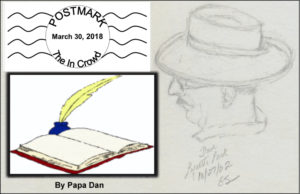
“You ain’t been nowhere
’til you’ve been in
with The In Crowd.”
— Dobie Gray (lyrics by Billy Page
Click here to download a PDF of this post: ConVivio_The_In_Crowd_Mar29_2018
= = = = = = = = = = = = = = = = = = = = = = = = = = = = = = = = = = = = = = = = = =
Last week, a friend of mine lamented the fact that some important content she was interested in was available only on Facebook, Twitter, and other social media. The bad news was that this content happened to be the marketing material from the publisher of her soon-to-be-released book. The problem, in her words, was this: “I don’t do social media and don’t intend to start!”
After some thought, I replied, “It seems to me that everyone assumes these days that we are all is hooked up to these social-media websites; and, if you aren’t, you don’t have a clue what’s going on. It’s like the new ‘In Crowd.’ “
And then a memory popped into my head — “Remember the song from back in the day …”
An Old Song Pops into My Head
Let’s drift back a moment to 1964. Every Saturday morning on radio station KYA, my favorite disc jockey, Emperor Gene Nelson, would count down the “Top 30 Hits” for that week. A lot of new songs were introduced on those Saturdays; and it was absolutely essential for us 14-year-olds to keep up with the latest music. High school was a big change for me. After eight years in the same school, in the same class with pretty much the same faces, the transition from being an 8th grader to being a High School freshman was intimidating.
My freshman class had ten times as many kids as my 8th-grade class had. I knew thirty-some kids and the rest of the 300-some kids in the Freshman class were strangers. But, even as a stranger, like other 9th-graders, I quickly realized that listening to the right music would be required to fit in to my new world. So, I listened carefully — to the Beatles, The Stones, The Supremes, Leslie Gore, The Dixie Cups, The Dave Clark Five, Dusty Springfield — to all the music Emperor Nelson played on KYA.
With all that in mind, one Saturday morning, The Emperor introduced a new song that got my attention. The song was “The In Crowd.” Coming from a school where I had always known everyone, the idea of an “In Crowd” was new to me. The big, bold voice of Doby Gray sounded like a voice of authority.
Here is what the song said:
The In Crowd
By Dobie Gray (recording released December, 1964); lyrics by Billy Page

Not all of the ideas in the song were new. I already knew that some 8th graders were considered more “cool” than others (certainly more “cool” than I was); and “cool” usually meant exhibiting behaviors that other kids admired. I remember a friend of mine, Michael Savage, (who had an older brother who could teach him “cool”) showed up one day in the 8th grade with “a new way of walkin’,” like the song said. When he walked across the courtyard at school, with his slow, purposeful gait and aloof expression, he caught the admiring eye of those of us who were “less cool.”
So, back then, I suppose we 8th-graders had a sense that some of us were especially “in”;
but the following year when the song came out, to my 9th-grade ears, some of these “In Crowd” song lyrics revealed ideas that separated those who were “in” from the rest of us. Two examples:
First: it hadn’t occurred to me that some people “know what the in crowd knows” and presumably, those were things that I didn’t know, and
Second: apparently, the chosen few “go where the in crowd goes” and “if it’s square, we ain’t there.”
I wasn’t completely sure what “square” meant — except that I suspected that “square” included attributes that I probably had and included places that I went. (Uh, maybe places like the library or the store where I supplied my stamp collection? I suppose they were “square.”)
As I became more accustomed to high school, some of the lyrics were actually troubling:
the assertion that “our share is always the biggest amount” didn’t sit well with my teenage sense of fairness and I wondered, as an outsider, ‘what earned you that biggest share’ — other than trivial stuff like “our own way of walkin’ ” and “our own way of talking’.” The song assigned behaviors to those of us who were not in “The In Crowd” that I didn’t like:
They make way day or night
They know the in crowd is ‘out of sight.’
Who said I was going to “make way” for anyone?” On reflection (or what passed for ‘reflection’ in a 14-year-old), “Spendin’ cash, talkin’ trash” did not sound like something worthy of respect.
Evolution
As time went on, and this Freshman became a Sophomore, and so on, other bits of evidence confirmed my suspicion (and hope) that there were other ways to earn respect — things like getting good grades, succeeding at athletics, reading books, joining clubs, being a good friend, etc. The music continued to be important to me (and I learned to keep quiet about my Frank Sinatra and Tony Bennett records), but I came to realize that a narrowly defined “in crowd,” that merely imitated approved “cool” behaviors, was not particularly appealing. I considered that a person, even in high school, could be part of more than one “crowd.” One of my teachers had a sign on the classroom wall that I copied into my notebook. It said:
“They laugh at me because I’m different.
I laugh at them because they are all the same.”
Fast Forward to Today
So, as I mentioned, these “In Crowd” lyrics from 54 years ago did not spring into my memory out of nowhere. The pervasive nature of Facebook, Twitter, and other social media seems to have created a new “in crowd.” While digital media was originally promoted as being inclusive; in fact, the “In” and ”Out” feature of digital social media seems to have grown more exclusive. Has Facebook become a new “In Crowd?” We have learned lately that there are things we have to give up to be a member of that crowd.
Looking at this topic through the lens of today, I think we can hear these lyrics in The News that we hear every day. We seem to be surrounded by people who want us to believe that we must be members of a particular exclusive “in crowd” or we are not properly American. Some promote the idea that the survival of that American “in crowd” requires its members to exclude people who are different. Are we being fed an exclusive “In-Crowd-First” philosophy?
The optimist in me wants believe that the kind of exclusive “In Crowd” behavior we saw as teenagers of 1964 eventually disappears with age and is replaced with something more sensible and grown up. There is evidence, however, that my optimism may be naïve. Is today’s “in crowd” mentality growing rather than receding? Is it dangerous? How divisive can it get?
But, I do notice that some crowds are emerging with more inclusive intentions — crowds like “Enough is Enough” and “Never Again.” Some of the most articulate and welcoming spokespersons of those crowds are not much older than I was in 1964 and they are starting to emerge as the “grown-up” voices of our time. And the crowds, just last weekend, have been quite large. Do these “in crowds” offer just another short-lived “new way of walkin’ ” and ” new way of talkin’ ” as they did in my youth?
Or is something more enduring, more inclusive, perhaps more promising, on the horizon?![]()
The Good Old Days?

“Nothing is more responsible for ‘The Good Old Days’ than a bad memory.”
— Franklin P. Adams
“These are ‘The Good Old Days.’ ”
— Carly Simon
Click here to download a PDF of this post: ConVivio_DRAFT_GoodOldDays
= = = = = = = = = = = = = = = = = = = = = = = = = = = = = = = = = = = = = = = = =
We’ve All Heard It— Or Said it — Some Version of It
I’ve heard it a number of times lately, in various forms, by people of different ages or with very different points of view — myself included — some version of:
“How did we get here? Things were never this bad back in _____________”
(and here we fill in the blank with our version of ‘a better time’)
Mighta been “back in the 1950s, when I was a kid,” Or maybe “back in my thirties when my kids were little.” Some might offer: “The 1970s, when I was a kid.” Or “at the peak of my career when I was at the top of my game.” Or “back when movies were better” or “back when the government worked better” or “when I could hit consistently from the three-point-circle.” Or how about “when the world (or the country or the city or the neighborhood) was safer (or cleaner, friendlier, easier to understand or had less traffic)?” Or “two years ago, before . . . ”
You know: “The Good Old Days.” You remember.
I suspect each generation can recall a decade or a year (or a month or a day or even a place) when/where the things that are annoying or troublesome or frightening about today were NOT happening (or at least did not seem so annoying or troublesome or frightening in our memory). Do you have a memory of such a time — a time that you remember as being better than today in some way? I bet you have some images in your mind that represent what was better about that time. Were the people better, more reliable, more friendly, smarter? Were the choices available to you more appealing back then? Easier to achieve? Less of a struggle? More fun? Did stuff make more sense to you? Were those times really better?
A Well-Used Example
People my age (the ‘baby-boom’ generation) like to talk about the 1950s and early 1960s, remembering it as a time of stability and simplicity, when music was more harmonious, when post-war America was expanding its prosperity and influence in the world and building lots of shiny new things — cars and highways, and buildings, and corporations, and … stuff. Maybe we remember that we liked our neighborhood better somehow.
Just for fun, let’s take a look at that time, just was an example. We’ve got pictures …

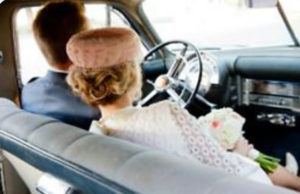


Some of us remember the time before seat belts, riding in the back of station wagons and pick-up trucks. It was a time when there weren’t so many rules; but I guess we don’t want to think about the danger we were in every day. Seat belts started showing up at the end of the 1950s and many of us actually started using them in the mid-1960s.
Other memories come to mind from that era —
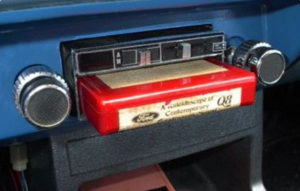
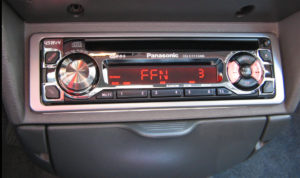
Remember when eight-track stereo (above, left) started showing up in cars about 1964? And when they were replaced by cassette players in the late 1970s? Yes, this was way before CDs (1982). But, we’re getting ahead of ourselves. Here’s what really mattered at the end of the 1950s:
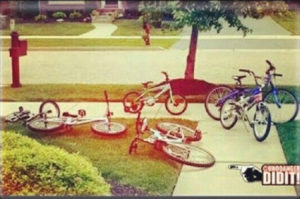
Before any of us cared about cars, here is how you found your friends in the neighborhood in the 1950s. Here, they’re all down the street at Kelly’s (he had a swimming pool).
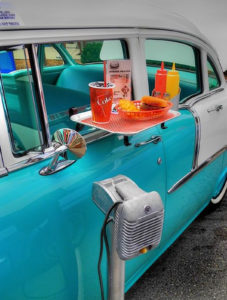
And do you remember when you (OK, your parents) could drive up to a hamburger place (like A&W or the “Panther Drive-In” in Antioch) and the ‘Car Hop’ would come out to the car (sometimes on roller skates) and serve your food on one of these window trays? (What do you mean you never went to the Panther Drive-In in Antioch? There was a time when it was the center of the universe. Didn’t you know?)
Me? OK, I hung out at Fosters Freeze.


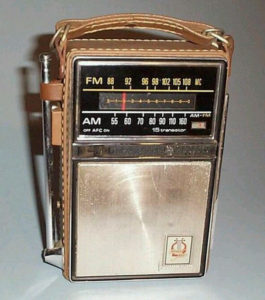
Surely you remember when every business had a cash register like this one on the left? Maybe you started using an Instamatic camera with flash cubes to take photos around 1963? (It used film — remember film?) But, most important of all was the transistor radio, above on the right. I’m sure you, like me, listened to the San Francisco Giants (as described by Russ Hodges and Lon Simmons) on one of these. And, on Saturday mornings, I listened as Emperor Gene Nelson counted down the Top 30 songs on KYA. Then in the late evening on KYA, Big Daddy Tom Donohue played those same songs and read commercials for Clearasil (the Acne Cream). He would sign on at the beginning of his show with these words: “This is your Big Daddy Tom Donohue. I’m here to clear up your face and mess up your mind.” No fooling, he actually said that every night — don’t you remember?
“The Fifties” Come Into Sharper Focus
Those are some of the things that I remember about that era. I claim that “The Fifties,” the fabled time of stability, predictability and good times, lasted from 1950 until November of 1963. After that, troubling, unexpected things started happening — or maybe I just became more aware of a wider world with more complexity and danger than I had seen before. I learned that America was in a mortal struggle against The Soviet Union who, we were told, wanted to kill us all with nuclear weapons because they believed that we wanted to kill them with those same weapons. When we practiced diving under our desks at school in the event of a nuclear attack, I became painfully aware that the wider world was a threat to us right here in my town.
On the evening news, Walter Cronkite starting telling us some very disturbing things including the fact that my hero at the time had been murdered on the streets of Dallas. When I showed up in high school in 1964, I began to learn that wars were brewing all over the world and Americans not much older than me were being sent to fight in those wars. I learned that while I was having my stable and secure childhood in my peaceful California town, others in my own state lived in towns that had bloody race riots. The only people of color I met growing up were the housekeepers who worked for my mother and basketball players who played for Pittsburg High School in the town next to ours. I wondered why there were no Black students in my high school and none seemed to live in my town. It wasn’t until 1968 — about the time that Martin Luther King and Robert Kennedy were murdered — that I learned that a class-action lawsuit had been filed against realtors who had conspired to make sure that no Blacks moved into Antioch. I remember being shocked and embarrassed as I packed up to go away to college.
Every day, it seemed, there was more distressing news and I became increasing aware that my own stable and peaceful life was an exception, not the rule, and I was living in the middle of troubled times across my country and around the world.
Well, so much for my example of “The Good Old Days.”
Waiting? What Might We Learn?
Just as we learn that it’s foolish to look back and wish for a return to “good old days” we think we remember, it also turns out to be foolish to wait for better days ahead. A song I remember from 1971, written and sung by Carly Simon, advises us to invest our energies into making TODAY the best it can be. The song, “Anticipation,” tells us that pinning our hopes on the future is wasteful. She wrote:
Anticipation, anticipation
Is makin’ me late
Is keepin’ me waitin’
She offers this advice:
I’m no prophet and I don’t know nature’s ways
So I’ll try and see into your eyes right now
And stay right here ’cause these are the good old days
These are the good old days. These are the good old days.
These are the good old days.
I take her advice to suggest that we have to invest in THIS day. I observe that there is much to like about today — I am surrounded by people who matter to me and who make my life matter. If today is not what we want it to be, we, along with those close to us, have the responsibility to make it better.
My conclusion? The past and the future are both flawed. THESE are the only “Good Old Days” we get. Maybe they’re only as good as we make them.
![]()
An Optimist Looks At 2018

“I’m an optimist. I tend to believe that, at some point, common sense and justice
will prevail, at least for a while.
I was raised to believe that you
can make good things happen.
Let’s face it, nobody gets out of here alive.
So, if today isn’t to our liking, it’s on us to
own it and make it better. We have more than enough people trying to make it worse.”
— PapaDan.”
Click here to download a PDF of this post: Optimist_looks_at_2018_FINAL
= = = = = = = = = = = = = = = = = = = = = = = = = = = = = = = = = = = = = = = = = = =
2017 was a strange year
An optimist might be hard pressed to use 2017 as a guide for deciding what to expect from 2018. Events in 2017 were certainly not predictable from evidence provided by 2016. For most of the year, how many predicted the outcome of the election, the reversal on the Paris Climate Accord, the childish name-calling that emerged in public discourse, a disparaging attitude toward the victims of natural disasters, and the threat of war around the world. Nobody expected that 2017 would be a year of women’s empowerment with a long list of male celebrities falling from power and influence after revelations of sexual misconduct. And, those stories are NOT over yet. None of them. An optimist has to look elsewhere to make predictions.
This Optimist’s Predictions for 2018
So, with 2017 as an unreliable body of evidence, how can we decide what to expect from 2018? Here are some things that this optimist expects are possible.
We’ll start with the important stuff:
The Academy Awards: “The Post” will win the award for Best Picture. How could it miss — it highlights the value of courage, the importance of the press in holding the powerful accountable, and the indispensable role of a woman pushing against daunting obstacles — the perfect messages for our times — AND it stars Meryl Streep and Tom Hanks! Bet the farm on it. (OK, so I predicted “La La Land” would win last time; and I was right for about 30 seconds.)
The Grammy Awards: I haven’t the faintest idea, since I haven’t heard of most of the nominees. — although the album “Tony Bennett Celebrates 90” sounds promising.
The NBA Championship — The Warriors will win — nuff said. (How many players can share the MVP award?)
The World Series — I can’t comment on the outcome of a World Series between the Yankees and the Dodgers; it violates every principle of “The Optimist Creed” (take a look here) that used to hang on the wall in my Dad’s office. So, I am required to predict that My Giants will win (maybe . . . someday).
The Super Bowl — I really don’t care, except that I hope football will continue to decrease in popularity, starting at the local school-district level and permeating upward. (BUT, Nancy has a terrific Super Bowl Party that MUST continue! — It’s all about the commercials and the wine.)
Now, Let’s Get Serious . . .
The U.S. Economy:
Paid family leave will become increasingly widespread — On January 1st, New York joined California and other states requiring paid family leave in more categories of employment.
The (new) Great American Migration begins — Silicon Valley and Wall Street will follow Amazon’s example and open major campuses in American regions where unemployment is high and real-estate prices and taxes are low. Depending on how fast and how thoroughly this strategy plays out, this migration could change . . . well . . . everything we currently understand about American life from politics to economics to regional culture.
Cost of Living vs Income — Minimum wages are rising in some 18 states at the start of 2018 (ranging from $7.95 in Missouri, to $13.50 in parts of California, to $15.45 around Seattle). The Great Migration mentioned above will strengthen this trend. The U.S. inflation rate is predicted to hover around 3.2% in 2018 (up a bit from 2017); BUT, the coming budget deficits caused by “tax reform,” may dramatically inflate the inflation rate nationally. We’ll have to wait and see.
Home purchases and mortgages — High house prices left over from 2017 are likely to stay high. People who live in places that lose historic industries (say, coal mining) will find it expensive to move where the jobs are and those opportunities are likely to require different skills and more education. With all the rebuilding that will be necessary after the hurricanes and fires, housing will be a challenge for the working class. We’ll have to see how/if the “Migration” works out.
The stock market will continue to rise, and even more sharply as corporate tax cuts take effect. Some will continue to assert (citing “alternate facts”) that profits reflected in stock prices lead to increases in hiring and wages. Economic history teaches that employers don’t hire employees because they receive a tax cut. Hiring has been stimulated primarily by one overarching feature: customers with money in their pockets. Therefore, the factors likely to lead to large-scale hiring are mostly absent from the business outlook for 2018. Instead, the market boom will continue to result in higher dividends for shareholders and profitable mergers that lead to consolidation (read: layoffs). THEN, corporate celebrating will be interrupted by an Autumn sell-off like the one in 1987. Such a sell-off and the above-mentioned migration could confirm the disjointed relationship between the stock market and the rest of the economy. Is that good news or bad news? This optimist predicts the result will be a dramatic election turn-about in November.
“The Mall” vs “Downtown” — A life-and-death struggle is developing between malls, with corporate stores like Macy’s and Nordstrom, and locally owned downtown shops. AND both of these business models are threatened by Amazon-style online shopping. Will online commerce drive local stores out of business? How many? What will happen to the people working in those stores? This optimist makes a two-stage prediction. First, online shopping will continue to strain local stores well into 2018. But, I expect large numbers of people to make the conscious decision to “shop local.” We’ll get tired of sending online purchases back to Amazon because they don’t fit right or don’t look the same as they do online. More shoppers will decide that they want to try on their purchases. Amazon seems to agree, given their purchase of Whole Foods and Target. If that happens soon enough, local stores may continue to be the backbone of local economies.
Optimists are mixed on this. We’ll have to wait and see.
World Events
The Korean Peninsula will begin to show peaceful signs by the end of January, despite the bellicose influence of the U.S. president in the region.
— On January 1st, Kim Jong Un extended an olive branch to South Korea, proposing discussions about the possibility of a North Korean delegation to the upcoming Winter Olympics in South Korea. He expressed the goal of a “peaceful resolution with our southern border.” South Korea agreed to high-level discussions on January 2nd. Prediction: the U.S. will continue to become more isolated in foreign affairs as other nations — in Europe, Asia, and the Middle east — explore solving worldwide problems (like global warming, “a two-state solution,” and European cooperation) without the obstacles created by rhetoric from the U.S. president. This promises to be both a problem (Step One) and a solution (Step Two) as an eventual rebalancing begins.
The Winter Olympics in South Korea — For two weeks in February the world will focus on the games alongside the warlike rhetoric of Kim Jong Un and Donald Trump. Many have suggested that this event is a recipe for disaster in the current international climate (remember the massacre at the Summer Olympics in Munich in 1972?). This optimist has come around to the view that, this time, the Olympics will actually do what they were intended to do — bring people together and lead to better understanding among people who look at the world through different eyes. North and South Korea may come around to find common interests and make their own way without the superpower rhetoric that has kept them apart for the past fifty years.
A Royal Wedding — Prince Harry and American Meghan Markle will be married in May. It will be a day for Brits to enjoy their royal anachronism. As usual, however, America’s top-level weirdness is interfering. Will the Royal Family insist that the sitting American president be invited or will the groom simply invite his buddy Barack and cause another Trump-centered kerfuffle? This optimist predicts that Obama will be invited to the wedding as a friend of the family and Trump will announce his rejection of the (not yet offered) invitation. Most Brits will say good riddance, keep calm, and carry on. Trump will probably announce that the British Prime Minister will not be invited to his Fourth of July tea party at Club Mar-a-Lago.
Domestic Politics
Trump’s Approval Rating will dramatically increase to 25% after he resigns in June. Two possible reasons will be offered for his resignation: 1) for health reasons or 2) “It was always my intention to make Mike Pence President; so, this is another in my long list of successes.”
The American 2018 Mid-Term Election — The November election will decide the control of the House and the Senate. This Optimist predicts that Democrats will win a slim majority in both houses and begin efforts to restore America’s leadership in areas like global climate, science-based energy independence, a two-state solution in the Middle East, income equality, a sensible tax structure, and other urgent policy areas. Prediction: in the short term, they will fail in many of those efforts. The Trump (or Pence) Administration will stand in their way as best they can. But, it will be a first step. The work will continue in statehouses and city councils across America. We’ll find out what we’re made of and it will take some time in the imperfect way we optimists always conduct ourselves.
We’ll see. This optimist expects to be surprised.
Finally,
This optimist believes that the key to a better 2018 will not be found in the national news; it will have to come from the way we treat each other right here in our own neighborhoods and families. While race, class, gender, and religion will continue to be a source of national and international conflict, the way forward must be local — in our selection of the people we choose to emulate — teachers, neighbors, you and me. We can affect change, but we have to be patient. I like a line I read from distinguished journalist Eric Sevareid near the end of his life:
“I’m sort of a pessimist about tomorrow and an optimist about the day after tomorrow.”
And as President John F. Kennedy said near the end of his inaugural address in January of 1961:
“All this will not be finished in the first one hundred days.
Nor will it be finished in the first one thousand days,
nor in the life of this administration,
nor even perhaps in our lifetime on this planet.
But let us begin.”
Yes, the sun will rise in the morning, good people will do the work they do best, be a good friend, be a good parent. a good sister or brother — and oh, YES, drink some good wine. Some will find ways to bring others along with them, helping those who need help and encouraging those who need only encouragement. Optimists will take inspiration from those optimists who have gone before them — like Winston Churchill, who said:
“Success is not final, failure is not fatal:
it is the courage to continue that counts.”
Happy New Year!
![]()
The Winter Solstice: A Time for Review
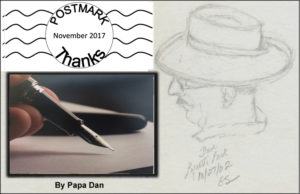
“The Winter Solstice has always been special to me, as a barren darkness that gives birth to a verdant future, a time of pain and withdrawal that produces something joyful, like a monarch butterfly extracting itself from its cocoon.”
— Gary Zukav
“The Romans, like other [ancient] nations, had nature festivals celebrating the death of winter to the life of spring — the Winter Solstice, featuring the giving of presents, the lighting of a huge log, and the burning of candles.”
— Samuel L. Jackson
Click here to download a PDF of this post: 70-ConVivio_Solstice_Dec_2017
= = = = = = = = = = = = = = = = = = = = = = = = = = = = = = = = = = = =
New Realities Are Emerging
Perhaps, it is the time of year: The Winter Solstice — the shortest day of the year. Since ancient times, the days between about November 21st and the new year have signaled a time for review and thoughtful reflection. While I have tried over the past year to avoid writing about our corrosive politics, a few writers and a couple of thoughtful voices have offered a more dignified and insightful approach to our politics than we have seen elsewhere in the media. So, I thought I’d give it a try. Two writers are worth a look:
• Steve Israel wrote a column for CNN online called “Forget red vs blue states, this is the real battle in America”
• David Brooks wrote a piece in the New York Times on Nov.9 with the strange title,
“The Existing Democratic Majority”
(Click on the titles above for links to the original articles.)
Let me attempt to briefly extract the ideas that made me sit up and take notice.
1. In “Forget Red vs Blue,” Steve Israel makes a dramatic assertion: that the divided politics that became familiar to us during the Bush and Obama years have been utterly disrupted. For years now, we had come to understand that all political issues and government decisions revolved around the divide between Red States and Blue States. Regions dominated by Republicans supported a predictable array of policies and attitudes. Likewise, those dominated by Democrats also supported largely predictable positions. With very little overlap, decisions came down to vote counts along that divide. His analysis — today two very different groupings have emerged by which decisions are likely to be made. We can call them “parties” if we want; but the designations “Democrat” and “Republican” no longer adequately define them. Some call it a struggle between “populists” and “the establishment”; but those labels don’t tell the whole story either. Steve Israel described them this way:
a) “The Normicon Party” consists of people from both traditional parties who favor respect for civility, stable institutions, and recognized ethical expectations. Normicons try to subordinate immediate emotion to long-held principles. Using a sports analogy, for them, politics is like boxing: “They may not watch it, but they understand the point of its rules, referees, and judges.” They prefer to maintain what most would recognize as “norms”
b) “The Denormocrat Party” embraces strength through attack, assaults on institutions, and the flouting of rules and regulations (i.e., “De-norming”). Denormocrats are willing to suspend long-held ethical expectations for short-term emotional gain. For them, politics is like cage fighting: “They may not watch it, but they identify with its full contact and minimalist rules.” They prefer to discard what most people recognize as “norms.”
Normicons see stability through order. Denormocrats seek salvation through disorder.
A number of writers have used words like the following (from Ezra Klein) to describe the 2016 election: “In the recent past, our divisions have been Democrats versus Republicans, liberals versus conservatives, left versus right. But not this election.” This campaign is not merely a choice between the Democratic and Republican parties, but between normal political parties and an emerging abnormal one.
2. David Brooks, in his column on Nov. 9th, proposed another way to understand the emerging American political landscape. He suggested that the “Republican vs Democrat” divide is being replaced with something different. Voters are starting to sort themselves into two groups that he calls “Somewheres” and ”Anywheres.” “Somewheres” are people whose values and priorities are rooted in their location — like “Virginia farmers,” “West Virginia Coal Miners,” or “Pennsylvania steelworkers.” These Americans tend to live in rural areas, they tend to stay put, they are often uncomfortable with cultural change, and they tend to vote Republican. The bad news for them is that, in many of these rural areas, the steel mills and coal mines are gone or declining and are not quickly being replaced by industries that require similar skills. But, the people remain — perhaps because they don’t have the skills or the will to move. Anywheres, on the other hand, value educational opportunities; they move to the cities where their skills and education are in demand, and as a result are more likely to feel comfortable with diversity and cultural change. If employment opportunities change, they tend to move to get a better job. Anywheres tend to vote Democrat.
a) Until recently, this trend kept a political balance because, while the cities tended to vote Democrat and rural counties voted Republican, the suburbs were divided and provided the balance (aka gridlock) of recent years. BUT TODAY, the growing suburbs are no longer divided. As Brooks put it: the suburbs “are ‘Anywhere’ all the way through.” This has suddenly begun to play out in local special elections: Loudon County (went Demo 60-40) and Fairfax County (67-31) are examples. The outcome of the recent Alabama Senate election may be viewed in that category. Northern Virginia’s Bailey’s Crossroads recently experienced an influx of information-age workers and ethnic restaurants. –> This is new.
b) As a result, the political map is being redrawn. Brooks’ observation, borne out by other analysts, is that Trump supporters are not at home on this new playing field. He writes, “Populism has made the Republicans a rural party and given the Democrats everything else.” The data shows that, in Virginia’s recent example, “Democrats won by a landslide among anybody who grew up in the age of globalization. Among voters aged 18-29, they won by 69-30 percent. Among voters 30-44, they won by 61-37 percent.” He goes on, “The stain Trump leaves on the G.O.P. will take some time to wash away. But it is bigger than Trump; it’s an alignment caused by the fundamental reality of the populist movement.
c) BUT, does this translate into a Democratic dominance? “Not so fast,” he says. The Democratic Party has not reached this opportunity as a result of a winning strategy. This is happening because “the Republicans have decided to shrink their coalition.” Brooks predicts that, if Democrats bet their future on their relationships with wealthy donors, they’ll give it all back. On the other hand, “if they focus on geographic, social, and economic mobility, the age of Democratic dominance will be at hand.”
What to Expect
Notice that the writers we have examined didn’t conclude their work by telling us what the outcome will be. They did a thoughtful job of describing the conditions; but the outcome is yet to be determined. So, as with so many other elements of the nation’s future, here in the age of Trump, we’ll have to wait and see. It might be easy to assume that 2018 will return to what we have come to think of as “the natural political order.” But, there are reasons to be skeptical. At around inauguration time this year, a number of writers (notably Chris Cillizza, quoted below from the Washington Post,) have been writing things like this: “Trump’s ascension to the White House feels more like the beginning of something than the end of it to me. The instability of our long-standing institutions, coupled with the creeping anxiety … and a sense that the American Dream is fading away, creates a political climate in which nontraditional politicians promising the world hold massive appeal. In short: I think we’ll see more Trump-like figures in politics, not less. And that a return to some sort of ‘normal’ never really comes.”
So, if these writers, and others, are right, we may have reached a time when “normal,” as we have come to understand it, is a thing of the past. Our two most recent former presidents have expressed that view recently and emphatically.
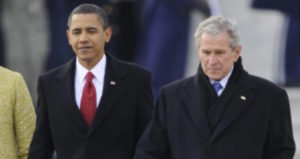
In recent speaking engagements
on the same day,
Presidents Bush and Obama reminded us: “This is not normal.”

So What?
Now, before we panic, all of this analysis doesn’t have to be a harbinger of doom. It might be that, but it could be an opportunity for America to reshape itself into a different future. Let’s not forget that such “reshapings” have happened before — some with positive results and some not so much —the 1860s, the 1910s/20s, the 1940s, the 1960s, the 1980s, are examples. Those who were paying attention during those times (and writing about it) have told us that the outcomes were not easily predictable nor were they easily controllable by those in power. But one lesson to be learned from all of that history is that those who care enough to participate can have an influence on the direction America will take. Those who simply stand and watch, will probably be surprised at how unimportant their views were. As the Winter Solstice reminds us that the world is ready to remake itself once again, those who try to influence the outcome, especially in concert with others, may be surprised at how much influence is possible. –> This is not new.
And Now?
So, after the “reflection and review” that the Winter Solstice evokes, does the coming sunlight bring with it a call for action? But what kind of action and by whom? In a Democracy, we are told that our voices are the most effective tools. And in a Republic, we select representatives to increase the reach and volume of our voices. So, it would make sense to let those representatives know what kind of action we intend.
Some sample pathways:
https://www.feinstein.senate.gov/public/
https://www.harris.senate.gov/contact/
https://swalwell.house.gov/
https://govapps.gov.ca.gov/gov39mail/
Finally, I’d like to cite two more writers who have offered useful advice for this time. One is poet Annie Finch, the author of “Winter Solstice Chant.” In an interview, she reminds us of the two-step process of moving from darkness to light: “If you don’t experience the darkness fully, then you are not going to appreciate the light.” The other — a well-known and eloquent gentleman advised us once to “become the change we seek.” Might be worth a try in the new year.
![]()
Grace — 2017

“I do not understand the mystery of grace — only that it meets us where we are but does not leave us where it found us.”
— Ann Lamott
Click here to download a PDF of this post: Grace_ConVivio_2017_LITE
= = = = = = = = = = = = = = = = = = = = = = = = = = = = = = = =
Extending a Tradition of Grace
On Saturday, December 9, 2017, Gretta and I continued our twenty-year tradition by attending an event called “A Cathedral Christmas.” It is an annual Christmas concert of the Men’s and Boy’s Chorus, orchestra, and pipe organ, at Grace Cathedral in San Francisco.
I have written about this annual event before on ConVivio (notably in 2009 and 2015), and each time my goal was to shine a light on the powerful effect it always has on our experience of the holiday season. For us, the tradition starts with its magnificent music, having the ongoing effect on the lives of real people of all types that thoughtful art can have. In addition to the music itself, the venue — Grace Cathedral on California Street in San Francisco — contributes its powerful presence and enduring heritage to our encounter with the holiday season. And last but not least, this event intentionally involves itself in the tenor of the times in which we live — for Grace Cathedral has long served to participate in the life of its broad Bay Area community not only with its Christian Anglican traditions, not only with its music, but also by contributing to the everyday issues and struggles, both diverse and universal, that affect the lives of our society.
The Venue: Grace Cathedral
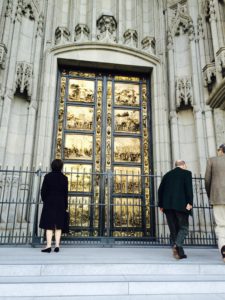 Grace Cathedral has long committed itself to be a house of prayer for all people and a place where all are welcome — prayerful or not. I observe that those two commitments set it apart from many other institutions that seem on the surface to be similar. Over the years I have noticed that the cathedral community provides many gifts, usually without a lot of fanfare, to people of all kinds whether they are part of their faith community or not. I learned, for example, of the hundreds of homeless who have been housed in the cathedral basement over the years. It also has lived up to a well-earned reputation for welcoming members of society who have not always felt welcome elsewhere in the Bay Area and the nation.
Grace Cathedral has long committed itself to be a house of prayer for all people and a place where all are welcome — prayerful or not. I observe that those two commitments set it apart from many other institutions that seem on the surface to be similar. Over the years I have noticed that the cathedral community provides many gifts, usually without a lot of fanfare, to people of all kinds whether they are part of their faith community or not. I learned, for example, of the hundreds of homeless who have been housed in the cathedral basement over the years. It also has lived up to a well-earned reputation for welcoming members of society who have not always felt welcome elsewhere in the Bay Area and the nation.
Left: “Ghiberti’s Doors,” copies of the 15th-century originals residing in Florence, reveal a welcoming heritage — the originals started the Italian Renaissance in bringing great art to everyday lives of real people.

Grace Cathedral: inside and out

Grace Cathedral can get colorful: inside and out
The Music
Usually, the Christmas concert focuses on two principal themes: 1) the joy associated with the birth of The Child — represented by well-known Christmas carols in the first and third segments of the performance — and 2) the peacefulness settling over the ‘Holy Land’ and the world, associated with the hope for peace that The Child would bring – represented by classic choral and orchestral music performed with sweetness and passion throughout the concert. The signature piece of the Grace Cathedral Music Ministry has always been a tune by Hugh MacKinnon called “Sleeps Judea Fair.” Gretta and I always look forward to this tune, in the final segment of the concert, as the highlight of the season. The lyrics and the slow, soft harmony of the voices recreate the joy and peace we expect from the season.

Settling into our usual seats at the acoustic center of the cathedral — one of America’s premier acoustical rooms — the expressions on the faces of the stained-glass figures of the saints all around the cathedral contributed to the warmth, peace, and harmony that we had come to expect. I opened the printed program and was pleased to find our favorite piece listed near the end of the program along with a few others I did not recognize.
The first segment of the concert contained the familiar choral pieces we had come to expect – like John Wade’s 18th-century carol “O Come, All Ye Faithful.” When the Men’s and Boys’ chorus left the altar for an intermission, the organ solo began. The organist’s right hand began by trying to play the familiar tune of “Christ Is Born Today,” while the left hand alternately ignored and ‘drowned out’ that melody with some deep, dissonant, and unfamiliar chords. I took this to represent the deep discord that “The Holy Land,” and much of the world, has been experiencing. We heard in the news that morning of the president’s announcement regarding the status of Jerusalem, which sparked some violent protests there and in Bethlehem itself.
Message received.
The peacefulness that The Child brought to this region centuries ago is not working out so well. I suppose this concert, to be true to its themes, needed to reflect that unrest and discord alongside the hope for peace and harmony that is the focus of so many of our prayers and greetings during this holiday season.
Then, after applause for the organ soloist, the singers returned for the final segment that traditionally conveys the message of peace and serenity culminating in their signature piece, “Sleeps Judea Fair.” It was as beautiful, soothing, and peaceful as always, offering a wish for “grace” — to Judea, to the world, and to us:
“Let the Christ Child, meekly smiling, infant wise all woe beguiling
Grant His grace to thee.”
–> Listen to it here — recorded live in Grace Cathedral:
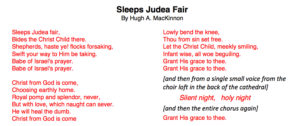
An Acknowledgement of the Times in Which We Live
After we were treated to that reward, the Episcopal Bishop of California, Rev. Marc Andrus, thanked us all for being there and gave us some words of wisdom for the season. His ministry, consistent with the ongoing mission of Grace Cathedral, is focused on the key issues of our time and place: peace and justice, immigration reform, climate change, civil rights for LGBT persons, and health care. On this night, he reminded us that these are hard times and drew a remarkable analogy for this season. He suggested that “our brothers and sisters of the animal kingdom” tend to slow down and prepare to go to sleep as the cold days and nights of winter approach. We humans, on the other hand, are called to do something different — it is a time for us to wake up, become more energetic, and do more of the things that need to be done, especially for others. He then suggested some specific ways we can do that in our own communities.
With that, the concert concluded with its final choral pieces. The lyrics of one of those, “A Stable Lamp is Lighted,” accompanied by the orchestra and organ, provided the stark reminder that our joy must be tempered with the reality of the hard times yet to come for the child born this day and, perhaps, for us all. Just before the finale, the voices intoned this piece of reality:

So then, we could celebrate: “Hark! The Herald Angels sing: Glory to the newborn king.”
The Message — More than hope for “Grace” during hard times
As we walked out of the cathedral on that beautiful December night, our world remains a place of suffering and danger, walking right alongside an enduring hope and optimism for which we Americans are famous. The message: we are right to be optimistic and hope for peace, harmony, and relief from suffering; but it is not enough to merely admire the problem and hope for the best. Rev. Andrus suggested that we must wake up and become active. We can start in our own families, neighborhoods, and towns, giving each other what we need, when we can, and contributing to organizations that do the work we can’t do on our own — some examples: Planned Parenthood, Reach Out and Read, Boys and Girls Clubs, Sierra Club, Valley Humane Society, American Civil Liberties Union, KQED, The Kidney Foundation, Grace Cathedral, and so many others. All are hopeful, optimistic efforts. We can make a difference, starting right here.
![]()
Yosemite: Change Revisited
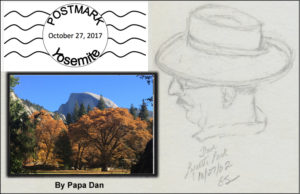
“It is easier to feel than to realize,
or in any way explain, Yosemite’s grandeur.”
— John Muir
“What a treasure to pass on . . .
(but make sure you bring your lunch).”
— PapaDan
Click here to download a PDF of this post:Yosemite, October 17, 2017
= = = = = = = = = = = = = = = = = = = = = = = = = = = = = = = = = = = = = = = =
Yosemite, October 17, 2017
 Sitting here in the middle of a meadow, looking up at Yosemite’s venerable Ahwahnee Hotel, it seems different in some way. Since you probably know some of the history of this place, you may ask with raised eyebrow and derision in your voice “Aw-come-on-now, what could possibly be different?” You might point out a few things like: the iconic stone-and-wood edifice in front of me has looked pretty much the same since it opened in 1927; the granite mountain, El Capitan, to the left of this view has looked much the same for, oh, 50,000 years or so; and the squirrels and blue jays who live here have been scurrying and squawking like this since the glacier melted — so, what could possibly be different?
Sitting here in the middle of a meadow, looking up at Yosemite’s venerable Ahwahnee Hotel, it seems different in some way. Since you probably know some of the history of this place, you may ask with raised eyebrow and derision in your voice “Aw-come-on-now, what could possibly be different?” You might point out a few things like: the iconic stone-and-wood edifice in front of me has looked pretty much the same since it opened in 1927; the granite mountain, El Capitan, to the left of this view has looked much the same for, oh, 50,000 years or so; and the squirrels and blue jays who live here have been scurrying and squawking like this since the glacier melted — so, what could possibly be different?
I’ll have think about it — you’ve asked a big question that demands a big answer; but I, of course, have a small answer:
—> It’s quiet. Nearly silent, actually. THAT’S what’s different.
Gretta and I come to Yosemite every April, for our anniversary, and one thing is a constant — Yosemite Falls is always flowing with its usual vigor. The sound is not merely of running water, but of chunks of ice and fragments of logs from the high country crashing down on the rock formations between the peak of the falls and the valley floor. All of that — plus the constant rushing of the water — creates a polyphonic orchestration complete with percussion, and you can hear it everywhere in Yosemite Valley from Half Dome to El Capitan to Glacier Point.
But, in October (for our second yearly visit), North America’s tallest waterfall is completely dry.
And silent. And, the silence of October is more noticeable than the sound of April. 
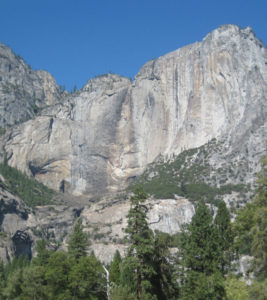
Upper Yosemite Falls (April) Upper Yosemite Falls (October/Dry/Silent)
But, before I claim that everything else around here is permanent, I come to realize that much has changed, and is changing all the time. Some of it matters, and some doesn’t.
The Water
• The water that feeds the Merced River from the opposite side of Yosemite Valley, across from Yosemite Falls (see the images below), originates at the granite dome of Liberty Cap, thunders down at Nevada Falls, sits awhile in the Emerald Pool, rumbles down at Vernal Falls, and ends up meandering through the valley floor in the Merced River. As the seasons change, that river trickles between the boulders at its low point here on October and then swells to a wide, white-water torrent in April. So, at least that much changes; but a wise observer might point out that all of this ebb and flow, the meandering and the raging, the silence and the music of the falls form a never-ending constant cycle in their seemingly eternal alternation between the extremes of life in this valley among these mountains. Yosemite has been here a very long time — longer than the life-span of humans on this planet — and the forces at work here seem to be eternal; BUT those forces are carving a work of art. Each time you look, if you are paying attention, it never looks quite the same as it did the last time you looked.
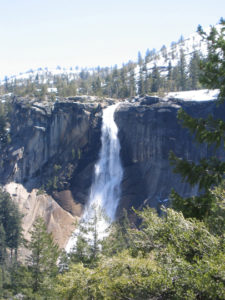

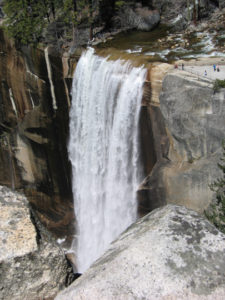
Nevada Falls Top of Vernal Falls/Emerald Pool Vernal Falls
The Granite
• Today, El Capitan slopes at a slightly different angle since last month when a slice of granite the size of an apartment building cracked and crashed down on one of its outcroppings and scattered giant boulders, many the size of automobiles, around its base. Rock falls happen all the time in Yosemite but they are seldom fatal (as this one was) and often not especially noticeable — unless you consider that this entire valley and its surrounding mountains were carved and shaped over thousands of years in precisely this manner. So, Yosemite changes its shape pretty much everywhere you look and pretty much all the time.
The Colors
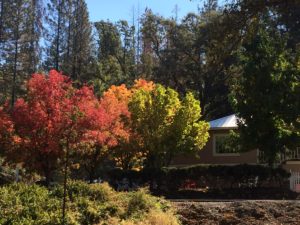
The colors speak for themselves. BUT, some of us have tried to speak for them — and maybe overdone it in the attempt, or not – like our old friend Mark Twain who tries to give us a glimpse, in words, of trees in the fall that change “from green to red, from red to green, and green to gold. The tree becomes a very explosion of dazzling jewels; it stands there, the acme, the climax, the supremest possibility of art or nature, of bewildering, intoxicating, intolerable magnificence. One cannot make the words too strong.” Or so he said.
Twain’s words appeared in the New York Times in 1876, not as evidence of change, but as evidence of permanence — describing something that has been repeated every year since long before humans were here to observe it. And here, now, in Yosemite, we see it once again.
Trivial Change
Now, if we’re going to make a list, some things HAVE changed here in Yosemite, just in the decades we have known it; but those are caused by humans and, therefore, less important:
• The Ahwahnee Hotel has been renamed The Majestic Yosemite Hotel. Why? — because the previous management of the hotel claims to “own” the name “Ahwahnee” after a coupla decades of association with it. The silliness of that view comes to light when you consider that the hotel was named for the Ahwahneechi Tribe who were associated with this part of the valley since about 600 years ago — long before the United States National Park Service granted a contract for restaurants and hotels (OK, long before the United States existed). So, Gretta and I still call it by its rightful name — The Ahwahnee Hotel.
• The Ahwahnee cocktail lounge, which used to serve excellent food all day long, now serves, well … OS (i.e., other stuff). We tried it for breakfast this time … I didn’t know it was possible to screw up yogurt and granola, but now I know. It has been our habit to enjoy a cocktail and tasty appetizers here in the late afternoon. The “cocktail” part endures as it should but the “tasty appetizer” notion is missing. It also used to feature a delightful piano player in the evening (he played everything from classics to smooth jazz to show tunes to classic rock — request almost anything, he knew it). Now the piano is gone to make room for three more tables and a sound system plays, well … OS.
• The Ahwahnee main dining room used to be a 5-star restaurant that attracted outstanding chefs. Now it is just a lovely high-ceilinged, grand building with an OK restaurant surrounded by breath-taking views, pouring from a mediocre wine list, and serving … well, you know, OS. It isn’t even the best restaurant in this valley.
• Oh, and there’s Degnan’s Deli, which used to be an ideal spot to interrupt a day of hiking by ordering a hand-made sandwich, salad, or soup, crafted with fresh ingredients. Now, it is dominated by a display case full of pre-packaged “gas-station-sandwiches.” And they’ve innovated: you can stand in line to order and pay using computerized kiosks and then stand in another line to pick up your order. This “innovation” succeeded in eliminating four employees who used to make your lunch to order from fresh ingredients and take your money at enough cash registers to avoid standing in line. You can still sit at their outdoor stone tables looking up at a stunning view of Glacier Point, but … my recommendation is that you bring your own lunch. Yes, it’s changed.
So, now I’ll stop whining
and tell you why we must continue to return here twice a year.
We come back for the many wonderful things that remain the same here in Yosemite Valley. Here are a few of those in the words of some of our friends:
• Words from Teddy Roosevelt: “There can be nothing in the world more beautiful than the Yosemite … and our people should see to it that [it] is preserved for their children and their children’s children forever, with [its] majestic beauty unmarred.”
• Words from John Muir: “Climb the mountains and get their good tidings, Nature’s peace will flow into you as sunshine flows into trees. The winds will blow their own freshness into you and the storms their energy, while cares will drop off like autumn leaves. As age comes on, one source of enjoyment after another is closed, but nature’s sources never fail.
• John Muir again: “It is easier to feel than to realize, or in any way explain, Yosemite’s grandeur. The magnitudes of the rocks and trees and streams are so delicately harmonized, mostly hidden.”
• Frightening words of warning from NYT columnist Nicholas Kristof: “I can’t help thinking that if the American West were discovered today, the most glorious bits would be sold off to the highest bidder. Yosemite might be nothing but weekend homes for internet tycoons.”
• Words from Robert Redford: “I spent two summers working at Camp Curry and at Yosemite Lodge as a waiter. It gave me a chance to really be there every day – to hike up to Vernal Falls or Nevada Falls. It just took me really deep into it. Yosemite claimed me.”
• Words from Dave Brubeck: “I used to take my mother to Yosemite. When got my driver’s license, that’s where she’d want to go, so I’d go take her there for two weeks.”
• Words from John Garamendi: “Maybe you weren’t born with a silver spoon in your mouth, but like every American, you carry a deed to 635 million acres of public lands. That’s right. Even if you don’t own a house or the latest computer on the market, you own Yosemite, Yellowstone, the Grand Canyon, Golden Gate National Recreation Area, and many other natural treasures.”
• Words from Ansel Adams: “Yosemite Valley, to me, is always a sunrise, a glitter of green and golden wonder in a vast edifice of stone and space.”
• More from John Muir: “During my first years in the Sierra, I was ever calling on everybody within reach to admire them, but I found no one half warm enough until Emerson came. I had read his essays, and felt sure that of all men he would best interpret the sayings of these noble mountains and trees. Nor was my faith weakened when I met him in Yosemite.”
• And, finally, from PapaDan: “Some years, one or more of our sons bring their families up here during the same week we visit, and we have the privilege of taking our grandchildren to the bank of the Merced River (below, left) or up to the base of Yosemite falls (below, right) and watch them enjoy the spectacle in amazement. What a treasure to pass on to the next generation!”
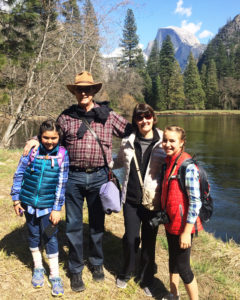

We’ll be back in April!
If you’re interested, click to take a look at a previous post on this topic:
“Of Permanence, Change, and a Sense of Wonder“
A Gratitude Attitude
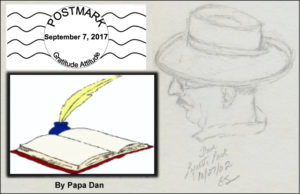
“Thank you, God, for this good life and forgive us if we do not love it enough.”
— Garrison Keillor
“On the off chance
that you won’t live forever,
maybe you should try to be happy now.”
— “Network News” (HBO)
Click here to download a PDF of this post: ConVivio_Gratitude_FINAL_Sept7_2017,pdf
= = = = = = = = = = = = = = = = = = = = = = = = = = = = = = = = = = = = = = = =
Let’s admit it — Americans are having quite a lot of anxiety these days. We could list the reasons, but they are in the news every day; and it is not my intention to trouble you with all of that. I’m thinking that we may have something more useful to do today. I grew up in a generation that acquired the confidence, or at least the suspicion, that we, collectively, have what it takes to solve difficult problems and improve our lives and the lives of others. We have been taught to believe that we can make a lot of progress — in economics, technology, and society. I will speak for myself and say that I was taught to believe in that progress by my parents, teachers, and leaders. For me, that body of belief is summarized in the distinctly 21st-century assertion:
“Yes, we can.”
But, today, we’re not so sure. Such optimism is feeling more and more like hard work.
That “dampening” of our collective self-confidence seems to have happened in a relatively short time. I suppose that uncertainty leads me to look back on my education for an alternate strategy. Just thinking out loud here — I was taught that “despair” was a personal failure. So, “giving up” was not acceptable. I was also taught that lashing out in anger against things I don’t like is not what reasonable, thinking, feeling humans should do. (I was taught that standard by observing what happened to the bully on the fifth-grade playground, when Sister Bernadette hauled him off to the principal’s office when he got too pushy on the tetherball court.) Also, somewhere in my Jesuit education back in the early 1970s, I recall hearing the saying:
“God, grant me the serenity to accept the things I cannot change,
courage to change the things I can, and wisdom to know the difference.”
This is part of what is known as “The Serenity Prayer” written by an American theologian named Reinhold Niebuhr back in the 1930s and passed on to me in a lecture by a Jesuit professor, Father Tennant Wright, at Santa Clara University in 1971. It is typically offered as a prescription for happiness in “the next life” if we accept hardships and trust in God. My observation, however, — at the urging of that same professor — suggested to me that we have opportunities, and responsibilities, to make a difference in “this life” that should not be ignored.
So, what does it mean? Is there a way to bridge the gap between “Yes, We Can” and “Serenity?” Can that “bridge” have some effect on the current anxiety I mentioned?
The Physiology of Gratitude
Really?! Physiology? OK, so I stumbled on a chapter in a book called “The Gratitude Diaries,” by Janice Kaplan. At first glance, as I saw it on the library shelf, I expected it to be mostly about talking yourself out of feeling bad. But, as I looked into one chapter — you know how you grab a book off the shelf and open it to a random page to see what’s inside — I discovered something else. On page 179, I found some very mundane and familiar medical science associated with stuff like bacteria, the body’s immune response to bacteria, the functioning of neurotransmitters, and how white blood cells swarm to the site of an infection and attack the problem by “gobbling up bacteria.” In doing that, the white blood cells leave behind inflammation, which can become dangerous in itself. You knew that; BUT scientific studies aimed at understanding inflammation have uncovered some unexpected and intriguing connections.
So, here’s the really interesting part — turns out that the immune system doesn’t ONLY respond to “germs,” it may also respond to emotions. Kaplan reports that a couple of researchers at Johns Hopkins University and Georgetown’s National Institute of Mental Health observed that worry, anger, or fear activates those same white blood cells. Even though they don’t have anything specific to attack, they leave a trail of dangerous systemic inflammation.
–> Long-story-short — one conclusion from their studies: expressing gratitude could actually inhibit that systemic inflammation effect and prevent our immune systems from causing our bodies to react harmfully to fear and worry.
“A sad soul can kill you quicker, far quicker, than a germ.” — John Steinbeck
SO, the anxiety many of us are feeling about the bad news all around us can actually do physiological damage and inhibit our ability to cope with the world, to make good decisions, and to experience happiness. People are beginning to notice. Friends of mine tell me that they have been trying to avoid watching “the news” because they don’t like the way it makes them feel. Turns out that the intentional expression of gratitude for the goodness we see around us and the people who bring it to us — in place of focusing on the troubling news — can demonstrably counteract those very real effects on our health. The operative word for this effect is healing.
The Gift of a ‘Gratitude Attitude’
Let’s admit it — we have much to be grateful for. The very fact that today’s news is disappointing confirms that we have experienced better; we have been exposed to good people doing generous and kind things for us and for others, both locally and elsewhere. We have enjoyed periods of relative stability and we have survived hard times, both individually and collectively. While we have endured troublesome people (you know who they are), we have also enjoyed people who have lifted us up and brought us kindness when it was needed (and you know who they are). In fact, there have been times when WE have BEEN those people for others. Science tells us that there are positive physiological effects of intentional gratitude; AND we have seen that serving as an example of gratitude to others can make a difference for us all.
“At times our own light goes out and is rekindled by a spark from another person. Each of us has cause to think with deep gratitude of those who have lighted the flame within us.”
— Albert Schweitzer
Heck, some of you have done that for me — and you know who you are — so, thank you.
Obligations?
So, if we acknowledge that focusing on “the bad news” can do real harm, does that knowledge carry with it obligations to each other — and to those who come after us?
If future generations are to remember us more with gratitude than sorrow, we must achieve more than just the miracles of technology. We must also leave them a glimpse of the world as it was created, not just as it looked when we got through with it.
— Lyndon B. Johnson
I have to acknowledge that my generation brought us to the “bad news” state we are in. Some might suggest that this conundrum — the apparent tension between “Yes, We Can” and “Serenity” — strains our impulse to resist the “bad news,” and by resisting, risk allowing that resistance to dominate our daily lives. Shouldn’t we resist? Isn’t that part of the “Yes, We Can” confidence we were taught to have?
Let me suggest that it is not a cop-out to say we must do both — simultaneously. I agree with the urgency of resistance — staying informed of the paths our nation is traveling, putting ourselves in a position to make a difference, contributing to organizations that can help those who are harmed by the “bad news,” and supporting those who want to push progress forward (yes, we call them “progressives”). At the same time, the science suggests that we must support each other by offering our “Gratitude Attitude” wherever we can. I must remind myself, in spite of my disappointment with “the bad news,” that I have a good home in a good community, a family full of successful and talented grown children and smart and curious grandchildren, and a wife who shares my gratitude and appreciates “us.” I have friends who demonstrate their gratitude for the goodness they have and for the time we spend together. I enjoy hearing their expressions of gratitude for their own good lives. I submit that we have an obligation to share our expressions of gratitude with the people in our lives — the people we know well and those we meet along the way. They need to hear our gratitude just as much as we need to hear theirs. OK, it’s hard to do both things at once — to “resist” while also maintaining a “gratitude attitude.” But we must, because …
“Yes, we can.”
“The Summer of Love” — 1967

“The Summer of Love” — 1967:
More Than A Summer
“Do you believe in Rock & Roll?
Can music save your mortal soul?
Can you teach me how to dance real slow?”
— Don McLean (from “American Pie”)
Click here to download a PDF of this post: ConVivio_Summer_1967_V2
= = = = = = = = = = = = = = = = = = = = = = = = = = = = = = = = = = = = = = = = = =
The Music of My Generation
The great music of my generation reached a climax in 1967. That historic musical moment — widely recognized as the pinnacle of the music of my generation — “warmed up” around 1962-5, reached its peak in the “Summer of Love” of 1967, and culminated in the last few years of the sixties leading to the grand finale: “Woodstock” in August of 1969.
Since most of my generation was in high school at the time, we tend to think of “1967” as the school year that began in the fall of 1966 and ended late in 1967, when my friends and I settled into our senior year. Of course, nothing of cultural importance begins and ends that abruptly and crisply, so we will consider those dates to be approximate. For most of you “of a certain age,” these details may not be new, just reminders of a time in your own life.
It Started With Something New: Buying Records


I began buying vinyl records in 1964, starting with the purchase of my first Beatle album, “Introducing the Beatles,” in January (I still have it) followed a couple of weeks later by “Meet the Beatles” (my son Ben has it). This was an important milestone in my teenage life and the act of buying records quickly became a four-step ritual for me. Here was the pattern:
Step 1. I would hear something exiting on the radio played by one of the two important disc jockeys in the bay area on KYA:
— “Emperor” Gene Nelson was “The Emperor” because his loyal following carried “Royal Commando” cards, he issued his own royal currency (accepted only within “The Empire”), and counted down the “Top Thirty” every Saturday morning.
— “Big Daddy” Tom Donohue advertised acne creams and opened his show with the line: “This is your Big Daddy Tom Donohue. I’m here to clear up your face and mess up your mind.” He co-produced the Beatles last public appearance at Candlestick Park August 29, 1966. About this time, a friend turned me on to something new: FM Radio! KSJO in San Jose played music and said things that could not be heard on AM radio. Tom Donohue pioneered “album-oriented” radio at KMPX FM. We called these FM stations “underground radio.” (Our parents did not listen to these stations.)
Step 2. I would walk uptown to the record store (Don McLean later called it “The Sacred Store” in his classic song “American Pie”). I would ask the lady behind the counter if I could listen to a particular song. She would play it on a turntable if it was on a 45-RPM single (99 cents); but she wouldn’t play an album. In the case of an album, I would inspect the album cover and put it back in the rack for later consideration (albums cost more — initially, a dozen songs for $2.99.
Step 3. After due consideration (usually a day or so), I would walk back to the record store and buy the album (except in the case of a Beatle album — in that case I would have bought it immediately, without question, the first day it was released.
Step 4. As soon as I got home, I would play the entire album from beginning to end without delay or interruption, making judgments about which songs were “hits” and deciding if I preferred one side over the other. Sometimes a friend joined in this part of the ritual. In many cases (again, except for the Beatles) I ended up playing the preferred side almost exclusively after making that judgement.
My Dad encouraged me to buy records, as he had done. I still have his 78-RPM recordings of Cole Porter, Dale Carnegie (“How To Win Friends and Influence People”), and Red Motley (“Nothing Happens Until Somebody Sells Something”), and the soundtracks I heard growing up: “Carousel,” “My Fair Lady,” “Camelot,” and a little classical and opera. I don’t think he really understood my music, but I think he figured that it didn’t do any harm.
Most popular songs, especially in the early sixties, were released on 45-RPM “singles,” with a “hit” song on one side — the “A” side — and usually a throw-away song on the “B” side that would seldom be heard on the radio. The Beatles broke that mold by releasing singles with great songs on both sides. These were almost uniformly three minutes long until July of 1965 when Bob Dylan released “Like a Rolling Stone,” which was more than six minutes long. At first, radio stations played a truncated version; but it quickly became a world-wide hit, broke through that constraint, and we heard it on the radio in its entirety. Why was it such a big deal? Even though it wasn’t particularly ‘musical,’ its “street poetry” described some of the familiar experiences of many young people of my generation and then asked:
“How does it feel?
To be on your own,
with no direction home,
a complete unknown,
like a rolling stone.”
It seemed to touch something deep in the hearts of young people experiencing in the strangeness of growing up in the second half of the 1960s. There would be more to come.
So, What Records Did I Buy?
I bought a few singles; but, after a while, I stopped buying singles and stuck with albums. This change coincided with the trend among popular musicians starting around 1965-66 to record an entire album of their best songs, several of which were “hits” that might have been played on the radio. So, albums contained a lot more storytelling and developed more important themes than songwriters could convey in one three-minute song. Many of the songs of the time reflect the ideas and feelings that mattered to so many of us during that period.
Below is a link to a PDF list of the record albums released during this time that I bought then or over years that followed. It turns out to be a pretty good indicator of what was popular among teenagers, at least in my high school at the time. AND it serves as the musical content that led to the “Summer of Love” in 1967 and other major music events of 1968-9. I bet many of you had these same records or at least remember hearing many of them, either at that time or later –>–>–> AND I’d love to hear from you about the music that was important to you during this time, whether you were alive then or not — since many of you grew up listening to your parents’ records of these songs that they continued to play in later years (as I did).
Records I bought from 1964, with release dates (underlined titles are links):
Click here: Dans_Records_1964-1968.pdf
What actually happened during 1967?
The term “Summer of Love” originated with the formation of the “Council for the Summer of Love” in the spring of 1967 as a response to the convergence of young people on the Haight-Ashbury district in San Francisco. The Council was composed of The Family Dog, The Straight Theatre, The Diggers, The San Francisco Oracle, and approximately twenty-five other people, who wanted to plan for the influx. The Council also assisted the Free Clinic and organized housing, food, sanitation, music and arts, and coordinated with local churches and other social groups. So, there was some preparation.
- January 14 The Human Be-In takes place in Golden Gate Park, San Francisco; setting the stage for the “Summer of Love.”
- January 28 – The Mantra-Rock Dance, called by some the “ultimate high” of the hippie era, takes place in San Francisco, featuring Swami Bhaktivedanta, Janis Joplin, The Grateful Dead, and Allen Ginsberg.
- June 16-18 – Most consider the three-day Monterey Pop Festival at the Monterey County Fairgrounds to be the focus of “The Summer.” That event — fifty years ago this week (celebrated last Sunday) — brought together thousands of people to see and hear many of the most well-known rock & roll musicians of the era — notably, The Byrds, Jefferson Airplane, Jimi Hendrix, David Cosby, The Who, The Association, The Doors, Hugh Masekela, Grateful Dead, Country Joe and the Fish, Janis Joplin (Big Brother and the Holding Company), Eric Burden (Animals), Otis Redding, Simon & Garfunkel, and The Mamas & the Papas. The event essentially launched careers of some performers who had not yet achieved national recognition — Janis Joplin, Laura Nyro, Canned Heat, Otis Redding, Ravi Shankar, and Steve Miller are examples.
Some notables intended to perform . . . but:
— The Beatles decided that their music had become too complex to perform live and did not perform (and never toured again).
— The Beach Boys, although Brian Wilson was a leader in the planning of the event, decided not to perform — perhaps their music came out of a different mindset (surfing and fast cars) and didn’t quite fit into this particular “Summer.”
— Donovan, The Rolling Stones, The Kinks, among others, couldn’t get visas to enter the US because of drug arrests.
— Dionne Warwick had a conflicting gig at The Fairmont in San Francisco.
— Bob Dylan declined because he was still recovering from his motorcycle accident. (Hendrix paid tribute to him by performing “Like a Rolling Stone.”
— Frank Zappa (Mothers of Invention) refused to share the stage with SF performers he considered to be inferior. (Huh?)
— Organizers rejected some who asked to perform, like The Monkees (thanks); and some (like Cream) backed out hoping to perform in a venue that would provide “more exposure” (ooops!).
Other cultural/musical events took place around the world in places like New York, London, and elsewhere; and — related — on October 17, the musical “Hair” opened off-Broadway on October 17 and moved to Broadway the following April. But “That Summer” also featured a number of distressing public events. It was a difficult time in America: several large and violent anti-war demonstrations did serious damage that summer and several multi-day race riots erupted in Tampa, Buffalo, Newark, Plainfield, Minneapolis, Detroit, Milwaukee, and Washington DC, leading to more than 100 deaths and significant disruptions in communities and colleges across America. So, there was more going on than just the music.
Was It Just the Prelude?
Most would say that “The Summer of Love” was the focal point of the development of the music of the time; BUT, as an event, most say it was just the prelude leading up to the central musical event of my generation. “Woodstock” took place August 15-18, 1969, on at Max Yasgur’s 600-acre dairy farm near New York and was attended by over 400,000 people and millions of us will claim “I was there.” (I was, uh, there.) BUT, if you look at the music that was performed at Woodstock and the musicians who performed, I think you’ll agree that the music emanated from the inspiration of 1967. We can save THAT topic for another time. The cultural event had its own significance. For the purpose of remembering “The Summer of Love,” it was all about the music.
And, Yes, It Had a “Funeral”
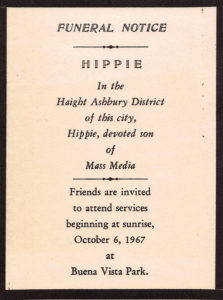
After many people left at the end of summer to resume their college studies, those remaining in The Haight wanted to commemorate the conclusion of the event. A mock funeral entitled “The Death of Hippie” was staged on October 6, 1967. Organizer Mary Kasper explained the message:
“We wanted to signal that this was the end of it, to stay home, bring the revolution to where you live, and don’t come here because it’s over and done with.”
Mock Funeral Notice
But the Music Didn’t Die
Life got tougher in America: the Vietnam War became more intense, as did protests against it, a cultural divide opened between generations, and the assassination of Rev Dr. Martin Luther King Jr. sparked riots across America. BUT — the music didn’t die. We bought the records, listed on the radio, our children heard those records growing up in our homes, and — after these fifty years have passed, the songs of that era continue to be popular landmarks in music, culture, and literature.
![]()
And Yet, Optimists Speak
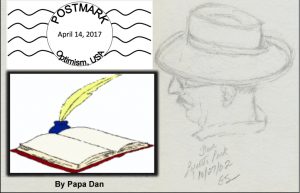
—————–
“In case you thought
optimism was dead,
the average pencil
is seven inches long
with just a half-inch eraser.”
— Robert Brault
—————–
—————–
—————–
—————–
Spoiler alert —–> Yes, it turns out that I am an optimist. Honest. Really. Maybe you are, too?
These days, such a label often elicits an insulting response, such as “How can you be an optimist? Aren’t you paying attention? Everything is going to hell in a handbasket. Just open the newspaper any day of the week.” Or “Anyone with experience knows better than to expect the future to be better than today.” Or “Right, an optimist, but I bet you look both ways before you cross the street, don’t you?”
My father was an optimist and I acquired that attribute from him. In fact, believe it or not, when he was an insurance agent back in the 1950s, he was actually the president of a club of other businessmen in town, called “The Optimists Club.” They had an “Optimist’s Creed,” which they recited at meetings. (Yes, they actually had meetings.) He was an optimist in earnest. As a successful businessman who had not completed the eighth grade and was the son of an illiterate immigrant, it was actually part of his experience to expect positive surprises.
The Optimist Creed was in a frame on the wall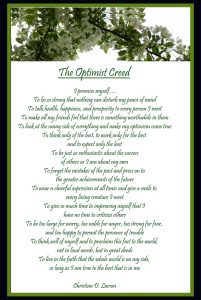
in my Dad’s office
<– <– <– — it looked like this
Why do I remember this? Back in the late
1950s, my Dad kept his office open until noon
on Saturdays; and sometimes he took me to
the office with him. I’d sit in the back of the
office and jam up the adding machine. (I think
I was supposed to be watching him in action
and developing an appreciation for the
insurance business. His plan was to hang a
sign outside that would say “And Son” and I
would one day take over the business.) But,
my actual accomplishment was to jam up the
adding machine. But I digress … why did I
bring this up? Oh yes …
A friend of his, Jerry Bassett, also a member of the Optimist Club, had a call-in talk show on the local radio station (KKIS in Pittsburg, CA). On those Saturday mornings, the show was playing on the radio in the office. One day, Jerry wasn’t getting enough callers; so, he called my Dad during a commercial and told him “I’m dying here, Al. Can you call me up with something interesting to talk about? Whuhduhyuhsay?” So, my Dad took the framed “Optimist Creed” off the wall and called him back.
I was stunned. There was my Dad, sitting at his desk, telling Jerry Bassett about the Optimist Club and why it meant so much to him. He actually read the Optimist Creed over the phone and I sat there and listened to my Dad on the radio — with the confusing five-second delay — talking about what it meant to him to be an optimist. Apparently, others called in and wanted to talk about it; so, I guess it sorta saved the show for Mr. Bassett.
For me, a ten-year-old sitting in my Dad’s office on a few Saturday mornings, while I didn’t acquire an interest in the insurance business, I did develop an appreciation for the idea of being an optimist — just by watching, listening, and observing how people responded to him.
I learned over time from my Dad and from my own observation, that being an optimist meant a number of different things to him and to others. As I read the news and listen to what people say about it all, I grant you that it requires some effort to be optimistic these days (I’m sure I don’t have to tell you that); but it seems that many of us have different views of what that might mean. So, let’s explore some of the different meanings people attribute to optimism — borrowing some words from a few others — and then, let’s try to figure out what it might mean to us to be an optimist today.
Let’s ask around. It seems there are different kinds of optimists.
The Delusional Optimist
This is a guy who falls out of the top floor of a ten-story building. As he passes the floors on his way down (the ninth, then the eighth, the seventh, etc), he says to people on those floors as he flies by on his way down: “I’m doin’ OK so far.”
This is the optimism that gets the most disdain from “realists” who are paying attention to the news (maybe you and me). This delusional optimist doesn’t get a lot of respect. He’s just wrong. In reaction to this rosy view of a harsh world, some pessimists call themselves realists and seek comfort by lowering their expectations:
The ‘Optimism’ of Lowered Expectations
“A pessimist? That’s a person who has been intimately acquainted with an optimist.”
— Elbert Hubbard
Some of us go to great lengths to avoid being called a fool. A pessimist makes clear that the world can be a bad place for real people; and asserts that a fool is someone who thinks it can be otherwise. Others, like Winnie-the-Pooh’s friend Eeyore, try to solve the problem by keeping their expectations low:
“It’s snowing still,” said Eeyore gloomily.
“So it is.”
“And freezing.”
“Is it?”
“Yes,” said Eeyore. “However,” he said, brightening up a little, “we haven’t had an earthquake lately.”
― A.A. Milne
The Patient Optimist: Two versions
“Everything will be okay in the end. If it is not okay; it is not the end.”
— John Lennon (I bet you thought somebody else said that first, didn’t you?)
This is the classic belief that, at some time in the future, something better will happen if you just wait for it.
Lin-Manuel Miranda portrays Aaron Burr as a different kind of patient optimist in ”Hamilton, the Musical.” Burr and Alexander Hamilton are both orphans who have an opportunity to impact history. Burr waits cautiously for the chance to fulfill his destiny in a very tough world and resents Hamilton’s more confident approach. He sings to the audience, “Wait For It” (click here to hear the entire song):
Life doesn’t discriminate between the sinners and the saints,
it takes and it takes and it takes
We rise and we keep living anyway, we rise and we fall and we break
We fall and we make our mistakes.
and if there’s a reason I’m still alive when so many have died,
then I’m willin’ to-
Wait for it …
Wait for it …
In the same show, Hamilton — expecting much more than waiting, says to Burr …
“If you don’t stand for something, Burr, what will you fall for?”
― Lin-Manual Miranda
Hamilton doesn’t respect those who are reluctant to risk making a commitment to something greater than themselves — a criticism he leveled at Aaron Burr, early in their fatal “rivalry.” Burr, wary of commitment, was held back by a feeling that ‘making a difference’ might be futile — or dangerous. In our own time, this very year, some of us fear that the prospects for a positive future are so bleak that there is no point in trying and the challenges we face are too big for us to make a difference. But there are optimists among us who remind us that it is too early to give up and we are pretty useless if we do:
The Resigned Optimist (aka the “No Other Choice” optimist)
“For myself I am an optimist. It does not seem to be much use to be anything else.” ― Winston S. Churchill
And then, some among us feel that we all have some responsibilities to those who will come after us:
The Burdened Optimist (aka “The Future has its eyes on you”)
“There is some good in this world, and it’s worth fighting for.”
― J.R.R. Tolkien
“The future belongs to those who give the next generation reason for hope.”
― Pierre Teilhard de Chardin
And then, some take that responsibility deeper, especially during difficult times (like war):
“Lest I keep my complacent ways, I must remember somewhere out there a person died for me today. As long as there must be war, I ask and I must answer ‘was I worth dying for?’ ” ― Eleanor Roosevelt
Ouch. Eleanor insists that we need to be worthy of the sacrifices others made for us. That brings us back to the need for a plan to make something better and the need to follow through with that plan. Optimism, of this variety, requires action since positive change doesn’t happen by itself. So, in order to avoid being called a fool, a person would have to make something better. You can’t just wait for it. So, this optimist must be bold and forceful, like this guy:
The Determined Optimist (aka “Just try and stop me”)
“My optimism wears heavy boots and is loud.” — Henry Rollins
The determined optimist has to make a show of it and get some attention. But then, that begs the question: ‘What are you actually going to DO to justify all of that stomping around? What are you going to accomplish?” What is worth the risk of being disappointed or being called a fool? From time to time, this brand of optimism can be sufficient, but not always. Some simply take a practical approach and compare optimism to a fruitless alternative:
The Confident Optimist (aka “Look, we know how to do this”)
“Pessimists are usually right and optimists are usually wrong but all the great changes have been accomplished by optimists.” ― Thomas L. Friedman
So, the need to accomplish something rears its (ugly/beautiful) head:
“One thing we know beyond all doubt: Nothing has ever been achieved by the person who says, “It can’t be done.” ― Eleanor Roosevelt, You Learn by Living
“BE the change you wish to see in the world.” ― Mahatma Ghandi
Like Eleanor and Mahatma, some notable optimists in our own time insist that despair is not helpful and we need to take responsibility to encourage others. You know this guy:
“The only thing that’s the end of the world is the end of the world.”
“Yes, we can.” ― Barack Obama
Not all of us are going to run for office, speak to an audience of millions, and change the world. For many of us it may have to be enough to serve as a good example to encourage others — our children, their children, people we meet — to BE the change that is required. Maybe all it takes is a few words of encouragement to younger minds — maybe words like “Yes, we can.” It turns out that some outcomes are possible even if we haven’t seen them before.
The “Who’s Going To Stop Me” Optimist (aka “What do you mean it can’t be done?”)
“Sometimes you have to pass through the fire swamp to get where you need to go.”
“But, we’ll never survive.”
“Nonsense. You’re just saying that because no one ever has.”
— William Goldman, The Princess Bride
Is it often difficult to distinguish the “Delusional Optimist” (you remember, the guy falling out of the building) from the “Who’s Going to Stop Me” optimist, but the difference matters. Many optimists are occasionally intimidated by the enormity of great challenges — finding that important things seem to require great effort, by a great many people. But some wise people suggest the opposite approach: taking small steps in the company of just a few people:
The “Incremental” Optimist
“The secret of getting ahead is getting started. The secret of getting started is breaking your complex overwhelming tasks into small manageable tasks, and starting on the first one.” — Mark Twain
“A year from now you will wish you had started today.” -Karen Lamb
“A small group of thoughtful people could change the world. Indeed, it’s the only thing that ever has.” – Margaret Mead
“Thou hast seen nothing yet.” — Don Quixote de la Mancha (Cervantes)
It turns out that some outcomes are possible even if we haven’t seen them before. Some look at the mixed advice we hear and get discouraged by disappointing outcomes — but some don’t.
The “Maybe this time” Optimist
One thing seems essential — that we do not settle into the extremes of “always” and “never” — that we find an optimism based on the idea that, sometimes, good outcomes are possible. Sometimes. This poem by Sheenagh Pugh reminds me that, whichever variety of optimist I decide to be, on a particular day, there is reason to believe in positive outcomes. They don’t happen by themselves, they do require our efforts, but they happen … sometimes.
And that may be enough. I may be this kind of optimist …
Sometimes
Sometimes things don’t go, after all,
from bad to worse. Some years, muscadel
faces down frost; green thrives; the crops don’t fail;
sometimes a man aims high, and all goes well.
A people sometimes will step back from war;
elect an honest man; decide they care
enough that they can’t leave some stranger poor.
Some men become what they were born for.
Sometimes our best efforts do not go
amiss; sometimes we do as we meant to.
The sun will sometimes melt a field of sorrow
that seemed hard frozen: may it happen for you.
— by Sheenagh Pugh
Sorting Out the Voices
So, what have I learned from all of these voices? My Dad taught me about “sometimes” as his Dad taught him. The other side of “sometimes” is that sometimes we need to stomp around and be “The Determined Optimist,” and march in the street with other determined optimists. Sometimes the best we can be is “The Resigned Optimist” and simply try not to give up. Sometimes we are forced to be “The Patient Optimist and “Wait for It.” Sometimes we can see a middle path and serve as a “Confident Optimist” and contribute to incremental change by contributing to organizations that can accomplish important changes with lots of small donations (examples: organizations like the ACLU, Planned Parenthood, PBS, The Yosemite Conservancy, Meals On Wheels, your local library … you probably have your own list.) Those among us with more imagination and determination may find ways to “Be the change we seek.” Perhaps our task, if we can’t BE one of them, is to support those who do.
![]()
Click here to download a PDF of this article: Optimist_ConVivio_April14
And It’s Still Just February
Sandburg— 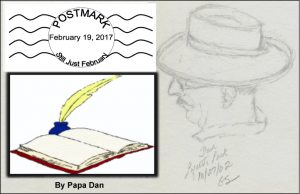
Sandburg
Sandburg
“Five hundred twenty-five thousand
six hundred minutes.
How do you measure a year
in a life?”
— from “Rent”
Sandburg
+++++++
+++++++
Some Years Stand Out
I recently wrote a piece asking “What kind of year was 2016?” Some of you participated by contributing to ConVivio’s “Thirty-Word Challenge” and sent me your assessments of how 2016 will lead to 2017. You sent me some great words. (Take a look: https://convivio-online.net/looking-back-at-2016-ahead-to-2017.) Maybe though, the bigger question is … what difference does a single year make? Is 2017 going to be just a detour or will it be a major turning point?
Over the course of my 66+ trips around the sun, some years stand out in memory — some were good, some bad, and some were turning points in the flow of history. During the first half of the 2017 Super Bowl (while the Falcons were still blowing out the Patriots), I was sitting with an enlightened friend of mine (I’ll call him Judge Danny) and somehow we got to talking about years. At halftime, the TV commentators were talking about other Super Bowl blowouts, like the 49er destruction of the Broncos (55-10) in 1990.
PapaDan: 1989 was a memorable year, too. The 49ers beat the Bengals…
Judge Danny: Then there was the 1989 World Series with the Giants and A’s…
PapaDan: I don’t want to talk about it. [Changing the subject] That was also the year the Berlin Wall came down, and revolutions popped up all over Eastern Europe.
Judge Danny: Right…the end of the Cold War.
From sports we segued to “most momentous years.”
PapaDan: 1969 — Armstrong walked on the moon…
Judge Danny: And returned home. 1963 was unforgettable. It hurt bad. I was thirteen.
PapaDan: Yes, it hurt. 1964 was better, the Beatles and lots of great music. And 1951 was a huge year in baseball. Growing up, I read all about Bobby Thompson’s “shot heard ‘round the world.” Russ Hodges went crazy: “THE GIANTS WIN THE PENNANT! THE GIANTS WIN THE PENNANT!” 1962 was another good year for the Giants, less dramatic but a big thrill.
Judge Danny: I remember; but those were just baseball, right?
PapaDan: Right. So, in our lifetime, what do you figure was the most important year of all?
Judge Danny: We’re the same age, right? We both graduated in 1968. That was the biggest year since we’ve been around. Don’t you think?
PapaDan: Wow. Yes. No question about it. 1968 was a turning point.
We were interrupted by the second half kickoff and the subject of the “most important year” didn’t come up again — we were too busy bemoaning the collapse of the Atlanta Falcons. The next morning, though, after depressing myself with the newspaper, I decided that Judge Danny had been right — 1968 was the single biggest turning point during my lifetime, both for me and for America. There was a lot going on during several years of the turbulent sixties. But 1968 stands out. The title of an important research project on the subject said it well:
“The 1968 Project — A Nation Coming of Age.”
What did we see on the Evening News in 1968?
It was a year of “just one damn thing after another.” President Lyndon Johnson began the year with his State of the Union Address noting that “Our country is challenged at home and abroad,” and the challenges began immediately. One week later, North Korean patrol boats captured the Navy intelligence ship “Pueblo” within their 12-mile territorial waters, initiating a dangerous year-long international crisis. Then, a week later, the Vietcong launched the brutal “Tet” offensive; massive numbers of troops poured out of the jungles and devastated dozens of cities and towns. The surprise invasion of the U.S. Embassy in Saigon and sudden large-scale deaths of American soldiers quickly turned public opinion against the war. Two days later, Richard Nixon declared his candidacy for president. The following week, the Pentagon announced the largest one-week casualty figures of the war and Walter Cronkite, having just returned from a tour of the battlefields, reported that the best America could expect in the war was “a stalemate.” In the White House, President Johnson said privately, “If I’ve lost Cronkite, I’ve lost Middle America.”
–> All that, and it was still just February.
As the year unfolded, the news continued to surprise and distress a lot of people.
— March 12: Senator Gene McCarthy nearly defeated the sitting president of his own party in the New Hampshire primary. Four days later, Senator Robert Kennedy withdrew his support of President Johnson and announced his candidacy.
— On March 31: President Johnson, overwhelmed by anti-war pressure, announced, “I shall not seek, and I will not accept, the nomination of my party for another term as your President.”
— April 4: one week after leading a march in Memphis that turned violent, Dr. Martin Luther King, Jr., was shot and killed while planning his “Poor People’s March on Washington,” sparking riots across the country. Robert Kennedy, hearing of the murder just before giving a speech in Indianapolis, stood up at a street corner and gave an emotional extemporaneous eulogy — pleading with the mostly black audience “to tame the savageness of man and make gentle the life of the world.”
— On April 29, the musical “Hair” opened on Broadway, dramatizing powerful social and political change and a “generation gap” between those who were coming of age in 1968 and their parents’ generation.
— May 6: In Paris, 5,000 students marched in what was soon called “Bloody Monday,” the most violent day of a student revolt. Sympathetic strikes involved nine million French workers.
— June 5: Robert Kennedy won the California Presidential Primary, a victory that all but assured him the party’s nomination. Minutes after his victory speech, he was assassinated.
— July 24: at the Newport Folk Festival, singer Arlo Guthrie performs his 20-minute ballad “Alice’s Restaurant” to rave reviews. (“You can get anything you want, at Alice’s Restaurant.”)
— August 8: The Republicans nominated Richard Nixon to be their presidential candidate.
— August 20: The Soviet Union invaded Czechoslovakia with 200,000 troops.
— August 26: The Democrats nominated Hubert Humphrey for president. Outside the convention, protests erupted and Chicago police arrested nearly 200 people and sent more than 100 others to hospitals with “night-stick” head injuries.
— September 7: “Women’s liberation” groups protested at the Miss America contest in Atlantic City. While nothing actually burned, the phrase “symbolic bra-burning” was coined.
— October 12: The Summer Olympics opened in Mexico City, boycotted by 32 nations to protest South Africa’s participation. Two U.S. medal winners in the 200-meter dash, gave the “Black Power” salute during playing of the Star-Spangled Banner at the medal ceremony.
— November 5: On Election Day, 31,770,000 (43%) voted for Nixon. 31,270,000 (42.7%) voted for Humphrey. 9,906,000 (13.5%) voted for George Wallace.
— November 14: On “Turn In Your Draft Card Day,” young men across the country burned their draft cards and protested the Vietnam War.
— December 12: Robert and Ethel Kennedy’s eleventh child, Rory, is born.
What was it like for those of us watching all of this?
For me and others born in dead-center in the 20th century, 1968 was a singular turning point. We were “The Class of ’68” at Antioch High School. Except for the stories Walter Cronkite told us on The Evening News, the future looked bright. Like most of my high-school friends, I lived in a bubble of stability and certainty. High school was good for me — I got good grades, I played varsity sports, and in May I was accepted to the college of my choice (Santa Clara University). I had a supportive family who encouraged me every step of the way, and I was surrounded by friends who were a lot like me. But 1968 was also the year I got my first look at discrimination, major disappointment, and local cruelty.
Racial Discrimination
I started kindergarten in Antioch in 1955 and it took me until I started high school to notice that there had never been ANY black students in my school or anywhere in my town. The first black kids I met were on the basketball court when Antioch High played Pittsburg High.
That year, Antioch’s foreign exchange student was a girl from South Africa. Apartheid was still in full force there and I remember hearing her speak proudly about “separate but equal.” It didn’t sound right to me.
Then came “the big story.” The parents of a student two years behind me (class of ’70) had moved to Antioch at the beginning of the school year. As new arrivals, they were visited by the city’s “Welcome Wagon” and given a basket with various household products, advertisements for local stores, and advice about the town. The “Welcome Wagon” greeter assured this new family that “This is a nice town full of nice people. And don’t worry, you won’t find any blacks here — the realtors and landlords in town make sure of that.” The new neighbors didn’t like that at all. They asked around and found that others had heard the same thing. Long story short, they filed a class-action lawsuit that gave Antioch an apparently well-deserved reputation for racism. I was stunned — discrimination in MY town!
Optimism, Disappointment, Cruelty, and Regret
Before midnight on June 5, 1968, I went to bed happy. I had turned off the TV following Robert Kennedy’s victory speech after winning the California Primary. “Let’s go on to Chicago and win there,” he concluded. It was one of the last three “school nights” before my graduation on Friday. I was a huge fan of the Senator — my father passed on to me that we were “Roosevelt/Kennedy Democrats.” I wanted very much for RFK to become president and pick up where his brother had left off. I figured Bobbie would end the war (and, therefore, the draft), support the civil rights legacy of Dr. King, and … well … save us from Richard Nixon. In the morning, I was still in bed when I heard my mother come back from retrieving the newspaper and heard her shout, “Turn on the television!” I jumped out of bed and turned on the TV to hear that Robert Kennedy had been shot right after delivering that victory speech. I stared at the TV and cried. I was 18 years old and I cried, hard.
Numb, I went to school. Some kids were stunned, a few were visibly upset, others hadn’t yet heard the news. It was the talk of the hallways by noon. After lunch, I walked into my Journalism class and found one student crying uncontrollably at her desk. She was known to be an extremely sensitive girl and prone to emotional displays. A few kids made it their business to try to protect her from bullies who made fun of her. Before the teacher arrived and before I realized what was happening, a jerk named Michael, one of those bullies who sensed weakness and attacked for the fun of it, went up to her and announced, “Those Kennedys got what they deserved. I say it’s about time. There’s just one left, and we’ll see about him.” She knocked over her desk as she ran sobbing from the room. Michael strutted as he followed her out the door. I quietly righted her desk and walked away as other students began to arrive.
This incident compounded the darkness I was feeling — darkness that got a lot worse before it got better. It took me some time, perhaps mid-summer, before the regret set in. I had never actually punched anyone in my 18 years (or since); and if I had punched Michael, nothing would have gotten better. But I have to say that the single greatest regret that endures all of these decades since my high-school days is that I didn’t do or say ANYTHING. I was the witness to something harmful done to a vulnerable person … and I didn’t do anything.
Moving into a New World
Graduation was fun. It made me feel that the future was bright. But as summer warmed up, I became aware that the “bubble of stability and certainty” that I had lived in was disappearing. I was moving out of a comfortable home and leaving behind a school and a town where I had known sort-of everybody. I realized that I would be surrounded by strangers. So, come September, I had moved into the dorm (with the help of my sister), and life began anew. Shortly after that, my roommate looked at me one day and declared, “A guy’s got to have some hair” and before I knew it, I had grown a mustache that I would have for the next forty years.
College was great! There was terrific music everywhere (that most of our parents hated). Judy Collins performed a concert in my cafeteria my first month at school. Later that year, I spent a weekend with my oldest home-town friend in his dorm at the University of San Francisco; and we saw a free concert with The Jefferson Airplane in the Golden Gate Park Panhandle, (We even got “busted” by the dorm prefect … for drinking beer. Yep, beer.)
Down the hall in my dorm, was Dan Pastorini, our quarterback (a future NFL star) and the cheerleaders were all guys. (Huh?!) Professor Misselbrook inspired me with Robert Frost and Shakespeare, Dr. Bellotti taught my first (and last) Economics class (I had applied as an Econ major), and Dr. Nyquist, the Music Department chairman, stimulated a lifelong interest in Baroque music (who wouldda thunk?). But still, who was I? Where was I going? Would I end up taking over my Dad’s business (the plan) or become a teacher, writer, or something else? How soon would I begin to feel at home … again? As the year ended, the newspaper continued its drumbeat of scary stories — 549,000 troops in Vietnam and a death toll of 17,000, the highest in the war’s history. The day I drove home for Christmas, the “Pueblo,” was finally released. I admit I didn’t notice either story. Suddenly, all of the worldwide uncertainty that I had heard on The Evening News all year, didn’t seem as important as the turning point I was experiencing as an 18-year-old college freshman on my own. I had much to learn about myself and the world around me.
Back to “the future”: 2017
So, fast-forward nearly 50 years. Here we are in 2017, trying to make sense of a year that seems to change every day. In just a month, the leader of the free world:
— Spread a series of “alternative facts” that advisors repeated and the world knew to be false,
— Initiated a potential constitutional crisis and caused chaos world-wide at airports, cities, and universities with an executive order to ban immigrants from seven countries, an order that he said had been implemented “smoothly” until it was blocked by a “so-called judge,”
— Sent a young “senior advisor” out to threaten judicial authority on the Sunday talk shows and clarify that “the powers of the president to protect our country … will not be questioned,”
— Told the Mexican president that he might send troops into his country to “take care of” some of his “bad hombres”; that same day he hung up on the leader of Australia,
— Insulted a long-term African-American congressman and civil-rights icon on the Martin Luther King holiday, calling him “all talk, talk, talk” and calling his hometown of Atlanta a “crime-ridden hellhole,”
— Promoted a political strategist (former Breitbart executive) to the National Security Council, and demoted the Director of National Intelligence and Chairman of the Joint Chiefs of Staff,
— Installed a national security advisor who had an inappropriate/illegal, back-channel relationship with America’s most dangerous adversary, then fired him for it, and blamed his firing on the news media for spreading fake news (“the information was real but the news was fake” and “I didn’t direct him to do it but I would have if I thought he wasn’t doing it.”),
— Responded to accusations of mental instability by saying “I comprehend very well, OK, better, I think, than almost anybody,” and observed that, in his chaotic first month in office, his administration was a “smooth-running machine.”
Commentators, writers, readers, listeners, citizens, others (you know, you and me) are asking questions like these: What’s true and what’s not? How do we know? Who is “we” and who is “they?” Do the things we’ve learned over a lifetime still apply to the present moment? To the future? And most important, what can we do to make sure this year is only a detour and not a turning point?
–> And it’s still just February.
Click here to download a PDF of this post: ConVivio_Just_February_Feb19_2017
— Major thanks to Gretta for good advice and to Lauren for her expert editing —![]()
How Lucky We Are …
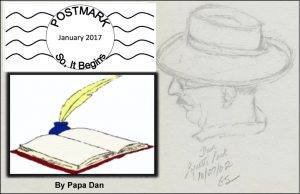 Carl Sandburg—
Carl Sandburg—
Orville Wright1
“Look around, look around,
look how lucky we are
to be alive right now.”
— Eliza Schuyler (from Lin Miranda’s “Hamilton”)
Carl Sandburg
… to be alive right now
These days, like so many others, I am immersed in “Alexander Hamilton.” The musical play has been all the rage — a roaring success on Broadway and now it’s coming to San Francisco! So, in our house, we have been listening to the brilliant hip-hop soundtrack; reading Ron Chernow’s biography of Hamilton (which inspired the musical); reading Lin Miranda’s script and commentary about the creation of the show; AND, yes, we have tickets to the show in May.
When I first heard about the show, I admit to being skeptical — a Broadway musical about the first U.S. Secretary of the Treasury (“the ten-dollar founding father”) set to “hip-hop” music (What is ‘Hip-Hop’? I asked). But once I heard the soundtrack and felt the spirit, I have become a convert. The music and lyrics combined with our founding story and spirited characters are nothing short of thrilling. At its core, “Hamilton” is a classic story of a poor immigrant who showed up at a critical time and made a powerful contribution to American history. In a useful lesson for today’s leaders, he did it by acknowledging his ignorance and educating himself. It is also a story devoid of a ‘Disneyland’ ending (spoiler alert: the hero, the former Secretary of the Treasury, gets killed in a duel by the sitting Vice President of the United States, Aaron Burr, at the dueling ground in Weehawken, New Jersey in 1804, no foolin’).
Twenty-eight years before their duel, as they prepared to join forces in the revolution, Burr gave Hamilton some advice:
“Talk less. Smile more.
Don’t let them know what you’re against
or what you’re for.”
And then, more to the point, in a much faster rhythm:
“I’m with you, but the situation is fraught.
You’ve got to be carefully taught.
If you talk, you’re gonna get shot!”
In the summer of 1776, Hamilton and Burr met in New York as the revolution was in full swing. It was an exciting time. Eliza, one of two Schuyler sisters destined to fall in love with Hamilton (yes, it’s a love story), sums it up:
“Look around, look around
at how lucky we are to be live right now.
in the greatest city in the world!”
How lucky? The excitement and optimism of the time was swirling all around them:
• talk of freedom and independence was everywhere on the streets of their city,
• revolutionary ideas (including the publication of Thomas Paine’s “Common Sense” in January of 1776) were on everybody’s lips (both for and against), and
• it was a time when young people could step forward and make a difference.
It also had a very dark side.
• War was brewing against an empire with the most powerful army and navy in the history of the world, and winter was approaching.
• Slaves were being bought and sold on the streets and wharves of their own city. Slavery had turned out to be the necessary political compromise among the colonies that made the union possible; so, abolitionists like Burr, Hamilton, and their New England compatriots had to swallow hard to believe that they could bend the future to match their principles, but … later.
• New York harbor would soon be flooded with 260 British Navy warships and thirty-two thousand British soldiers. Thousands of their neighbors would be killed in battles fought in their own towns and farmlands. Many would starve during the harsh winter that arrived with the well-fed British army and navy.
So, while these American patriots were optimists, their optimism came at great cost. The King was determined to show no mercy to his disloyal subjects and reclaim his valuable property on the American continent. In the show, the comically mad King George character sings,
“You’ll be back, soon you’ll see,
Yes, you know that you belong to me.
And when push comes to shove,
I’ll send an armed battalion to remind you of my love.”
These revolutionaries knew that many of them would personally suffer the ultimate cost for securing a future for their descendants. And they did.
To be alive right now
How lucky? Fast forward to now — here in 2017. What about us, you and me: the 21st-century descendants of those wild-eyed optimists? What can we learn from reflecting on their experience and ours? Have we preserved their vision of America? Is our vision of the future as bright as theirs? Are our challenges greater? Do we have reason to be hopeful, right now?
• Today, as 2017 dawns, many of our friends, neighbors, and ourselves are doing pretty well. Most statistics say that, overall, our economy is doing OK; the stock market is soaring. Isn’t it?
• Technology and other 21st-century advancements are improving our lives in exciting ways and many aspects of American life give us reason to believe that the future is bright. Right?
• After eight years of an African American President, shouldn’t race relations be encouraging?
• America has the unique distinction of being the world’s dominant superpower. Shouldn’t the founding fathers, and we, be proud and satisfied with the outcome of our revolution?
We are the heirs of the ideals, the optimism, and the governing principles that those brave folks earned for us, right?
–> So, today, can we repeat what Eliza sings early in Act One of “Hamilton?”
“Look around, look around
at how lucky we are to be alive right now.”
Well, sure. That was in Act One. But, before we romanticize the optimism of the revolution, let’s not forget that Thomas Paine had to publish his famous pamphlet encouraging American independence anonymously (see Aaron Burr’s advice to Hamilton, above). The threat was real.
How lucky? Today, as we read the hard, frightening, depressing news of today and listen to each other talk about it, there are growing fears lurking in our future:
• The news media, long the principal vehicle for ensuring an informed electorate, is threatened with access limitations and credibility challenges,
• Long-held American foreign-policy positions and international alliances are now in doubt, apparently without the careful study and decision-making processes we have come to expect,
• The conclusions of science, long held to be the bedrock of our understanding and the foundation of our policy decisions, are being devalued by those taking the reins of power,
• Progress in securing the safety net for retirement income and health care is threatened,
• Human rights, regarding race, gender, and national origin are being weakened by those who seem to have forgotten our long struggle to eliminate discrimination and inequality of all kinds,
• The long-held bipartisan goal of reducing the nuclear danger is now threatened by new leadership that speaks of pursuing a new arms race,
• The goal of government, to support the well-being of all Americans, is now called into question by those who are lining up to run our government for the benefit of the few.
Optimism, Hope in 2017?
In my own fear of what lies ahead, I am reminded to be confident, but patient – in words that Dr. Martin Luther King, Jr. borrowed from a sermon delivered in 1853 by an abolitionist named Theodore Parker, who borrowed it from others before him:
“The arc of the moral universe is long,
but it bends toward justice.”
But patience, while necessary, is not sufficient. Success — as illustrated by Hamilton, Parker, King, and others — is reserved for those who work actively to bend that arc. Those words were used, not at the end of successful struggles but at the beginning of hard times, when success seemed unlikely. Even when we think we’ve made progress, we do not always complete that progress without the inevitable detours. If I try to replicate the optimism of the American revolution, in the face of likely defeat; or try to emulate the hope of abolitionists, in the face bitter compromise; or support the efforts of those pursuing justice, in the face of bigotry; I conclude that 2016 must be considered a detour. It doesn’t have to be a reversal of our progress or an abandonment of the path we thought we were pursuing. We can make it into a detour – but we need to find our way back to that path. The administration of Donald J. Trump is not the end of this story nor the name of a new path to the future; it must be identified as the name of a detour.
OK, I apologize. I thought I could avoid using his name, but I decided that we must name the challenge if we are going to defeat it. We must not speak of Trump like Voldemort (“He-who-must-not-be-named” or “The Dark Lord”) in Harry Potter. The ideas he represents must be faced head-on, opposed, and defeated before we get too far off the path we were on and lose our way. So, as we approach the 2017 inaugural address, let us recall the words of the first inaugural address I watched, from a time in my youth, characterized by more optimism and confidence (and patience) than we might be feeling today:
“All this will not be finished in the first one hundred days.
Nor will it be finished in the first one thousand days . . .
nor even perhaps in our lifetime on this planet.
But let us begin.”
— John F. Kennedy, January 20, 1961
So, now the real work begins.
Along with that work comes some frustration. Those of a certain age remember marching on college campuses and engaging in political action to bring important American values into the light of day — values, among others, like these: equal justice and opportunity under the law, women’s health and reproductive rights, racial integration and civil rights, and decisions about America’s use of military force and the draft. Those battles were successful, in their day. The disappointment, and the reality, is that they must be fought all over again.
So, today — what will it take?
Remember: we know how to do this.
• Some will welcome those who are not welcome, in their own communities.
• Some will contribute time and dollars to help those who will suffer during this detour.
• Some will join movements to influence votes.
• Some will march, when the need arises.
• Those with influence — teachers, lawyers, bartenders, parents, grandparents, neighborhood leaders (you know, you and me) — may find a way to encourage compassion, common sense, and unity in small places among those who will take over when we are gone.
We know how to do this. Let’s start. (The forces on the other side have already started.)
“The only thing necessary for the triumph of evil is for good men to do nothing.”
— Edmund Burke (and others) ![]()
Click here to download a PDF of this article: ConVivio_How_Lucky_to_be_alive_right_now
Thanks to Lauren De Vore for her Editorial advice.
Looking Back at 2016 — Ahead to 2017
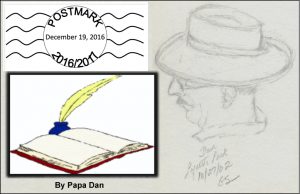
“How wonderful it is
that nobody need wait a single moment
before starting to improve the world.”
— Anne Frank
“The nation which can prefer disgrace
to danger is prepared for a master
and deserves one.”
— Alexander Hamilton
“Yes, we can.
— Barack Obama
2016/2017
Carl Sandburg
What Are Your Feelings About 2016 and Your Outlook for 2017?
(Your responses to the writing challenge: 30 words or less)
Of the fifty-some people who read ConVivio’s “2016” post, ten of you responded to its
30-word writing challenge. I admire the variety of approaches you took: some with a broad national perspective; others with observations focused on their own lives; some optimistic, others not so much; some were quite poetic.
Thanks to everyone who sent a response. Here they are:
==========================================
Overcome the recentness bias this year? I think not.
The election’s outcome could affect us for decades.
Color me cynical and sad for this fine country.
— Katie Walter, Stockton, CA
2016: The rotting corpse of the Democratic Party hopefully saw the error
of moving to the right.
2017: As Daniel said on the series finale of Rectify, “I’m cautiously optimistic.”
— Steve Rubio, Berkeley, CA (typepad.com)
I’m ready to fight against climate change and Trump’s agenda.
— Sonia Faletti, Washington D.C.
Working on myself as an active participant — How can I be more present?
How can I be more aware? How can I be a consistent critical thinker engaging with others?
— Matthew D. Sapone, Aptos CA
Incredible year, many “ups,” one YUGE “down.”
Ups: Changed from large stable company to a startup. Excellent decision!
Loving husband, strong family life, great friendships.
Downer: Won’t say his name.
— Nouanepheng Sapone, Aptos, CA
If you want someone to understand (and adopt) your viewpoint,
you must first listen to and understand theirs.
No more preaching to the choir.
— Lauren de Vore, Livermore, CA
The elections were like a pollution cloud, darkening everything.
Now, every day brings new confirmations of how bad 2017 can be,
for our country and the world. We’re worried.
— Megan Taylor, Bellingham, WA
Unexpected atheism explodes into confidence as the rush of information
restores limbic, and age of majority is reached. Zen heart at 80 beats per
minute while ruffian’s words exile paralysis.
— Jody Tims, Morgan Hill, CA
Daughter Srijana: Nepal, 1998, Scott College August;
her new boyfriend Haaroon: wants medical school;
Me: working CDC with fabulous Director Dr. Frieden;
2 dogs, 2 cats;
Me: nervous re. prez.
— Jean Smith, Atlanta, GA
After the events of the last year, I don’t know how anyone can mount a compelling defense for the theory of evolution. Are we really getting smarter and better? Show me.
— Jeannette Gosnell, Livermore, CA
Men often oppose a thing merely because they have had no agency in planning it,
or because it may have been planned by those whom they dislike.
— Alexander Hamilton, New York, NY
Looking ahead, we always think we are smart enough to predict the surprises.
My hope is that we are wrong; and the surprises will not be the ones we expect.
— PapaDan Sapone, Pleasanton, CA
A PDF of these responses can be downloaded here: Thirty_words_Grace ![]()
What Kind of Year Was 2016?
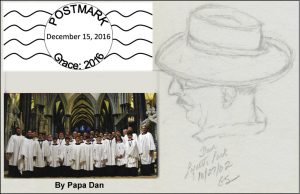 Carl Sandburg—
Carl Sandburg—
Orville Wright
Kitty Hawk, North Carolina
Fall, 1901
If we all worked on the assumption
that what is accepted as true,
is really true,
there would be little hope of advance.
Orville Wright
Carl Sandburg
This time of year, many of us take a moment and ask “What kind of year was this?” Looking back at what I posted on ConVivio at this time last year, the year 2015 was looking pretty grim. Many of us were looking for some encouragement, trying to find an excuse to feel more hopeful. In that end-of-2015 ConVivio post (“Grace”), I described our annual attempt to find some seasonal, yuletide peace, hope, and, well, grace, with the help of Grace Cathedral’s annual Christmas concert of the Men’s and Boys Chorus, Orchestra, and Organ. We followed that same recipe again this year, as we have for two decades.
More on that later.
When we try to look back and decide how we feel about a year, I suppose most of the time we decide that a year was either “terrific,” or “OK” or “terrible” based mostly on how we feel at the moment we are asking the question — near the end of the year. Michael Lewis’ recent book “The Undoing Project” describes the trick that our minds play on us with what he calls the “recentness bias,” in which we are predisposed to use the most recent evidence in drawing our conclusions. We don’t always take into account the entire year. So, I thought — why not try to avoid that “trick” and take a broad look back at some of the things that happened across the entire year and see if we can come up with a reasonable answer. Let’s give it a try and see if it helps. Then, I hope we’ll get to see your answer.
First, the usual stuff that always happens in any year:
The Sundance Film Festival, Super Bowl #50 and Mardi Gras, the Daytona 500, NCAA Final Four, the National Cherry Blossom Festival, the Kentucky Derby, a bunch of Shakespeare festivals, the NBA Finals, the Summer Olympics, the World Series, Albuquerque’s Balloon Festival, and the annual crop of new words entering the our vocabulary— notably: Brexit, Calexit, virtual reality, self-driving cars, fake news … etc. All of that happened as expected.
Second, the “special” stuff that happened in 2016:
In January, an armed militia took over a Wildlife Reserve in Oregon (and dominated the news) for six weeks; we learned that drinking water in Flint Michigan had been poisoning its residents for years; and as the primary elections heated up in March, Hillary Clinton emerged as the Democratic frontrunner causing polls and pundits to agree that her election was all but assured. Two days later, Trump’s campaign was pronounced “doomed” when Mitt Romney called him a “fraud” and a “phony,” saying, “He has neither the temperament nor the judgment to be president.” Well, I don’t have to tell you that … later on … in November … well, you know …
With the coming of a hopeful Spring, marriage equality became a reality in California but also in surprising places like Georgia; the ban on gays in the US military was lifted; and the supposedly paralyzed US Supreme Court struck down a Texas law restricting abortion 5-3. A few large states raised their minimum wage and progress was reported in preserving some endangered wildlife around the world. About that time, Britain did two seemingly contradictory things, perhaps inspired by the 90th birthday of their Queen: they elected the first Muslim mayor of a western city (London) and voted to withdraw from the European Union, reversing a 60-year trend toward European unification.
In June, the Broadway production of Hamilton received 16 Tony nominations, won the Grammy for Best Musical Theater Album, and captured the Pulitzer Prize for Drama
— not bad for a guy of questionable parentage who was killed in a duel 212 years ago.
In two technological triumphs, NASA’s Juno spacecraft entered Jupiter’s orbit after a 1.7-billion-mile, five-year journey to study the planet and a solar-powered plane flew around the world without using a drop of fuel (it took 16 months). Encouraged by the Paris Climate agreement, India reported that 800,000 volunteers worked 24 hours to plant almost 50 million trees on July 11th, beating the Pakistani’s previous one-day record of 1 million set in 2013 — reminding the world that, a month earlier, Donald Trump declared his intention to withdraw the US from the Paris Climate Agreement. (“It’s a hoax. Nobody believes it.”)
Third, some stuff happened that was NOT supposed to happen:
The Cleveland Cavaliers came back from a 3-1 deficit (a historic first), winning their first NBA title by defeating the Golden State Warriors. The National League playoffs between the Giants and the Cubs happened and I don’t want to talk about it. Immediately after that, the Chicago Cubs won the World Series, after waiting 108 years, by beating the Cleveland Indians, who are still waiting after 68 years. (The San Francisco Giants, were supposed to win the World Series this year and I don’t want to talk about THAT either.) Then, Americans elected a president who promised to Make American Great Again by employing a unique strategy … (and we’ve already talked about that too much, haven’t we?) Two weeks later, the Dow Jones responded to doomsday predictions after the Brexit and Trump wins and topped 19,000 for the first time (begging the question “What does it mean?”). Finally, in this “not supposed to happen” category, Gwen Ifill, a longtime PBS News anchor, died at the age of 61. Those who admire real news and respectful discourse mourned.
Finally, two more things happened that mattered to me:
1. I retired from a long career and was given a wonderful party (thank you Jessica & Brytni);
2. The 2016 Grace Cathedral Christmas Concert restored the uplifting and grace-filled themes that have inspired audiences (including Gretta and me) throughout its long and generous history (see https://convivio-online.net/grace/). Grace Cathedral’s musical signature, “Sleeps Judea Fair,” was again reassuring, peaceful, and hopeful — filling that magnificent cathedral with its transformational sound and powerful spirit. The blending of the mature and youthful voices and faces of the men and boys in that chorus, transported us all to a place we came there hoping to experience. The dissonance we heard and felt last December was gone — for now. I must admit that we needed that encouragement to look forward with hope to the year ahead. They came through for us and, for that, I am thankful.
OK, So How Do We Feel About 2016, Really?
Well, now that you’re really annoyed that I left out your favorite “most important” event from 2016 (and I know you were looking for it), it’s time to commit: how do we really feel about the year that’s ending and prospects for the year ahead? Again, I’m trying to avoid that “recentness bias” — you know, trying to ignore the feeling that the events of the past six weeks must completely overshadow our judgement about the whole year and color our anticipation of 2017. The year we’re just now completing suggests the likelihood that 2017 will bring some surprises. So, I offer two things:
One — A Request for 30 words from you: I am asking you (yes, you) to put your thinking hat on (no, not THAT hat) and try to sum up your feelings about 2016 and your outlook for 2017 in 30 words or less and send them to me. It’s a writing challenge — you can do it. Many of you have demonstrated that you are very clever with words. If you take a few minutes and send me your words, I will publish them here on ConVivio (with your name if you give me permission). Thirty words. Can you do it? (Repeat after me: “Yes, We Can.”)
Two — I offer my own 30 words anticipating how 2016 will lead to 2017:
Looking ahead, we always think we are smart enough to predict the surprises.
My hope is that we are wrong; and the surprises will not be the ones we expect.
I wish you all Happy and Hopeful Holidays!
PapaDan Download a pdf of this post: Grace_2016_ConVivio_Final![]()
A Good Man
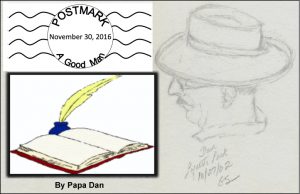
Carl Sandburg—
“The human race has one really effective weapon,
and that is laughter”
Few things are harder to put up
with than the annoyance
of a good example.”
“Forgiveness is the fragrance
that the violet sheds
on the heel that has crushed it.”
— Mark Twain
Carl Sandburg
Occupant
1600 Pennsylvania Avenue NW
Washington DC 20500
January 19, 2017
Dear Sir,
It has come to my attention — well, I guess it’s just starting to sink in — that you are about to leave a job that has kept you constantly in the public eye for the past eight years. While much attention has been focused on the next guy, I was thinking that it would be polite to drop you a note to say . . . well . . . thank you.
People have been talking about the job you did. So, sure, we can talk about that first, if you like; but I have something more important in mind; and we’ll get to that. So, first — how’d you do? Here’s a list of the usual kinds of things — and, as you know, some people consider these successes and others call them failures. You:
- Avoided a deep recession that you inherited when you first showed up for work
- Rescued the US automobile industry
- Ended the US formal combat role in Iraq
- Banned torture and brought Osama bin Laden to justice
- Initiated a program that insures about 20 million people who couldn’t get healthcare
- Appointed Sonia Sotomayor and Elena Kagan to the Supreme Court
- Supported marriage equality
- Initiated heavy investment in renewable energy technologies
- Crafted a multinational agreement to end Iran’s nuclear weapon program
- Led 120 nations to agree to reduce emissions that threaten the worldwide climate
- Opened the US to Cuba
You know, the usual kinds of things. Now, some want to quibble about that list; but as I mentioned, I have something more important to talk with you about.
I want to thank you for being . . . you know . . . A Good Man.
Now, I grant you that being a “good man,” by some agreed-upon definition, has never been a job requirement in your profession. We’ve had lots of the other kind – we seem to vacillate on that score. Over time we’ve had to look the other way on a lot of things. But in your case, sir, we can look you in the eye without being embarrassed.
I admit that all of that economics and foreign policy stuff are all pretty standard for a guy in your profession; but a person in your job has other impacts that are sometimes overlooked. I know it seems like a small thing, but you have had this habit of thinking first before you talk; and after you do that, the things you say come out in complete sentences and paragraphs, which I tend to enjoy. And, when those ideas get translated around the world, those clear sentences can be pretty useful.
I also appreciate that you don’t stomp around and lose your temper, even when they say rude things about you that aren’t true. You seem to have overlooked even the worst of the lies. You don’t seem to get into the “revenge thing” that some others do. I appreciated your comment when some people predicted that the election results were “the end of the world.” You lowered the temperature a bit and quoted Yogi Berra: “I always say that the only thing that is the end of the world is the end of the world.” Even when guys tell gullible people that you weren’t born in the US, I’ve heard you make jokes about it. Oh, yes that reminds me — guys in your profession are not usually good at telling jokes; but you have some real comic timing. I still remember during a debate, Mitt Romney kept making a face and sputtering about “Obamacare” with obvious distaste. You mentioned that it was called “The Affordable Care Act,” but you looked at him and said, “Hmmm. Obamacare, I like it. I think we should call it that.” Even Mitt had to laugh.
I suppose the thing I admire most is that your time on the job featured eight years without a hint of scandal — that’s not normal for guys in your profession. You have been a steady husband and father and have behaved with a combination humor and dignity, even in the face of public insults. Some of us forget that a guy in your job serves as a role model for other people, whether they want to or not, notably for little boys who look around to figure out how grow up to become a man. Other public figures don’t seem to have an eye for that. In your case, we can feel comfortable that little kids might look at you and say to themselves, “I want to be like him.” OK, I know there are those, like Mark Twain, who said “Few things are harder to put up with than the annoyance of a good example.” But, you know, I have grandchildren. I hope they’ve been watching.
So, I want to say ‘Thank You.’ All of that policy stuff is a subject for another day; but today I want to thank you for being a good man on the world stage, personally representing us in a way that made me proud. It’s not mentioned in the news much; but it’s worth a lot to me.
Regards to you and your family,
PapaDan Download a PDF of this post: convivio_agoodman_nov30_2016![]()
Where to? What Next?
My Syllabus
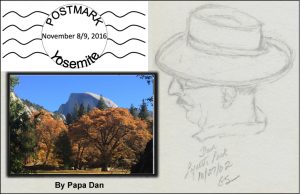
Where to?
Carl Sandburg—
“The people will live on;
The learning and blundering people
will live on.”
“They will be tricked and sold,
and again sold.”
“You can’t laugh off
their capacity to take it.”
— Carl Sandburg
Carl Sandburg
November 8, 2016
As I write this, I am sitting in a chair, surrounded by the spectacular beauty of Yosemite. Looking up from my pen and notebook, the carved granite of Half Dome stands directly in front of me; I can hear the constant roar of Yosemite Falls from my left; and the silent flow of the Merced River drifts downstream ten feet to my right.
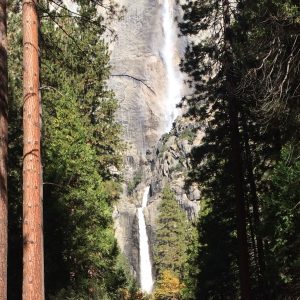
Yosemite Falls
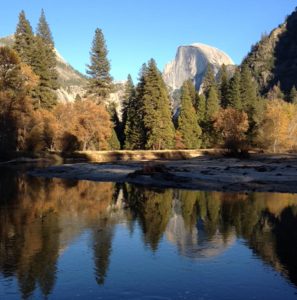
Half Dome

The Merced River
There is a spirit here — a spirit that (or who) inspires big ideas.
Today is a big day. Today is Election Day (outcome yet to be determined); but this piece is not about the election. It is about something much bigger: It is about you and me, you know, America. In the 1830s, Alexis de Tocqueville defined America as “the great experiment in democracy on the North American continent” with grand, historic intentions. And, as I mentioned, America — that is, you and me — is much more than elections; and it is also much more than the good intentions that initiated that great experiment. Henry Ford once famously said, “You don’t build a reputation on what you are going to do” (I read it on my tea bag this morning). We are what we do; and that’s how we must be remembered.
So, what have we done? “We” — that is, America before you and me — built a nation on some important ideas that had been brewing in Europe for quite some time, and “we” applied those ideas in an experiment. “We, the People,” applied them to the lives of some of the people who lived on this continent; allowed lots of people from around the world to come here to participate; and actually welcomed many of them — not all of them, and some more than others. And, while we were doing that, “we” (again, before you and me arrived on the scene) “we” built great things on those big ideas:
- government institutions,
- institutions of justice and law,
- practices in support of banking and commerce,
- transportation systems,
- foundations to encourage the arts and sciences,
- technology to change the world over and over,
- systems to enable a historic level of prosperity,
- traditions for how we treat one another,
- and much more.
Along the way, we fostered an adventurous spirit that expanded the great experiment — America — across the length and breadth of the continent and, by doing all that, we built a reputation that influenced the lives of people around the world.
Yes, that was a lot of doing on which to build a reputation.
Now, granted, the expansion across the continent incorporated/appropriated a lot of land and resources that had for a long time ‘belonged’ to other people; and, granted, the prosperity we created was made available to some of us and not others; and the worldwide influence America wielded resulted in both good and ill; BUT …
Here we stand today — standing on the shoulders of giants (well, OK, some of them were giants and some of us made it to their shoulders). Nevertheless, here we stand, here in the twenty-first century, you and me. We are the heirs of what has been passed down to us and the stewards of all that America IS.
So, now that American IS you and me (yours and mine), what have we done? And what are we doing?
Remember, this is NOT about the election, honest, I promised. Besides, we haven’t actually had the election yet — voting is still in progress cross the land as I scribble these words here beside the river; but we have been doing some things as stewards and owners of America — “We the People,” collectively — that really do define the time in which we live and the variety of experiences that we are all having. Those of us who read and listen have been hearing a lot of the details by which the news media keeps score of how we are doing:
- more people are employed today than were working a year or two ago,
- the average income of Americans has increased gradually in the past year or two,
- the stock market, although fluctuating with the news cycle, is at an all-time high,
- our achievements in science and technology are breathtaking,
- there are more students attending American universities than ever before,
- and much more.
AND, as has always been the case, America and its institutions face more dramatic and difficult challenges than ever before:
- the benefits of American prosperity are shared unevenly, with more wealth at the top and more people at the bottom;
- people less fortunate need more help than ever;
- in spite of historic advancements by people of color throughout our society, more violent incidents of racial animosity are reported in the news almost every day, many of which include deadly encounters between law enforcement and minority citizens.
One observation every American seems to agree with is that “we” are more divided ever.
Technology enables our social interactions to be instantaneously and widely distributed — that’s both the good news and the bad news — allowing us to instantly distribute far and wide the most beautiful and the most vile ideas. We try to use that capability to help us discuss the collective decisions we have to make; and then we have elections — like today.
A famous line, attributed to several of our forebears reminds us that:
“Democracy is that form of government in which the people get the government they deserve.”
As we wait for the results of today’s election, we might well ask, what do we deserve? Whether we like it or not, I suppose we will see the answer to that question in the election returns. Will we all agree that we deserve what we get? Perhaps we will look to those who have gone before us for guidance. We have been warned about what we might deserve.
Thomas Jefferson: “I tremble for my country when I consider that God is just.”
So, do our forebears teach us what to do when we are disappointed? On that subject., one of the most important speeches of our time is remembered by only a few. After losing his challenge of the results of the Florida vote count (he lost by 533 votes) in a decision by the U.S. Supreme Court (on a 5-4 vote), Al Gore reminded us, on December 13, 2000, of the longstanding importance of the peaceful transfer of power:
“Let there be no doubt, while I strongly disagree with the court’s decision, I accept it. It has been resolved as it must be resolved, through the honored institutions of our democracy.”
This week, Al Gore spoke to a ‘get out the vote’ rally: “Every vote counts. Trust me on this.”
So, after listening to the rhetoric over the past few weeks, can we be sure that wisdom passed down to us about the ‘peaceful transfer of power’ will prevail at the end of this day?
So, how’d we do? Tomorrow will tell the story.
November 9, 2016
This morning, we took a walk from Yosemite Lodge across Cook’s Meadow to the bridge on the Merced River. A woman pointed up at a tree, “Look,” she said, “an American eagle!” Sure enough. There he was, perched high in a tree, his large white head turned to one side of his dark torso the way we always see him when he plays his role as the symbol of our nation. Question: was he here to bring a message of encouragement to us up here in the mountains or did he come here to escape what had happened down in ‘the world below?’ OK, silly question — he LIVES up here in the mountains and doesn’t much care what happens down in ‘the world below.’ But for us, the symbolism was strong.
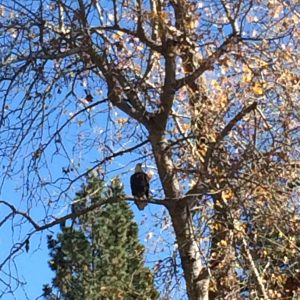
An American Eagle
OK, so we learned what had happened yesterday down in the world below. It was a shock, to say the least. Some were asking, can we survive this? But, as I said, this piece of writing is not about the election. It asks the question – in light of where “we” have been and what we have done to get where we are today, what are we supposed to do now? Regardless of which way the course of human events takes us, what are our responsibilities going forward? Can “We the people” (you know, you and me, America) survive and prosper even when we make big mistakes and when things don’t go the way we had hoped?
Fortunately, there are optimists among our forebears who reach out from their own difficult days to offer hope to us in ours. Carl Sandburg is one of those. Below are words from his poem about what “the people” do in times of crisis.
The People Will Live On — Carl Sandburg, 1936
“The people will live on.
The learning and blundering people will live on.
They will be tricked and sold and again sold
And go back to the nourishing earth for rootholds,
The people so peculiar in renewal and comeback,
You can’t laugh off their capacity to take it.
In the darkness with a great bundle of grief
The people march . . . ‘Where to? What next?’ “
We have begun hearing from people who are concerned about the effects of yesterday’s outcome. A friend of mine, seriously depressed about yesterday’s news, told me in an e-mail that she decided that she must do something. Whining about our disappointment is not enough, she reasoned. She plans to volunteer where she might be needed to help mitigate the effects of what happened yesterday. Another friend told Gretta “I don’t know if I can get over this.” Gretta’s answer: “Maybe we’re not supposed to get over it. Maybe we have to accept it and find something we can do to help. People are going to need help.” Others have suggested that it is time to increase our contributions to organizations that can help those who are going to suffer from the news — immigrants, those who will lose their health care, kids in school programs that will be cut, those who receive necessary assistance from government programs threatened by yesterday’s news, those who had hoped that “we the people” would try to mitigate global warming — you know, you and me: America. There are many choices one can make. As a first step, we have decided to increase some of our contributions. These are some of our favorites: The American Civil Liberties Union, The Natural Resources Defense Council, Planned Parenthood, The Sierra Club, and The Yosemite Conservancy. Many other approaches are available — an organization that supports the homeless? A school district, maybe even one in another town? I suspect that we all have ideas to add to that list.
Yesterday, November 8, 2016, “We, the people” spoke in the form of 290 electoral votes; and today, “we the people” have the opportunity to speak in other ways as well.
Looks like some difficult times ahead for a lot of people.
What must I do to help?
What must you?
Download a PDF of this piece: where_to_what_next_convivio![]()
Decades We Have Known
(and one we’re still getting to know)
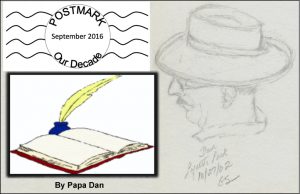
“Yes, here we are
right in the middle of it;
but what should we call it?”
Those of us who went to school around the middle of the 20th century were taught to understand the passing of time in distinct eras, each having its own character and name. For example, the thousand-year period called “The Middle Ages” was a characterized principally by ignorance and short life spans. Following that, it seems, the focus of history narrowed to individual centuries. The 15th century (roughly, 1450 to 1550) is remembered for its intellectual and artistic awakening and discovery and thus called “The Renaissance.” Today, our understanding of distinct definable time periods comes down roughly to decades, both in our education and in popular culture.
So, as I read the news and listen to the pundits of our day, as they attempt to identify the trends of our times, I am driven to ask:
- given the pattern of the decades we have come to know best, what name would a thoughtful person give to the decade in which we live today? How will the 2010-2020 decade be remembered in the years to come?
Of course, since this decade is not finished, our judgments must be preliminary. But let’s give it a try. As a start, let’s review the decades of the most accomplished and truly “American” century of them all, the 20th century.
1900 to 1910 — “The Good Years”
During the first ten years of the 20th century, from an American point of view, the world was mostly at peace. Shirts cost 23¢, but the children who made them earned a mere $3.54 a week. Teddy Roosevelt proposed to strengthen the U.S economy with his Square Deal and sent the U.S. Navy around the globe to introduce the world to the idea of American power. My grandparents, like 3 million other immigrants escaping a crushing depression in Southern Italy, sailed in the belly of big ships from Naples to New York. Last but not least, my father rounded out the decade by being born in Red Jacket, West Virginia on October 10, 1910.
For many Americans, according to a commentator of that time (John Clark), “The future was simple; rewards would go to the virtuous” and Americans perceived themselves to have “the personal material out of which a millennium would grow.” Historians have called this decade “The Good Years” (see Walter Lord’s “The Good Years,” Harper and Row, 1960).
1910 to 1920 — “The End of Empire, War in Europe”
A powerful worldwide upheaval began. In America, much of the population moved to cities and there was a dramatic reduction in immigrants from Europe compared to the mass migration of the previous decade. The world began to see the end of a long-established world order, disintegrated into World War I, and suffered the historically unprecedented destruction and loss of life that went with it. A “new world order” was established once “the war to end all wars” finally … well, so we claimed … ended war itself and, in America, ushering in …
1920 to 1930 — “The Jazz Age” (or “The Roaring Twenties”)
This decade began, inauspiciously, on January 16, 1920 with the onset of Prohibition. It is hard to accept that the alcohol-marinated events of “The Jazz Age” could possibly have begun with a national decision to prohibit alcohol consumption; but as Will Rogers famously said, “Prohibition is better than no alcohol at all.”
Songwriter and philosopher Jacques Brel summed up ‘The Twenties’ this way:
“We must dance because the Twenties roar,
The Twenties roar because there’s bathtub gin,
Vo-de-oh-do and the road to sin,
The road to whoopee and a whole lot more.
Charles A Lindberg, tons of confetti,
Dempsey, Tunney, Sacco and Vanzetti
Black, Black Monday and the market drops
But we keep on dancing, dancing, we can’t stop.”
For many Americans, the party didn’t stop, until …
1930 to 1940 — “The Great Depression”
On the day the Jazz Age ended, the Thirties began: October 29, 1929, with the stock market crash and the beginning of the Great Depression. Unemployment and bread lines became the dominant images. Across the Atlantic, the world darkened further with the growing power of Fascism and Nazism in Europe and the pervasive fear that all of Europe would plunge into war again. The lights went out, virtually worldwide, for the better part of the decade, until …
1940 to 1950 — “World War II, Victory, The Seeds of Prosperity”
The Forties arguably began on September 1, 1939 with Hitler’s invasion of Poland, formally starting World War II. Many Americans, led by Charles Lindberg and other vocal isolationists, insisted that America should stay out of the troubles in Europe and focus on our own economic challenges. While most remember December 7, 1941, as the day that got America into the war, it was actually December 11 – the day that Hitler declared war on the U.S. and Russia. That gave President Roosevelt the clear justification to actively enter the war. The disastrous unemployment of The Great Depression was “solved” with the massive ramp-up of industrial production to support the war effort, which put Americans back to work (although the war killed 60-80 million people worldwide.
1950 to 1960 — “Stability, The Cold War, and Prosperity … for Most of Us”
Looking back as someone born in 1950 into a middle-class community, the Fifties was a period of stability and order, a large-scale expansion of the American middle class, and the re-establishment of a calm and mostly prosperous domestic life for much of America that hadn’t really been seen since the start of the century. A new brand of celebrities like Allen Ginsberg and Maynard G. Krebs introduced Americans to the new vocabulary of “The Beat Generation.” But …
The Cold War started. It began with the Berlin blockade on June 24, 1948, or maybe with the establishment of NATO on April 4, 1950, or perhaps with Joseph McCarthy’s “Wheeling” speech on February 9, 1950. Domestically, the uneven (mostly white) prosperity of the Fifties, coupled with the return to ghettos of many returning U.S. soldiers, the Fifties surely germinated the seeds of the turmoil that burst forth in the next decade.
1960 to 1970 — “The Age of Aquarius”
The Sixties began with a sense of optimism and inspiration epitomized by the election of an eloquent and youthful president, but those hopes were dashed dramatically on November 22, 1963. While the polarization, cynicism, and youth rebellion often associated with the Sixties is traced back by many to the Kennedy assassination, the Era of Rock and Roll as well as much of the colorful wildness and anti-establishment post-Woodstock psychedelia and self-actualization associated with the the Sixties really didn’t come into full flower until the early 1970s. In the middle of the decade, discontent among those who did not benefit from the prosperous “normal” of the Fifties (i.e., African Americans) erupted violently in cities all across America as a reaction against brutal racism and income inequality. Others marched in the streets to protest a war that those who grew up in the Fifties did not understand; once they did understand it, they liked it even less. THAT Sixties was not colorful, prosperous, or peaceful (and 50,000 U.S. soldiers did not come home from that new war).
1970 to 1980 — “The Me Decade”
The Seventies really began on June 17, 1973, even though few people noticed at the time. Five associates of the Committee to Re-Elect the President (yes, known as CREEP) were apprehended while breaking into the Democratic National Committee Headquarters in the Watergate office complex in Washington D.C. In spite of efforts by the president to “make one thing perfectly clear,” one thing led to another and introduced some enduring phrases into the American lexicon: “The Plumbers Unit,” “The people need to know that their president is not a crook,” articles of impeachment, a resignation, and, perhaps most lastingly, the suffix “-gate.” Some would argue that American politics would never be the same. Others argued that “the same” was exactly what it was … and continued to be.
1980 to 1990 — “The Beginning of Fact-Free American Politics”
The Eighties began on January 20, 1981, minutes after the presidency had passed from Jimmy Carter to Ronald Reagan and Iran released the 52 Americans who had been held hostage for 444 days. The decade that followed featured the distortion of American conservatism, from a moderate notion of limited government (actually practiced by Republicans from the 1950s through the era of Watergate) to the excessive expansion of government under the Reagan administration. (Surprised? Look up the numbers – highest Federal budgets per GDP, most Federal employees in history, widespread international intervention, etc.). And all of this took place amid the simultaneous “Small-Government” rhetoric of…well…Ronald Reagan.
1990 to 2000 — “The Best Decade Ever” (so reported by the WSJ and the NYT)
The Nineties were characterized by the rise of multiculturalism, the collapse of the Soviet Union, and the spread of capitalism in that vacuum. In American politics, the Nineties were dominated by a battle between the centrism of the Clinton administration and the politics of personal destruction perfected by the other party, later named RINO by the fictional Will McAvoy of Newsnight (for “Republican In Name Only”). The American economy grew at a strong 4%, median household income rose by 10%, the poverty rate fell from 15% to 11%, the U.S. murder rate declined by 41%, the federal government ended the decade with a budget surplus, the Stock Market quadrupled in value, and the wearing of neckties in offices began to diminish. But,
On the world stage, wars broke out in the Congo, the Persian Gulf, Chechnya (twice), Kashmir, Kosovo, Yugoslavia, Croatia, and Bosnia, to name only a few, and a host of civil wars redrew maps on at least two continents. However, apartheid in South Africa came to an end. The Nineties also featured an unprecedented explosion of the Internet and computer technology (although these advances were soon to be dwarfed by a greater explosion of the Internet and computer technology just around the corner).
2000 to 2010 — “The Rise of Terrorism and The Great Recession ”
The Oughts, the first decade of the 21st century was initiated by the arrival of large-scale terrorism on American soil. This heinous crime was followed by a panicked attempt to combat terrorism through the dismantlement of civil liberties at home and a misdirected military response against a country and a dictator who had nothing to do with 9/11.
Oh, yes, the U.S. had a historic period of anti-intellectualism, manifest in the depletion of education budgets and leadership of a president “misunderestimated” for his lack of interest in intellect, let alone possession of it (stimulating an all-but-forgotten quote from Garrison Keillor: “Who needs a fifty-dollar haircut on a fifty-cent head?”).
The housing finance and stock market investment disaster during the Dubya era sent the U.S. economy into a tailspin. Recession and unemployment were stopped just short of a Depression by an infusion of fiscal stimulus and government regulation (who wouldda thunk it?).
2010 to 2020 — “Whah?”
Well, that brings us to the present decade, of which we stand approximately in the middle and the question that I started with:
• What should we name this decade? More precisely, what are we likely to call it when this decade is done? So, let’s explore what we know about this current decade, so far.
The ?????
- The West’s war against terrorism becomes terrorism’s war against The West.
- The end of “carefree” in America and the avoidance of crowds.
- A generalized paranoia, growing gun ownership, and gun violence.
- A gradual, but dramatically uneven increase in prosperity.
- A decline in the power of labor unions and a decrease in the size of the middle class.
- The re-emergence of racial tension, especially between minorities and law enforcement.
- The maturing of “Fact-Free Politics” and the trend toward “voting against” in which nobody believes fully in the available choices.
• I invite you, dear reader, to send us your suggestions. What should we call this decade we inhabit today? I am interested in your ideas. ![]()
Download a PDF of this post: convivio_decades_sept2016_final
For fun, below is an added bonus for those who, like me, identify decades with music …
The Soundtracks of the Decades
(The most popular songs listed on U.S. Billboard)
The Tens:
When You Were Sweet Sixteen (1900)
Stars & Stripes Forever (1901)
Bill Bailey (Won’t You Please Come Home) (1902)
In the Good Old Summer Time (1903)
Sweet Adeline (1904)
Give My Regards to Broadway (1905)
Yankee Doodle (1905)
Auld Lang Syne (1907)
My Gal Sal (1907)
Take Me Out to the Ball Game (1908)
I Wonder Who’s Kissing Her Now (1909)
Swing Low, Sweet Chariot (1909)
The Teens:
Let Me Call You Sweetheart (1910)
By the Light of the Silvery Moon (1910)
Alexander’s Ragtime band (1911)
When Irish Eyes Are Smiling (1913)
By the Beautiful Sea (1914)
Carry Me Back to Old Virginney (1915)
I Didn’t Raise My Boy to Be a Soldier (1915)
O Sole Mio (My Sunshine) (1916, Enrico Caruso
Over There (1917)
For Me and My Gal (1917)
Rock-A-Bye Your Baby (With a Dixie Melody) (1918)
I’m Always Chasing Rainbows (1918)
The Twenties:
Swanee (1920, Al Jolson)
My Man (1922, Fannie Brice)
Yes! We Have No Bananas (1923)
Rhapsody in Blue (1924. George Gerschwin)
California, Here I Come (1924, Al Jolson)
Sweet Georgia Brown (1925)
Ain’t She Sweet? (1927)
Stardust (1927, Hoagy Carmicheal)
Ol’ Man River (1928)
Mack the Knife (1928)
Ain’t Misbehavin’ (1929)
Tip Toe Thru’ The Tulips With Me (1929)
The Thirties:
Happy Days Are Here Again (1930)
Dream a Little Dream of Me (1931)
It Don’t Mean a Thing (If It Ain’t Got That Swing) (1932, Duke Ellington)
Stormy Weather (Keeps Rainin’ All the Time) (1933)
Brother, Can You Spare a Dime? (1932, Bing Crosby, others)
On The Good Ship Lollipop (1935, Shirley Temple)
Summertime (1936, Billie Holiday)
They Can’t Take That Away From Me 1937, Fred Astair)
Blue Moon (1935)
Sing, Sing, Sing (With A Swing) (1937, Benny Goodman)
September in the Rain (1937)
Thanks For the Memory (1938, Bob Hope and Shirley Ross)
Over the Rainbow (1939, Judy Garland)
God Bless America (1939, Kate Smith)
Back in the Saddle Again (1939, Gene Autry)
The Forties:
When You Wish Upon a Star (1940)
In the Mood (1940, Glenn Miller)
Blues in the Night (1942)
White Christmas (1942, Bing Crosby)
As Time Goes By (1943)
Don’t Fence Me In (1944, Bing Crosby)
This Land is Your Land (1944, Woodie Guthrie)
The Christmas Song (Chestnuts Roasting on an Open Fire) (1946, Nat King Cole)
Some Enchanted Evening (1949, {Perry Como)
All I Want For Christmas is My Two Front Teeth (1949 Spike Jones)
Rudolph, the Red-Nosed Reindeer (1949, Gene Autry)
La Vie En Rose (1949, Edith Piaf)
The Fifties:
How Much Is That Doggie in the Window (1953, Patti Page)
Mister Sandman (1954, The Chordettes)
Sh-Boom (Life Could Be a Dream) (1954, The Crew-Cuts)
Three Coins in the Fountain (1954, Four Aces)
Mambo Italiano (1954, Rosemary Clooney, yep George’s mom)
Stranger in Paradise (1954, Tony Bennett)
Sixteen Tons (1955, Tennessee Ernie Ford)
Rock Around the Clock (1955)
Heartbreak Hotel, All Shook Up, Hound Dog, Don’t Be Cruel (1956, Elvis Presley)
Que sera sera (Whatever will be will be) (1956, Doris Day)
At the Hop (1957)
It’s All in the Game (1958, Tommy Edwards)
Johnny B Goode (1958, Chuck Berry)
All I Have to Do is Dream (1958, Everly Brothers)
Venus (1959, Frankie Avalon)
The Sixties, Seventies, Eighties, Nineties, Oughts, etc
YOU KNOW THESE, DON’T YOU?
For a these songs and more – check out: http://tsort.info/music/ds1930.htm
Click here to download a PDF of this post: ConVivio_Decades_SEPT2016_FINAL
Back To School: 2016
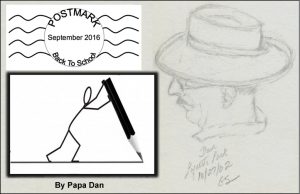
This past month,
as my grandchildren head back to school,
this former ‘pencil pusher’ reflects:
How has “Back to School” changed?
Back to School: A ‘Pencil Pusher’ Looks Back
Who’s Your Daddy?
Growing up in Antioch, a middle-class California town, in the 1950s, the boys I knew competed on the school playground in the same ways, I assume, that boys did in other places. Hierarchies were established, often starting with a conversation like this one:
“Hey, you can’t cut in front of me, I’m up next.”
“Well, I called it.”
“What do you mean you ‘called it?’ You can’t just call it!” (Remember when you could call it, you know, “I got dibs.”)
“Nobody wants you to bat with runners on base. You never hit the ball out of the infield. You’re an automatic out.”
“Oh, YEAH? (then comes the big one at this early stage of the argument):
“And you throw like a girl.” (It didn’t get much more personal than that in 1959.)
Next comes the appeal to fairness. “You gotta wait your turn.”
Fairness fails and is trumped by an appeal to personal strength. “Who’s gonna make me, YOU?”
Up to that point, that’s pretty standard stuff; but, unless the boys were willing to throw punches or were stopped by some external interruption, the argument could move completely outside of the playground into more sensitive territory.
“You’re as wimpy as your dad.”
So, where did that come from?
Antioch was a serious factory town in the 1950s. We had a DuPont plant, two Fiberboard plants, a Crown Zellerbach paper mill, a Glass Containers factory, Fulton Shipyard, Continental Can, Kaiser Gypsum, Union Carbide, Dow Chemical, a rubber mill, two canneries, Dexter Hysol out on Bailey Road, the Redwood Manufacturing Lumber Yard, and a U.S Steel plant just outside of town on Loveridge Road. Turns out that a major percentage of the dads in the vicinity worked in one of these facilities. (By the late 1960s, about one-third of the local moms also worked outside the home, but in Antioch back in the fifties it was mostly dads – just like a script from TV shows we watched like “Father Knows Best” or “Leave It to Beaver.”) So, when a guy was challenged on the playground, some portion of his status was wrapped up in his dad’s occupation; so the next level of insults could take a new direction, refining the playground hierarchy:
“I bet your dad’s the smallest guy at Fiberboard.”
“He doesn’t work at the stupid Fiberboard plant; he drives a forklift – the big one that hauls tons of stuff.”
“Tons of what? Peaches at the cannery? My dad works at U.S. Steel. They make steel for cars and airplanes and big stuff.”
“Big deal! My dad’s a foreman. He orders guys like your dad around all day long.”
“Yeah, well . . . “ he searches for something to top that –> and here it comes,
“Your dad doesn’t do REAL work, he’s just a pencil pusher.”
What’s a ‘Pencil Pusher?’
If these boys were lucky, the inning ended or the bell rang or Sister Bernadette showed up with her uncanny ability to sense when boys were heading for trouble, so it seldom escalated to an actual fistfight. But those of us watching from outside of the argument were left wanting to know: What’s a ‘pencil pusher?’ What kind of job was that? It was made to sound pretty insulting. Guys, and gals, were wondering: was my dad a ‘pencil pusher?’ If he was, just how embarrassed should I be? Was that as low on the totem pole as the kid on the playground made it sound? Did that insult win the argument? It would have been instructive — to us fourth-grade bystanders at least — if the exchange had been allowed to run its full course and we could find out who won the argument in the only definitive way we knew: which one ended up on the ground crying and which one walked away with all of his teeth?
Of course, one way or another most of us who cared eventually learned, or decided for ourselves, what it meant to be a ’pencil pusher.’ To those who used it as an insult, it meant a job that didn’t require physical strength and skill to build things — the work that made someone a ‘real man’ in a factory town like this one. After all, as we were all taught by our ‘Greatest Generation’ parents and teachers, the post-war economy was built on production of things like cars and trucks and refrigerators and all the other things that TV commercials told us we needed to buy. Those products, the stuff they were made of, and the containers they came in were produced with physical labor in factories like those in our town. Many Antioch dads did that work.
But gradually, as the 50s turned the corner into the late-60s, we baby boomers were presented with other choices. To some, a ‘pencil pusher,’ it turned out, was someone who used his brain to plan or organize or communicate the ideas and processes that made the manufacturing economy successful. He might have been an accountant or insurance broker, a union leader or a lawyer, a newspaper reporter or a manager. AND, increasingly, gradually, pencil pushers turned out to be women, as well (a feature that distinguished the 1960s and beyond from the 1950s).
My dad, who worked in the steel mill after completing less than a junior-high education in the Santa Clara Valley, went to night school to become a pencil pusher (i.e., an insurance agent). So, from my earliest memories, my dad made clear to me that I was going to college so I could become a pencil pusher of some kind. He never used that word, but there was no question that he didn’t want me to work in one of the Antioch factories. Increasing numbers of us who graduated from that playground, later graduated from high school and went to college fully intending to become very good at pushing a pencil and, eventually, using other ‘labor-saving devices’ like typewriters, telephones, calculators, and much later, computers. Pencil pushers, it turned out, helped turn many kinds of labor jobs into well-paying union careers and provided opportunities for promotion that broadened the middle class and made it increasingly prosperous as the 1960s matured in our town.
Boing! With the 1960s, athletics begin to dominate
The ‘Pencil Pusher’ conflict of the late 1950s, which I observed mostly as a bystander, didn’t have much of an effect on me personally, since it was all about competition on the playground; and I was not perceived as competing with anyone. I was a kid who carried around a leather briefcase that my father gave me to carry my books. Reading was the ‘sport’ that he encouraged every way he could. On the playground of the 5th and 6th grade, I was pigeonholed in the category of the “uncoordinated,” which kept me safely out of competition with other boys. I was picked last when teams were picked (when I HAD to play baseball in PE), I found that if I gravitated to tetherball, while it was technically a ‘sport,’ it seemed to keep the competitive forces of the playground at a distance. But then, as I went back to school in the fall of the 7th grade, everything changed. EVERYTHING. During the summer and fall of 1962, I grew six inches.
As I described in an earlier story on ConVivio (https://convivio-online.net/a-moment-in-the-sun/ ), the basketball coach (in conspiracy with Sr. Bernadette and my mother), forced me to join the 7th-grade basketball team — VERY much against my will.
At first the others on the team seemed amused when I showed up; but to my (and their) surprise, I did pretty well without embarrassing myself too much. I got a bunch of rebounds, blocked some shots, threw the ball down court to Gary to start the fastbreak, and helped the team win. For the others, it was no longer amusing when the coach made me one of the starting five. Then it became serious; but some of them got used to having a formerly uncoordinated kid become one of them. After a few weeks of this, one day Tom Augustine — an all-sport athlete — gave me a nickname. He said, without malice, just stating the facts, “You’re not really any good, are you, you just have ‘BOING,’ right? You know, like a spring.” We were friends, so I took it well. He was right. I didn’t have the usual set of athletic skills. I had ‘boing.’
As a result of some coaching and persistent practice in my backyard, by the time I showed up in high school, I was a real-live starting high-school basketball player, with all of the privileges and respect that went with it. No foolin’. Apparently, by the last half of the 1960s, the fact that my dad was a ‘pencil pusher,’ no longer did me any harm. Perhaps that stigma had begun to disappear, even in a factory town like Antioch, and we had to earn our own respect (or lack of it).
In High School — What next? The ASVAB Test
So, at Antioch High School, basketball wasn’t going to get me much more than a little respect on the basketball court; it was time to take the next step, whatever that turned out to be. The next step, as my guidance counselor informed me, was to find out what I was good at to prepare myself to go to college. She had spoken to my dad and, she told me, ”He made some things clear – you are going to college whether you like it or not, you know that don’t you?” I hadn’t heard it put quite that way exactly, but it wasn’t a surprise. And she said something more: “He also told me that he was hoping that you would take over his insurance agency after you graduate. You know, ‘A. J. Sapone Insurance And Son’ and all of that.” So she told me, “I advised your father that he would have to wait and see if that turned out to be what your son is good at. He may have other skills and other interests that he’ll figure for himself. So, he may end up taking a different path.” She told me that she didn’t think he would be thrilled with that outcome, but he seemed to accept that as a possibility. She also suggested a strategy. “The Armed Services Vocational Aptitude Battery (ASVAB) of standardized tests was going to be offered in a few weeks,” she told me. I want you to take that test and we’ll see what it tells us.”
“I won’t have to join the army, will I . . . because, you can for… “
“No, everybody gets to take it. It tells us what kinds of professions you might be best suited for, based on your interests and talents. It might help.”
So the test came and went and we waited for the results. The background: by 1967, the values of popular culture began to be influenced by some recognizable themes. Appreciation for the outdoors, for individualism, for public service, and other attributes that came to us from music and TV resulted in some predictable answers to questions designed to identify personality traits. So when the results came back and were reported to us, I learned that I was most suited to becoming a forest ranger. The wonderful joke was that more than half of my friends learned that they had the same destiny. One saw me holding the familiar envelope and said “Forest ranger, right?”
“Right.”
When I asked my counselor about it she confirmed the glitch in the data analysis, “Yes, I guess you’re going to have to figure it out for yourself.” That, of course, had been her real advice all along. So, “back to school” had new meaning. I went off to college with that question: did my future have an “And Son” sign hanging on it, or was there something else I had to choose?
As my grandchildren head back to school at various stages of their education, perhaps they are in the middle of a similar process.
With the 2016 Version of “Back to School,” What has Changed?
Looking back across the decades that followed, many things changed. The education I receive prepared me for a long career as a ‘pencil pusher’ — a writer and editor. Pencils began to take a back seat to other tools that dramatically accelerated the advancement of ‘pencil pusher types’ of an increasing variety. As the 20th century passed into memory, in an equally dramatic reversal, the middle class itself has begun to shrink as many labor jobs — jobs that were so well esteemed on my playground in the 1950s — began to draw a diminishing share of the benefits of the increasingly globalized and technology-driven economy.
As an older guy recently retired from my career as a ‘pencil pusher’ — a guy with seven grandchildren growing up on very different playgrounds — I have some questions:
- Are the conversations on their playgrounds different today?
- Does the occupation of their parents play a greater or lesser role than it did on my playground?
- What will be the shape of the middle class that they will graduate into? What will it take for them to access the quality of life that was made available to me?
- Will the education available to them prepare them for the world they will meet when they graduate?
My grandchildren seem to have some advantages — they all seem to be smarter than I was at their age; they all have university-educated parents; they have access to vastly more technology that I had (I had a transistor radio, and electric train, and a bicycle and they have . . . well, other stuff), and they are exposed to much more cultural diversity than I was (my town and my playground had none). The technology they have at their fingertips provides them with information and answers that my generation had to dig for by going to the library. Is their instant access to information an ‘advantage’ or does it bypass some of the learning experiences I had? Will they be sufficiently prepared in subjects related to 21st-century science and technology? AND — equally important to this ‘English major’ — will they have a solid foundation in the Humanities necessary to be a well-rounded human being?
I think they will. The evidence for that optimism is my observation that their parents (our children) are providing them with experiences that expose them to reading, science, the arts, and personal interactions that are helping them develop into curious, confident observers of the world around them and smart thinkers. I see those parents actively involved in their children’s school, extracurricular music and arts programs, and sports teams. And the kids are proud of the things they do. So, I am optimistic. Still, I suspect that there are things we older folks can do here in this 21st-century ‘back-to-school’ season to help them succeed.
As for the conversations they have on their playgrounds – I guess I’ll have to ask them.
Download a PDF of this post: convivio_backtoschool_sep7_2016 ![]()
Where Do I Start? Where Do You?
“Unless someone like you
cares a whole awful lot,
nothing is going to get better.
It’s not.”
— Dr. Seus
This week in Dallas, in the depth of despair, once again, we heard the President of the United States tell us that we must reject the despair we see all about us. He said, “Scripture tells us that in our sufferings, there is glory, because we know that suffering produces perseverance; perseverance, character; and character, hope. Sometimes the truths of these words are hard to see. Right now, those words test us because the people of Dallas, people across the country are suffering.”
Words of hope — but the words are hard to hear. Despair and suffering speak with loud voices that can drown out words of hope, making it difficult to move past suffering and get all the way to “perseverance and character” before getting to hope.
And he said, “I understand. I understand how Americans are feeling. But Dallas, I’m here to say we must reject such despair. I’m here to insist that we are not as divided as we seem. And I know that because I know America. I know how far we’ve come against impossible odds.”
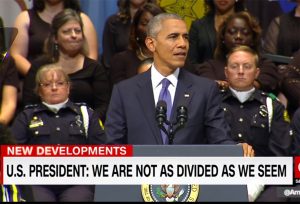
A big challenge — bold words delivered to an audience in mourning. He told us things we know, but things that are hard to hear while we’re in the middle of the suffering.
And he said, “The pain we feel may not soon pass, but my faith tells me that they did not die in vain. I believe our sorrow can make us a better country. I believe our righteous anger can be transformed into more justice and more peace. Weeping may endure for a night but I’m convinced joy comes in the morning.”
He reminded us of the promises made to Ezekiel I the old testament: “ ‘I will give you a new heart,’ ” the Lord says, ‘and put a new spirit in you. I will remove from you your heart of stone, and give you a heart of flesh.’ ” The President cited examples of those with such new hearts who had made progress possible, right here in Dallas. But still, we mourn.
Much earlier in my lifetime, a man I admired (who would not become president) stood on a street corner on the back of a flat-bed truck and talked about a terrible thing that had happened that day. Robert Kennedy told a small gathering of Africa Americans in Indianapolis that Dr. Martin Luther King Jr. had just been murdered. What was promised that day was wisdom, the same promise made to Ezekiel.
Quoting an ancient Greek playwright, Senator Robert Kennedy said,
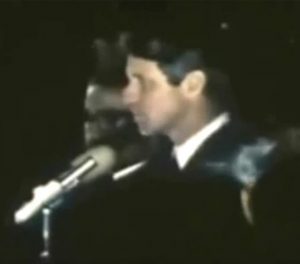
“Even in our sleep, pain, which cannot forget
falls drop by drop upon the heart until,
in our own despair, against our will,
comes wisdom
through the awful grace of God.
— Aeschylus
Paste into your browser and watch:
https://youtu.be/GoKzCff8Zbs
The pain that day did not go away, nor — as of this writing — has the promised wisdom arrived. In fact, two months later, June 6, 1968, two days before my high school graduation, Robert Kennedy was himself the victim of violent hatred. That was 48 years ago. And, across this nation, still we have not yet seen the wisdom nor the new heart.
What do we learn? If we’re paying attention, we earn that waiting for the wisdom and the new heart has not worked. I suppose that means that we have to do it ourselves, somehow. And, this week, we heard some suggestions – President Obama said,
“we can learn to stand in each other’s shoes and look at the world through each other’s eyes.”
And he said, “we can abandon the overheated rhetoric and the oversimplification that reduces whole categories of our fellow Americans, not just to opponents, but to enemies.”
And he said, “those protesting for change will guard against reckless language going forward.”
And he said, “police departments will acknowledge that, just like the rest of us, they’re not perfect. That insisting we do better to root out racial bias is not an attack on cops, but an effort to live up to our highest ideals.”
And he said, “we can worry less about which side has been wronged, and worry more about joining sides to do right.”
And, to bring us back to where he started, he said, “It turns out we do not persevere alone. Our character is not found in isolation. Hope does not arise by putting our fellow man down, it is found by lifting others up.”
These prescriptions for change sound simple. But, with the number of times we have tried to teach ourselves these lessons, and failed — that’s where the despair comes from — one can only hope that these things do not turn out to be impossible.
 BUT, if we can persevere, we have been offered hope. Also in my lifetime, we were given another list of prescriptions for change that seemed daunting in their time. On January 20, 1961, President John F. Kennedy confronted the nation with such a list and summarized the challenge this way:
BUT, if we can persevere, we have been offered hope. Also in my lifetime, we were given another list of prescriptions for change that seemed daunting in their time. On January 20, 1961, President John F. Kennedy confronted the nation with such a list and summarized the challenge this way:
“All this will not be finished in the first one hundred days. Nor will it be finished in the first thousand days, nor even perhaps in our lifetime on this planet. But let us begin.”
Maybe the success is in the starting, not in the finishing. I suppose the “us” these leaders spoke of must be assembled one person at a time. So, where do I start? Where do you?
What answers can we offer? Even if they see too small and the challenges seem too great, let’s say them right out loud. “… let us begin.”
Download a PDF of this article: ConVivio_Dallas_July14_2016
![]()
Grace
I do not understand the mystery of grace
— only that it meets us where we are
but does not leave us where it found us.”
— Ann Lamott
Seeking Harmony in a Tradition of Grace
On Saturday, December 12, Gretta and I continued our nineteen-year tradition by attending “A Cathedral Christmas.” It is an annual Christmas concert of the Men’s and Boy’s Chorus, orchestra, and pipe organ, at Grace Cathedral in San Francisco.
For us, the tradition is in the music — for the music is truly magnificent. Usually, the concert focuses on two principal themes:
1) the joy associated with the birth of The Child — represented by well-known Christmas carols in the first and third segments of the performance — and
2) the peacefulness settling over the ‘Holy Land’ and the world, associated with the hope for peace that The Child would bring – represented by classic choral and orchestral music performed with sweetness and passion in the concert’s middle segment.
The signature piece of the Grace Cathedral Music Ministry has always been a tune called “Sleeps Judea Fair,” by Hugh MacKinnon. Gretta and I always look forward to this tune, in the middle segment of the concert, as the highlight of the season. The lyrics and the slow, soft harmony of the voices recreate the joy and peace associated with the season.
Settling into our usual seats on the aisle of Row S, at the acoustic center of the cathedral — one of America’s premier acoustical rooms — the stained-glass figures of the saints all around the cathedral, contributed to the warmth, peace, and harmony that we, and they expected. I opened the printed program to read the list of musical pieces. I had to study it several times before I realized that “Sleeps Judea Fair” was NOT listed.
It was NOT listed!
“What’s that about?!” I said out loud. As the choir emerged to begin the concert, I said to Gretta, “I’m surprised just how distressed I feel that it’s missing.”
“Me, too” she said.
The first segment of the concert contained the familiar choral pieces we had come to expect – like John Rutter’s The Holly and the Ivy — and others we all recognize. When the Men’s and Boys’ chorus left the altar for an intermission, a lively string quartet created a clever medley of carols interspersed within Bach’s Brandenberg Concerto #3.
Then, after applause for the quartet, the singers and the organist returned for the middle portion of the program, the segment that traditionally conveys the message of peace and serenity culminating in their signature piece, “Sleeps Judea Fair.” But, since that piece was not listed in the program, we weren’t sure what to expect.
What followed was a shock. The three pieces in this segment featured, from beginning to end, harsh spasmodic cascades of unresolved dissonance, typical of the more unsettling 20th century compositions. The last of these, clearly difficult to perform, included a few moments that sounded like small eruptions of harmony attempting to make themselves heard above the all-encompassing harshness, only to be musically shouted down and drowned out by the grating dissonance, ending without resolution. The faces of the saints in the stained-glass windows seemed to show the strain, their colors pale in the fading light. Then, in the final segment, the sing-along tunes like “Hark, the Herald Angels Sing” completed the program, as always. As Gretta and I attempted to sing along after the jarring experience of the middle segment, I realized what they had done. I said to Gretta, “I get it.”
It was a harsh message: there is no peace and harmony this Christmas season — not in the city, not in America, not across the world, and certainly not in Judea and the countries that surround it in the Middle East. The choir could not sing their signature piece, “Sleeps Judea Fair,” because the message would have been a false one.
I get it. I don’t like it, but I get it. We are being instructed to look harder for peace and harmony — and, finding none, create some ourselves.
Looking for Moments of Grace in a Grim Year
As we walked out of the cathedral on that beautiful December evening, humanity being what it is, our world remained a place of suffering and danger. I certainly didn’t have to look far to find many sources of harshness and struggle.
- Suffering and terror emanate from in the Middle East (yes, even ancient Judea) and have spread across the world in the form of war and poverty.
- The US continues to be plagued by gunfire — gunfire enabled by American leaders, local and national, determined to keep as many guns in the hands of as many people as possible.
- Our “tough-guy” politics is demonstrating its penchant for keeping us fearful and divided and promises to get louder and cruder in the heat of a presidential race.
- While unemployment has declined, under-employment and low wages are increasing across a shrinking middle class in America.
- Individuals with dark skin or who speak with foreign accents or in foreign languages are made to feel increasingly unwelcome or, worse, in danger in their own neighborhoods.
- In our cities, an increasing number of homeless individuals and families, who have dropped out of the middle class, are no longer looking for work, just struggling to find help — some sitting on street corners here on Nob Hill hoping for a few bills dropped in their basket by people emerging from expensive holiday concerts.
Looking around at all of this, we can find plenty of reasons to be discouraged. But Americans have often defied logic and looked around for moments of grace during hard times.
Looking at the sky on Christmas Eve, while some were hoping for a glimpse of Santa Claus, a rare Christmas full moon provided me with moments of willful optimism. I asked myself, “Can I look up at the brightness, tune out the rancor, and find reasons to believe in humanity’s better attributes: humility, conciliation, kindness, dignity, reason?
But, you know, if we look, there are hopeful signs everywhere, right down here on the surface:
- World leaders met in Paris this past month to reach an agreement that may yet stop our steady march toward an uninhabitable planet. The agreement offers our “last best hope” for meaningful global action to avert catastrophic climate change; and 195 countries promised to grab it. Can we succeed with so many industrial-strength forces working against us?
Can we?
- Pope Francis, naming himself after an Italian saint with a message of humility and peace, chose to visit the Americas and shine a mass-media spotlight on that message. He challenged the wealthy and powerful (including Congress) in the name of the poor and the weak.
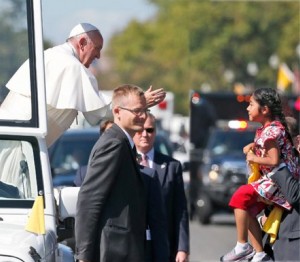
He prayed at ground zero and hugged a little girl who jumped a fence to approach his motorcade in Washington. Francis set a very public example of welcome for children, immigrants, the forgotten — asking us to follow.
Can we?
- Tens of thousands of refugees who fled their homes to escape the catastrophe in Syria found open doors and hearts in Germany and elsewhere. The response from some other nations continues to be fearful and inadequate, but the Germans sent a message to all of us that rebukes nationalist bigotry, defends human rights, and reminds countries like the US how to confront a humanitarian emergency. How long can they sustain it? In our own neighborhood, Canada has begun to follow the German example and may be teaching us how to respond as fellow humans. Is the challenge too big? Can we care for others on such a large scale?
Can we?
- This year, the US Supreme Court affirmed the marriage rights of same-sex couples who had been denied equal treatment under the law. Can our society accept them?
Can we?
- A bipartisan movement for criminal justice reform advanced in small steps, despite our ugly politics, asking “Can we find alternatives to mass incarceration and reduce the forces that sent so many Americans to prison?”
Can we?
- In neighborhoods long scarred by discrimination and police brutality, the Black Lives Matter movement spread a message of peaceable resistance. It is the method of that resistance that offers hope. Those small moments of progress are encouraging a similar struggle for a living wage for the lowest-paid workers in our prosperous land in a campaign for a $15 minimum wage. Small successes are emerging. Can we broaden those efforts across our workforce?
Can we?
- Dozens of states and cities, resisting vocal opposition, passed laws expanding rights and inclusion for undocumented immigrants, through driver’s licenses, legal services, and health care. Here in January, California has become the first state to forbid discrimination based on immigration status, language, or citizenship. Can we expand these moments of progress?
Can we?
In addition to these more visible, public efforts, some individuals led by example, opposing hatred and fear with compassion and courage in their own neighborhoods.
- Some Parisians opened their homes to strangers on the night of terrifying slaughter there.
- After a gunman’s rampage at an African Methodist Episcopal Church in Charleston, S.C., victims’ families publicly forgave the killer. The mayor said “A hateful person came to this community with some crazy idea he’d be able to divide us, but all he did was unite us and make us love each other even more.” President Obama sang a song (not among his core skills) at that South Carolina church — Amazing Grace. The congregation stood up and joined him and, a few days later, the Confederate battle flag came down at the South Carolina State Capitol. It was a symbol of a distinct piece of our American character that we cannot deny. Can we bring down more than just the symbols?
Can we?
Evil is everywhere; and anger and hatred are loud. The shouting and the dissonance can drown out the quiet voices and the moments of harmony, even in Grace Cathedral. Tragedy and disaster can block our view of goodness. Yes, it can. And yet, there are signs of progress toward a better future. We need to look carefully for those signs, or we may miss them. Better yet, can we create more of those signs of progress for others to see?
Can We?
After seven years, I haven’t forgotten the words, “Yes, we can.”
But, as I look at the state of the nation and the world here at the start of 2016, it is clear that the “We” in that optimistic phrase has not been enough. Could it be that the era of reliance on “We” is coming to an end? Perhaps it must begin with “Yes, I can.”
Can I?
What can I do, as an individual, to make a difference? Since “grace” does not seem to be emerging from the “We” of national and international institutions, I suppose it is going to have to begin with me.
But How? I suppose there are lots of options. What do I need to do?
Maybe I can start by contributing to organizations that do the work I can’t do on my own — some of our favorites: Planned Parenthood, Reach Out and Read, Boys and Girls Clubs, Sierra Club, Yosemite Conservancy, Valley Humane Society, American Civil Liberties Union, KQED, The Kidney Foundation, Hillary for America. All are hopeful efforts.
It’s not enough; but it’s a start.
Download a PDF of this post: Grace_Dec15_ConVivio_Jan9_2016_v2
Mister Kitty is the boss, and he knows it
MK Issues Mixed Approvals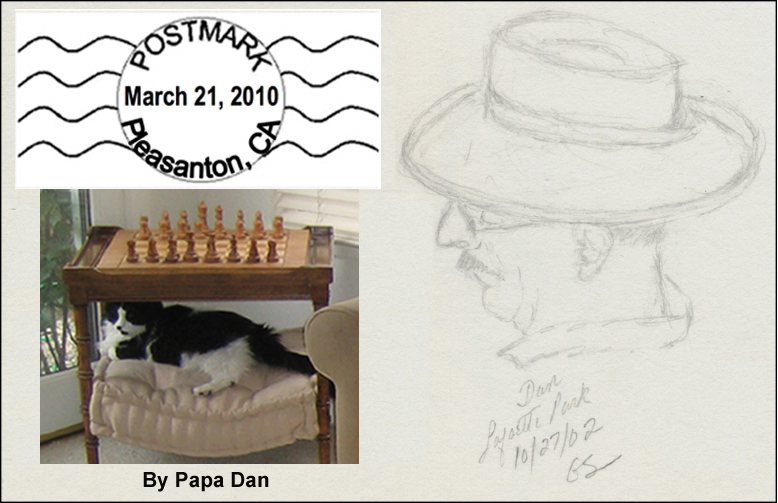
He owns the place. We are responsible for his comfort and well-being; and he is in control of . . . well . . . everything else, including, evidently, the turning of the seasons and this nation’s most important national decisions.
Mister Kitty knows that the entire reason we earn a living and maintain a household is to keep a roof over his head, keep his food and water bowls filled, maintain a clean kitty-litter box, provide a multitude of places for him to curl up and rest when he needs to, and to brush his fur when he wants it brushed. He also knows that, in order for him to feel fulfilled and complete as a Cat, everyone around him must be busy doing things —approved things, that is. The activity around him makes him feel the sense of accomplishment and superiority that he knows is his birthright.
Example — this month we have initiated three projects in parallel, hoping to elicit his approval and supervisorial support:
Project Number One: a trench for a gas line had to be dug from the gas meter in the front yard, under the walkway and gate, all the way around the side of the house, under the bricks to the back of the house directly behind the fireplace. As a result, stepping stones, a rock pathway, and a piece of sidewalk had to be dug up, moved, and set temporarily aside. Then, once the trench was dug, the gas line was laid in the trench to be connected to the envisioned gas fireplace. All of this met with Mister Kitty’s approval because it took place outside of the house where none of his resting spots were disturbed. He liked the fact that people were working hard just outside his field of vision where he could hear them grunt and cuss with exertion and frustration. He liked that because it appealed to his sense of management and authority that such an activity was conducted in a location he had approved (i.e., elsewhere) and physical burdens were placed on the right individuals (i.e., not him). He was able to select a place to rest from which he could supervise without having his routine disrupted.
Project Number Two: After the gas and electrical connections were completed and inspected, catalogs and brochures were studied, and a gas-burning fireplace insert was selected at a local store. This met with mixed approvals. The research was acceptable, consisting as it did of page-turning, measurement, and conversation — approved activities. MK also seems to support the environmental aspect of the project — eliminating the negative air-quality impacts of burning wood in the fireplace.
However, bringing the gas and electrical supply lines into the fireplace was another matter entirely. This aspect of the project required noisy power equipment to be utilized inside of his house. This did not meet with Messr. Kitté’s approval, evident by his disappearance under the bed for the duration of the work. Several hours after the noise stopped and the intruders had been dispatched, Mister Kitty made known his disapproval with the familiar yowls that generally accompany such objection. Other inhabitants of the house waited in fearful anticipation for possible retributive consequences that often consist of multiple, reverse post-digestive deposits made in the most visible and well-traveled portions of the white carpet.
Project Number Three: Plans were made to replace the white carpet with red oak hardwood floors on the bottom story of the house. Estimates were solicited, samples were compared, measurements were taken, and a specific product selected to maximize the efficiency of the work yet to come and minimize the effect on his schedule. Mister Kitty is generally supportive of the quiet, non-violent activity and expressed no noticeable disapproval, sitting at a safe distance and watching with interest. There is much concern, however, throughout the household that, when Project Number Three moves from the planning to the implementation phase, the expected levels of cutting, removal, banging, clatter, and general riotous behavior expected from the hardwood floor installers will yield extreme consequences resulting from strong disapproval. Bedspreads, couches, and other stainable surfaces elsewhere in the house are considered to be in serious jeopardy.
Suspecting as we do that His Eminent Kittiness may have unphyisical powers at his disposal, we may have already begun to experience a preliminary act of retribution for, at least, the offensive aspects of Project Number Two. We are all but convinced that MK is responsible for the fact that, now that the fireplace is fully installed and ready for operation, the past three days have been the three warmest days of this year, making the use of the fireplace unreasonable. So, today, Mister Kitty is sitting on his throne (pictured at the top of this essay), with a superior expression on his face, satisfied that he is responsible for the fact that we sit staring at the darkened fireplace, with doors and windows of the house open, trying to mitigate the effects of such warmth. The fact that today is the first official day of Spring is surely a mere coincidence.
By the way, after a day of sitting in front of C-SPAN on television, watching the workings of the House of Representatives, Mister Kitty — a Democrat — has expressed his approval of the passage of the Health Care Reform legislation as the first step toward restoring justice to the availability of health care in this nation. MK feels a close affinity with that other “MK,” (Dr. Martin King) who said many times that equal access to affordable and quality health care is an important attribute of a society on which the justice of that society must be properly judged. If it can be made true that any boy or girl can be born in this country and live in a family whose access to health care is assured and does not put their economic survival at risk in the event of an illness or accident, Mister Kitty can sit on his cushion with pride in his country and optimism for its future. Recognition that today’s events represent only one step toward that goal — an essential step, but only one of many — is an example of his inherent wisdom.
Found Maria, Still Looking for Antonio — An Update
 Our recent story of the migration of my grandparents, Antonio and Maria, from Southern Italy a century ago has generated a fair amount of discussion. Piecing together their journey has been like assembling a jigsaw puzzle with several pieces missing. That first picture was assembled from fragments — sketchy stories from sources living and dead, old photographs, and a sprinkling of facts. Since that first story appeared, we now believe we can paint a clearer picture of when their journey happened, how it happened, and why. The following is ‘Version #2’ of that story based on some renewed recollections, adjudication of some contradictory stories, new online research, and a little luck. One central piece of the puzzle remains lost and I’m still looking.
Our recent story of the migration of my grandparents, Antonio and Maria, from Southern Italy a century ago has generated a fair amount of discussion. Piecing together their journey has been like assembling a jigsaw puzzle with several pieces missing. That first picture was assembled from fragments — sketchy stories from sources living and dead, old photographs, and a sprinkling of facts. Since that first story appeared, we now believe we can paint a clearer picture of when their journey happened, how it happened, and why. The following is ‘Version #2’ of that story based on some renewed recollections, adjudication of some contradictory stories, new online research, and a little luck. One central piece of the puzzle remains lost and I’m still looking.
In our imagination, let’s rewind the story of Antonio and Maria, not back to the beginning quite yet, but back to a time and place where we have recently ‘found’ Antonio’s family. The date is August 18, 1910. On this day, we meet Maria with her two sons — twelve-year-old Giovanni (John) and four-year-old Giuseppe (Joseph). We find them on a ship called The Regina d’Italia, on the last day of a voyage that took them from Naples, across the Mediterranean, through the strait of Gibraltar, and across the Atlantic. Since they were below-decks in steerage, they were unable to watch the approach of a 23-year-old Statue of Liberty as they entered New York Harbor. It wasn’t until the ship docked at Ellis Island that they were able to climb up the stairs to the main deck and get their first look at the ‘Lady in The Harbor,’ who had invited them.
So, how do we know for sure that they were on that boat on that particular day?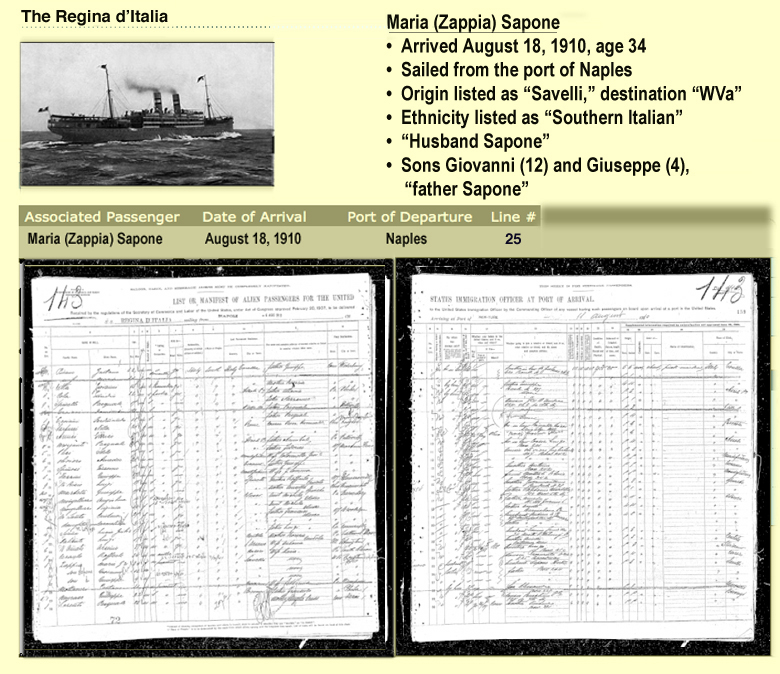
On line 25 of the passenger list for the Regina d’Italia for August 18, 1910, we see something that we had not seen before when searching under Maria’s married name. Under her maiden name, we find three pieces of information that confirm that this is ‘our’ Maria:
1. “Zappia, Maria G.” — Her point of origin was listed as the village of Savelli, consistent with my Aunt Isabel’s story, and her age, 34, is the right age for ‘our’ Maria. She was born in 1876.
2. On the facing page, we see the annotation “Husband Sapone” — this is ‘our’ Antonio, but he is not a passenger on this ship. This is consistent with Isabel’s disputed story that Antonio came to American first.
3. Beneath this entry, on lines 26 and 27, the clincher: we see listed her two sons, Giovanni (Age 12) and Giuseppe (age 4) — father’s name: Sapone. They are the right age and have the right names, traveling with their mother whose name was listed as Zappia. — ‘our’ Maria’s maiden name.
The ship, by the way, had room for 120 1st-class passengers and 1,900 in ‘steerage (where Maria and the boys traveled). Coincidentally, The Regina d’Italia served as a hospital ship after the earthquake at Reggio/Messina.
Still Looking for Antonio
So, now we get to the tough part of the story. It has become clear that my grandfather did not arrive at Ellis Island on the Konig Albert on April 27, 1910, as previously reported here. A closer look at the hand-written passenger manifest shows four problems: for this ‘Antonio,’ the closest living relative in the country of origin was listed as his wife, “Mirolina”; it names his destination was “Pittsbugh, Pa”; and it states that he had previously been to that city. So, none of the passengers I have found in this database so far with my grandfathers name match what we now about ‘our’ Antonio.
We do have some evidence that may enable us to close in on him. Since we know that Maria gave birth to my father, Albert (Umberto) on October 10, 1910, in Red Jacket, West Virginia, we know that she was seven months pregnant during this 12-day voyage across the Atlantic on The Regina d’Italia! That fact also dictates that, if Antonio was Albert’s father, he had to have sailed to America no sooner than January of 1910 (in order to have been on the right side of the Atlantic to have participated in his conception).
What Next?
The Ellis Island database has some new search features and there are other sources to explore. We are still looking for answers:
- When did Antonio sail, from which port, and on what ship?
- What can we learn about their three-year life in West Virginia?
- What more can we learn about their life in California before Antonio’s death in 1927?
So, I have more work to do — the search continues.
![]()
Looking Back One Hundred Years
‘When’ and ‘Where’ Are Easy, But ‘Why’ and ‘How’ Are Tougher
One hundred years ago — 101 to be exact — my grandfather Antonio, and his wife Maria, left Reggio Calabria, at the toe of Italy’s boot, sailed out of the Mediterranean, crossed the Atlantic, entered New York Harbor, and landed on Ellis Island to begin a new life in America.
By itself, this is not an unusual story. Tens of thousands of Italian immigrants made the same journey during the first decade of the 20th century, many more from Southern Italy than elsewhere. The population of Italian immigrants on the eastern seaboard of America, notably New York and Boston, swelled to a point where, in 1910, more native Italians lived in New York City than in the Italian cities of Florence, Venice, and Genoa combined. A popular expression in Southern Italy was: “Chi esce riesce (He who leaves succeeds).”
I had heard bits and pieces of the story all my life — how Antonio, who was illiterate in two languages, couldn’t make himself understood well enough to communicate his own name. When the only job he was able to get was in a coal mine in Red Jacket West Virginia, he was known, and paid, as Tony Sabo. My father and his brothers later learned that wasn’t their name.
He had been part of a Calabresé family who grew citrus and grapes and made wine and, apparently came to America to do the same. According to the family story, Antonio was at a grocery store in Huntington — the town next to Red Jacket — depressed that he had left behind farming and wine-making to work in the coal mine, asked the Italian-speaking shopkeeper, “Where did this orange come from?” The answer determined his future and the future of my father, myself, my sons, and their children. The shopkeeper said, “California.” Antonio replied, we are told, “I am going to California, my boys are not going to grow up in the coal mine.” So, Antonio moved his wife and three sons to the southern end of the Santa Clara Valley — Morgan Hill — where he became a share cropper, grew oranges and grapes, and made wine. It was 1912.
By the 1920s, with prohibition in full swing, Antonio was living his dream (right). According to the story passed down to me, people came from miles around to buy his high-priced oranges, but he gave the wine away for free. By 1925, his youngest son, Umberto (Albert, who would become my father) was fifteen.
So, Antonio — all four-foot-ten of him — had gotten himself to California. Curiously, though, Antonio did not fit the pattern of the historic wave of Italian immigration he had joined. Many came to America to escape poor economic conditions in the south but, according to reporting at the time and more recent scholarship, most came as migratory workers, intending to stay only long enough to take advantage of high-wage (for them) city jobs, send money home, and return to Italy wealthier than when they left. In fact, 20-30% of immigrants from Southern Italy during the period 1890-1924 did just that. Most came to America without their families. Many others eventually ended up staying, sent for their families once they had found stable big-city jobs, an made significant contributions to the cultural fabric of American cities. But fewer came here to pursue lives similar to what they left behind.
The Questions
So all of this has stimulated some puzzling questions. Why did Antonio not fit the pattern? Why did he not settle in the city to work as so many others had done? If his goal was to be a farmer and winemaker, why did he end up in a coal mine in West Virginia for three years? Why did he travel to the other side of the North American continent to grow grapes and oranges and make wine, when he had already been doing that in Calabria? What sent him half way around the globe to make a life exactly like the life he left behind? Why? Nobody had answered that question to my satisfaction . . . until my nephew Joe (‘Joe III’ in the comments) did some digging on the Internet and learned something that none of us had heard before. I think it may shine some light on some of the questions: why he came to America early in 1909, how he got here, and why he stayed.
The Disaster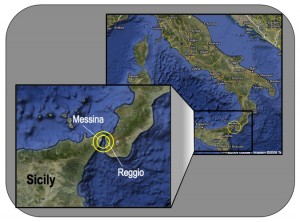
In 1909, J. Martin Miller, published a contemporaneous account of what he called “a disaster more awful and far-reaching than all of Nature’s disasters combined during the century preceding this one.” The cover of his book displayed a long and melodramatic title: The Complete Story of the Italian Earthquake Horror — The World’s Greatest Disaster — Death and Ruin By Earthquake, Tidal Wave, and Fire. His account, still credible after 100 years of analysis, was that more than 200,000 people died in Reggio and Messina, on either side of the Straits of Messina where the earthquake was centered.

Rescuers turned attention to the living, leaving the burial of the dead until the arrival of more help (Miller)
Some Answers
So what does this historic disaster have to do with my questions? Antonio did not seek out the big-city jobs that so many Italian immigrants pursued because be was not qualified — he was an illiterate farmer who couldn’t write his name. So, what future did he think he would have here? He brought his young family, even though he could only get work in a coal mine, because he had no intention of returning home to Italy . . . because there was no home to return to! The entire area around Reggio Calabria was utterly destroyed on December 28, 1908, in the 7.5-magnitude earthquake. The entire region was rubble on both sides of the Straits of Messina. According to Miller’s reporting, thousands of bodies were strewn about unburied for weeks, causing additional thousands to die of disease. All the buildings they had known were flattened. From his point of view, the home he knew no longer existed.![]()
===================================
Epilogue — How Much of This Story Is True?
The details of the earthquake of December 28, 1908, are well documented. Type into Googgle ‘Reggio, Calabria, Messina, earthquake’ and you will find a wealth of detail and the dramatic reactions from around the world at the time, including international rescue efforts much like those taking in place in Haiti today. The contemporaneous Miller book (shown at right), while overly melodramatic in the journalistic style of 1909, is full of details that reflect the reporting from that time and place and dozens of photos that provide some vivid context for understanding the magnitude of this disaster.
The details of the life of Antonio and Maria are accurate in the general outline — not much more is known. However, the feelings and aspirations that drove them — except perhaps for his reaction to the piece of fruit he found in a grocery store in Huntington — can only be surmised. Their generation and their children’s generation in our family are mostly gone, those who remain recall that they never talked much about what happened before ‘the crossing.’ When I was growing up, I heard from my parents that Grandpa “was an orphan.” When asked for details, my aunt Kitty (fourth child of Antonio and Maria, born in West Virginia after my father) told me a summary of what she had heard: “Half the town died,” she said. “All of his family died but him and all of her family died but her. So, they got on a boat and came to America.” When I asked my mother, she said only, “It must have been something like malaria.” Another aunt, Isabel, told me that she thought Antonio had come first and Maria and the two boys came later.
As I’ve researched this story, one problem has been a nagging disappointment. I studied a great resource for families of immigrants — the Ellis Island Foundation website (http://www.ellisisland.org). This terrific service allows you to search passenger lists, and even view the actual hand-written ship manifests, of commercial ships that brought immigrants to the US. We know that Antonio and Maria came to America by ship by 1910 (since their third son, my father, was born in West Virginia in 1910), but I have found no entries on any of the passenger lists of those ships that could have been ‘our’ Antonio, in either 1908, 1909, or 1910. His fairly common first and last name appeared 25 times, but all were the wrong age, came from the wrong parts of Italy, in the wrong years, and with other ‘wrong’ details. The closest match was one Antonio with the right last name who came from Montebello (500 miles to the north) in April of 1909, departed from Naples, was too young to have a nine-year-old son (and too young to have died in 1927 at the age of 56), and identified his marital status as single. Why is ‘our’ Antonio missing from those ships? I’m still working on a hypothesis. Conflicting stories will have to be sorted out. It will have to remain a work in progress for now.
🙂 I hope everyone who is interested in this story will read the ‘Comment’ below from my nephew Joe III. From his own research, he has added significantly to the story; and I appreciate his input tremendously.
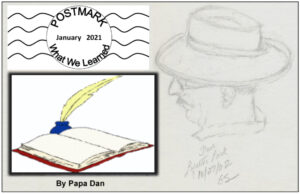



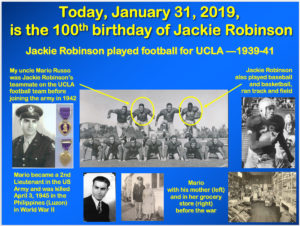
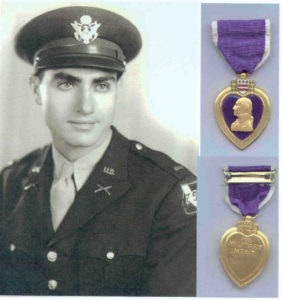
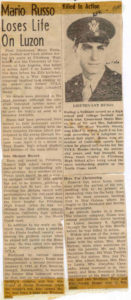




 We’ve been taught to hope by people with a lot of experience.
We’ve been taught to hope by people with a lot of experience.

